
Nature
art and culture in the Green Tuscany
Insieme per un futuro più verde Together for a greener future




Nature
Insieme per un futuro più verde Together for a greener future


Il giardino nel quale viene presentato anche questo numero di NATURART assume, anno dopo anno, una rilevanza diversa; il parco allestito per pochi giorni nel centro storico della città di Pistoia, all’interno del quale si tornerà a parlare anche della nostra rivista, prende, edizione dopo edizione, un valore più profondo.
Resta sicuramente un evento che promuove la città e che attira, nella doppia cornice di Piazza della Sala e di Piazza del Duomo, migliaia di visitatori; mantiene intatta la sua finalità di stimolo, affinché le città d’Italia e del mondo curino il proprio verde e lo incrementino. Ma, sempre di più, diviene un’occasione per riflettere sulla necessità di un rapporto diverso con la natura e con la terra sulla quale – oggi e temporalmente – ci troviamo a vivere.
La rilevanza diversa e il valore più profondo di “Un altro Parco in città” sono legati alle iniziative promosse in occasione dell’evento (laboratori, momenti di dibattito e di discussione) ma vengono anche favoriti dall’uscita di un fascicolo di NATURART che, senza trascurare l’arte, la storia del territorio, le manifestazione che nei prossimi mesi si svolgeranno nella Toscana del nord, prosegue in maniera decisa nella direzione di promuovere un diverso equilibrio tra noi e il mondo, che guarda ad esperienze di vita capaci di indicare possibili vie alternative a quelle del mero consumo, che dà spazio ad una lettura dei territori da una prospettiva artistica, che guarda – come sottolinea per esempio l’articolo di Stefano Mancuso che siamo felici di poter pubblicare – al mondo delle piante come a un modello di vivere cooperativo e non competitivo. In termini agricoli e botanici, potremmo dire che NATURART vorrebbe essere un seme, anche di speranza: un seme piccolissimo e fragile, ma che comunque non rinunciamo a interrare.
The garden in which we are presenting also this issue of NATURART assumes, year after year, a different relevance: the park arranged for a few days in the old town of the city of Pistoia, within which we will also talk again about our magazine, assumes, edition after edition, a deeper value.
It definitely remains an event that promotes the city and attracts thousands of visitors in the dual setting of Piazza della Sala and Piazza del Duomo: it maintains intact its purpose of encouraging the cities of Italy and the world to take care of and increase their green areas. But it’s becoming more and more an opportunity to reflect on the need for a different relationship with nature and the Earth in which – today and temporarily – we happen to live. The different relevance and the deeper value of “Another park in the city” are linked to the initiatives promoted on the occasion of the event (laboratories, moments of debate and discussion) but are also favored by the release of an issue of NATURART that, without neglecting the art and history of the territory and the events that will take place in Northern Tuscany in the next few months, firmly moves towards promoting a different balance between us and the world and looks at life experiences which are capable of showing potential alternative paths to those of mere consumption. It makes room for an analysis of territories from an artistic perspective and looks – as underlined, for example, by Stefano Mancuso’s article, that we are glad to publish –” at the world of plants as a cooperative, rather than competitive, way of living. In agricultural and botanical terms, we may say that NATURART would like to be a seed, also of hope: a very small and fragile seed, and yet we’re not giving up on planting it.
EDITORIALE
Giovanni Capecchi Direttore Editoriale Managing Editor
g.capecchi@discoverpistoia.it

Il progetto educativo dei servizi per la prima infanzia e delle scuole dell’infanzia del Comune di Pistoia mette al centro la partecipazione delle famiglie ed il dialogo costante con il territorio per dare vita ad una comunità educante reale, risonante.
Il personale è costantemente sostenuto da percorsi formativi che hanno il senso di allargare lo sguardo, di condurre oltre gli ambiti consueti dell’agire educativo, di tenere insieme saperi, capacità e competenze, riflessione e consapevolezza.
I servizi educativi prima di pensare ad occasioni per i bambini e le famiglie nella città creano di contesti buoni dove i bambini sono protagonisti e la famiglia viene ascoltata, che sono visitati da anni da delegazioni provenienti da tutto il mondo. Da questa quotidianità condivisa è stato possibile e meravigliosamente articolato immaginare percorsi/ opportunità/eventi vicini al sentire dei bambini delle famiglie e della comunità. Non si tratta di realizzare eventi una tantum, occasioni sporadiche, ma vere e proprie ritualità capaci di essere buone, preziose per creare una rete di relazioni, una comunità. Una progettualità che prova ad essere promotrice di una cultura dell’infanzia, ma anche di una cultura delle Famiglie nella città. Accanto ad occasioni in cui i servizi si sono aperti alla città, il coordinamento pedagogico ha pensato ad ulteriori progetti che escono dai Servizi per essere vissuti dentro la città. Con tali opportunità i bambini e le famiglie assaporano esperienze collettive, che allontanano il senso di isolamento o il timore ad essere soli e inadeguati, al contempo accrescono la fiducia in se stessi, alimentano il senso di appartenenza e un benessere che nasce dall’essere insieme. Citiamo ad esempio il programma “Infanzia e Città”, alla sua X edizione, in collaborazione con i Teatri di Pistoia, da anni pone all’attenzione della città l’infanzia e il suo rapporto con essa e la comunità, offrendo, per un intero mese, occasioni di incontri, laboratori, spettacoli, musica, lettura.
Altre progettualità importanti sono state sviluppate dai servizi educativi con Giorgio Tesi Group da “Cosimo degli alberi”, a “Porrettana Express”, alla creazione di spazi verdi in alcuni servizi, caratterizzati tutte dalla condivisione dell’idea di infanzia e dal desiderio di creare una città a misura dei bambini e delle loro famiglie.
Per il prossimo anno educativo la sfida è di rafforzare e ampliare queste collaborazioni mettendole in dialogo, creando tempi e luoghi dedicati alla coprogettazione, partendo dalla programmazione di Infanzia e Città 2025 per andare ad individuare ambiti di sperimentazione dove esperienze e professionalità diverse possono dar vita a occasioni di crescita della comunità.
The educational project of services for early childhood and nursery schools in the Municipality of Pistoia focuses on the participation of families and the continuous dialogue with the territory, to create an actual and resounding educational community. The staff is continuously supported by training paths whose purpose is to broaden our vision, to go beyond the usual contexts of educational work and to hold together knowledge, skills and expertise, reflection and awareness.
Even before thinking of opportunities for children and families in the cities, Educational services create good contexts where children are the protagonists and family is listened to.
Such contexts have been visited, for years, by delegations coming from all over the world. Starting from this shared daily life, it was possible and wonderfully articulated to imagine paths/opportunities/events which are close to the feelings of children, families and community. It’s not about creating one-off events, sporadic occasions, but rather actual rituals which are capable of being good and precious to create a network of relationships, a community.
It’s a type of planning that tries to promote a culture of childhood, but also a culture of families in the city. Along with occasions where services have opened themselves up to the city, the pedagogical coordination has thought about further projects that go beyond the context of services to be experienced within the city. Thanks to such opportunities, children and families can enjoy collective experiences, which kick out the sense of isolation or the fear of being alone and inadequate and, at the same time, increase one’s self-confidence and foster the sense of belonging and a wellbeing that derives from being together.
We can mention, as an example, the “Childhood and city” program which has now reached its 10th edition, in partnership with the theatres of Pistoia and, for several years, has been bringing to the attention of the city childhood and its relationship with it by offering, for a whole month, opportunities for meetings, laboratories, shows, music and readings.
Other important projects have been developed by Educational services with Giorgio Tesi Group, starting from “Cosimo degli alberi” and “Porrettana Express” to the creation of green spaces within a few services. All of these projects are characterized by sharing an idea of childhood and the desire to create a city made to measure for children and their families.
The challenge for the next educational year is to expand and widen these partnerships by establishing a dialogue between them and creating times and places dedicated to co-planning, starting with the planning of the 2025 edition of “Childhood and city” and then detecting experimentation environments where different experiences and professionalisms can lead to opportunities for growing the community.
Benedetta Menichelli
Assessore del Servizio Educazione e Istruzione del Comune di Pistoia / Councillor for Educational of the Municipality of Pistoia
Federica Taddei
Dirigente del Servizio Educazione e Istruzione del Comune di Pistoia/ Head of Educational services of the Municipality of Pistoia


Prodotto da uve tenute ad appassire in fruttaio per alcuni mesi. L’uva viene poi spremuta ed il mosto così ottenuto elabora ed invecchia in caratelli di castagno e rovere per almeno tre anni come da secolare tradizione toscana.
Produced from grapes held to fade in a particular room for some months. The grapes are squeezed and the must elaborated and grows old in kegs of chestnut and oak for three years according to the secular Tuscan tradition.

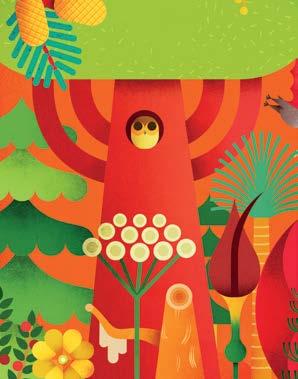
Illustrazione di Philip Giordano contenuta nel libro IL FAVOLOSO MONDO DELLE PIANTE realizzato insieme a Stefano Mancuso per Aboca Edizioni collana Kids.
Illustration by Philip Giordano contained in the book THE FABULOUS WORLD OF PLANTS created together with Stefano Mancuso for Aboca Edizioni in the Kids series.
Giorgio Tesi Group The Future is Green

Giorgio Tesi Editrice srl
Via di Badia, 14 – 51100 Bottegone – Pistoia – Italy Tel. +39 0573 530051 – Fax +39 0573 530486 www.discoverpistoia.it
Iscrizione al ROC (Registro Operatori della Comunicazione) n° 30847 del 15 Gennaio 2018
Per la tua pubblicità sulla rivista contatta la Giorgio Tesi Editrice o invia una e-mail a marketing@giorgiotesigroup.it
ISSN 2421-2849
9 772421 284000
Direttore Editoriale
Giovanni Capecchi g.capecchi@discoverpistoia.it
Direttore Responsabile
Carlo Vezzosi carlo.vezzosi@legismail.it
Art Director Nicolò Begliomini n.begliomini@giorgiotesigroup.it
Coordinamento Redazionale
Lorenzo Baldi redazione@discoverpistoia.it
Segreteria
Carolina Begliomini, Irene Cinelli, Maria Grazia Taddeo contatti@giorgiotesigroup.it
Comitato di redazione
Leonardo Begliomini, Nicoletta Boccardi, Emanuel Carfora, Lorenzo Cipriani, Alessandra Corsini, Giuliano Livi, Martina Meloni, Paolo Paolieri
Hanno collaborato a questo numero
Giovanni Capecchi, Alberto Casadei, Stefano Mancuso, Barbara Boganini, Andrea Ottanelli, Lorenzo Baldi, Eleonora Angelini.
Traduzioni
Studio Blitz – Pistoia
Fotografie
Fondazione Pistoia Musei, Nicolò Begliomini, Alexey Pivovarov, Lorenzo Marianeschi, Archivio Piante Terra Festival, Barbara Leolini, Elsa Pizzutto, Claudia Mann, Francesca Renzi, Leonardo Bocci, Matteo Orani, Gabriele Fossi, Marco Lumini, Marco Farmalli, Archivio Un altro parco in città, Archivio Camerata Strumentale Prato, Archivio Giannino Giannini.
Per le immagini pubblicate restiamo a disposizione degli aventi diritto che non si siano potuti reperire.
Impaginazione Giorgio Tesi Editrice
Stampa Industrie Grafiche Pacini- Ospedaletto (Pisa)
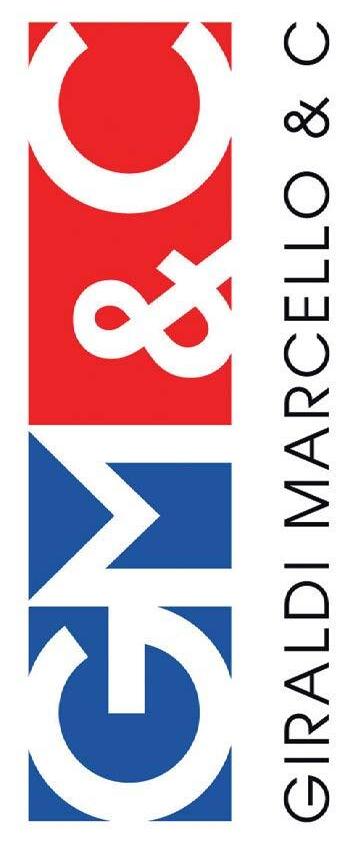
www.discoverpistoia.it













Folco Terzani A piedi nudi sulla terra
Barefoot on the Earth
Atlante
Pinocchio in ogni angolo del mondo
Pinocchio in every corner of the world
Stefano Mancuso
A lezione dalle piante
A lesson from plants
Verde, cibo e cultura
Sta arrivando
NATURART VILLAGE is coming
Pistoia e la sua identità
Il verde che unisce, rigenera, parla
The green that brings together, regenerates, talks
NATURART KIDS
Bambini ambasciatori del futuro
Children ambassadors of the future
Intervista a Luca Gori, Presidente Fondazione CARIPT Solidarietà, giovani, territori
Solidarity, young people, territories
Palazzo de’ Rossi | Collezioni del Novecento In Visita. Maria Lai
Camerata strumentale di Prato Laboratorio di armonia sociale Laboratory of social harmony
Valerio Ceccarelli
Omaggio ai fiamminghi
Homage to the Flemish
Libri - Lorenzo Cipriani
Rapporto uomo natura Visioni sul territorio
Visions on the territory
Immagini dell’Ottocento e Novecento
Pistoia: lo sguardo sulla città
Pistoia: a look at the city
Folco Terzani
— Il sole è già sorto da un pezzo quando arriviamo all’Orsigna, a casa Terzani. Siamo venuti per incontrare Folco, che ci aspetta in casa, seduto accanto al fuoco acceso: un fuoco con la fiamma bassa, che riscalda e che è una presenza viva, da seguire e alimentare, con la quale mantenere un rapporto intimo e di dialogo...
SFoto
Nicolò Begliomini
Alexey Pivovarov
00A GALLERY
iamo venuti per parlare di Tiziano, il grande giornalista che ha percorso e raccontato i fronti di guerra asiatici e che ha poi scelto di concludere la sua vita proprio tra queste montagne; ma ci interessa soprattutto incontrare Folco, farci raccontare le sue giornate, le sue riflessioni sul mondo in cui viviamo, le idee alle quali è approdato nel corso del cammino che continua a proseguire. Seduti accanto a lui iniziamo ad ascoltarlo: “Qua siamo sul pianeta terra, sotto il sole, sotto le stelle. A Firenze non riesco a vivere: sono costretto a passarci alcuni periodi dell’anno, anche perché i miei figli vanno a scuola, ma non capisco la vita di città, in mezzo alle leggi dell’uomo, che sono inventate. La libertà, per me, è stare nella natura. Mi alzo presto, quando canta il gallo, e guardo l’arrivo del sole. Nel corso della giornata, devo anche accendere il computer, dedicare una parte del tempo alla famiglia: ma cerco di concentrarmi sulle cose grandi che succedono nel mondo. Il sorgere del sole, appunto, e il suo tramonto. Il cielo stellato, lo scorrere dell’acqua del fiume nella quale posso lavarmi”.
Qua siamo sul pianeta terra, sotto il sole, sotto le stelle. La libertà, per me, è stare nella natura. a
La sua storia, Folco l’ha raccontata anche nella lunga introduzione scritta per il libro “A piedi nudi sulla terra”, pubblicato nel 2011 e ora ristampato.
È una storia di incontri e di ricerca. Ha studiato filosofia a Cambridge, ma non ha ricevuto, da questo studio, ciò che cercava; neppure la scuola di cinema a New York ha soddisfatto le sue aspettative. La visione di alcuni asceti incontrati in India quando aveva 9 anni ha lasciato un segno destinato a riemergere nel tempo. Dopo New York, ha realizzato un documentario su un monastero tibetano: e gli si è aperto di fronte un mondo diverso e nuovo. Anche il periodo trascorso con Madre Teresa di Calcutta, durato sette mesi, è stato



Folco Terzani all’interno della gompa, costruita seguendo perfettamente il modello tibetano, dove suo padre decise di trascorrere l’ultimo periodo della sua vita. All’interno ci sono ancora i libri sugli scaffali, un tavolino e uno spazio per cucinare. A destra padre e figlio durante un’escursione sui monti dell’Orsigna.
Folco Terzani within the gompa, built by perfectly following the Tibetan model, where his father decided to spend the last period of his life. Indoors, there are still books on shelves, a table and a space for cooking. On the right, father and son during an excursion to the mountains of Orsigna.
importante per lui. In “A piedi nudi sulla terra” ha scritto: “Ho sentito nostalgia di un altro modo di vivere”. E questo altro modo di vivere, che gli hanno mostrato i Baba tibetani, con i quali ha camminato sull’Himalaya, cerca ora di metterlo in pratica. “Non è più tempo di scrivere o di discutere su ciò che è stato scritto. Mio padre, per esempio, ha detto e scritto cose che condivido
pienamente. La mia vita la sento in continuità con la sua. Lui è venuto a morire qua ad Orsigna, io ci sono venuto a vivere. Ora però, più che le parole, contano le scelte concrete. Qua ad Orsigna, e chissà in quante altre parti d’Italia simili a questa, si vive in mezzo alla Natura, si riducono al minimo le esigenze, si va verso l’essenziale”. Un cammino verso l’essenziale Folco ce lo mostra anche facendoci

vedere i due spazi nei quali Tiziano ha trascorso l’ultimo periodo della sua vita. Nella prima gompa, costruita seguendo perfettamente il modello tibetano, ci sono ancora i libri sugli scaffali, un tavolino, uno spazio per cucinare; nella seconda, nella quale concludere il cammino terreno, c’è solo un letto, per dormire e stare seduto, dal quale guardare l’orizzonte e i monti, dal quale allungare una mano per sfogliare un unico libro sul leggio o prepararsi un tè. Ma ce lo racconta, questo cammino, anche attraverso la propria esperienza: “La prima volta che sono arrivato in India da adulto ero equipaggiato alla perfezione, avevo uno zaino, la borraccia, le scarpe da montagna appena comprate; i monaci che incontravo, invece, non avevano niente e camminavano a piedi scalzi. O ero pazzo io o erano pazzi loro.
Ho capito che si può fare senza ciò che riteniamo generalmente necessario: loro sono sempre pronti a partire e a mettersi in cammino perché non hanno bagagli da portare, non possiedono niente, si affidano alla Natura e si fidano di lei”.
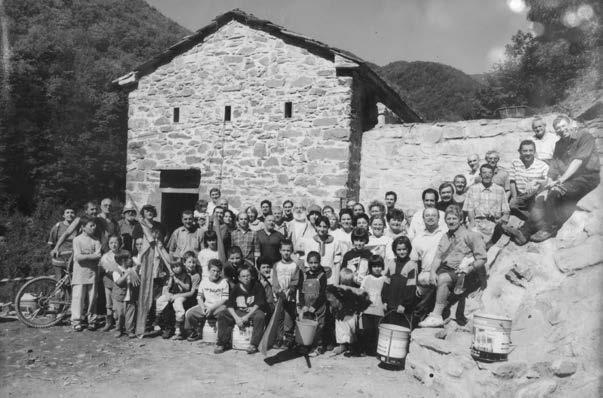

Ci sono anche i compromessi da fare, naturalmente. Alcuni impegni da rispettare. Le email alle quali rispondere, visto che – per ora – la lotta contro il cellulare la sta vincendo lui, che non ne possiede uno e che quindi non è preso nel vortice delle chiamate e dei messaggi whatsapp. Con Elio Germano stanno facendo uno spettacolo, che presenta proprio il modo di vivere dei Baba tibetani. Il 20° anniversario della fine terrena del padre Tiziano lo porta a dover intervenire in incontri pubblici. C’è poi l’attività di scrittura, sempre più ridotta ma che tuttavia continua. Ma c’è soprattutto la convinzione della necessità di preservare gli spazi per la libertà. “Credo di essere un esperto di città, ho vissuto in tutte le più grandi città del mondo; vivendo in città, non capisci che fuori c’è un mondo più grande; le città sono costruite sulla terra, ma la terra sta sotto il cemento e rischiamo di dimenticarla. A me interessa la terra, ritrovarla, muovermi su questa a piedi nudi. Perché devo frapporre un pezzo di plastica tra il mio piede e la Madre Terra? L’universo è eterno, noi
facciamo parte di tutto ciò. Qua è più facile mantenere lo sguardo su questo: è invece difficile farlo in un appartamento in città, in una vita tra banche e supermercati”. Mentre parliamo, Ana Baba, che è venuto dall’India per trascorrere con Folco un periodo all’Orsigna, sta cucinando nella stanza accanto.
“Ana” significa “cibo”. Si affaccia a salutarci e si ritira in silenzio. Si alza dal letto anche uno dei figli di Folco, felice di affrontare una nuova giornata, senza programmi precisi: forse aiuterà Ana Baba in cucina, forse andrà per i boschi, forse prenderà l’autobus per andare a giocare a calcio a Maresca.
Ci sono molti gradi sulla strada del ritorno verso la Natura: è possibile vivere una vita diversa anche senza diventare asceti. L’esigenza di imboccare questa strada è oggi sempre più sentita: “Le persone, oggi, stanno sempre più male – riflette Folco –. Sono insoddisfatte, stanche. Corrono: ma per andare dove? Il futuro che ci mettono davanti interessa sempre meno: verso quel futuro sempre più persone non vogliono andarci”.

“Le
persone, oggi, stanno sempre più male – riflette Folco –. Sono insoddisfatte, stanche. Corrono: ma per andare dove? Il futuro che ci mettono davanti interessa sempre meno: verso quel futuro sempre più persone non vogliono andarci”.
Prima di ritornare verso Pistoia, guardiamo insieme i monti che ci circondano: sono come le pendici dell’Himalaya, spiega Folco; poi, sull’Himalaya, dopo queste pendici e dopo uno strato di nuvole, emergono le cime bianche, che sembrano navigare nel cielo. Non occorre andare troppo lontano per vivere in un modo diverso: “Qua –conclude Folco – si può fare questa vita, nel selvatico più che nel verde; non è più necessario andare in India o in Nepal”.
In alto, Immagini storiche con padre e figlio ritratti insieme. Folco sente la sua vita in continuità di quella del padre Tiziano, di cui condivide pienamente tante cose scritte o dette, compresa la decisione di andare a vivere ad Orsigna.
Above, Historical images with father and son portrayed together. Folco feels that his life is in continuity with that of his father Tiziano, and he fully shares several things that were said or written by him, including the decision to relocate to Orsigna.
Folco Terzani and Giovanni Capecchi, in the meadow in front of the house of Orsigna, during the meeting for the making of this article. Photo Nicolò Begliomini

Folco Terzani e Giovanni Capecchi, nel prato davanti alla casa di Orsigna, durante l’incontro per la realizzazione di questo articolo. FotoNicolò Begliomini



— Folco Terzani
The sun has been out for a while as we arrive to Orsigna, at Terzani’s house. We came to meet Folco, who’s waiting for us at home, sitting next to the fire lit; a fire with a low flame, that warms and is a living presence that should be followed and fed, and with which we should maintain an intimate relationship and dialogue…
We came to talk about Tiziano, the great journalist who crossed and narrated the Asian battlefronts and then chose to end his life among these mountains; but we’re particularly interested in meeting Folco and hearing how he spends his days, his reflections about the world in which we live and the ideas he developed throughout the journey that he’s continuing.
As we sit next to him, we start to listen to his words: “Here we are on Planet Earth, under the sun, under the stars. I’m unable to live in Florence: I have to spend some periods of the year there, also because my sons go to school, but I don’t understand urban life, in the midst

of laws that were invented by man. Freedom, for me, means living in nature. I wake up early, when the rooster crows, and I watch the arrival of the sun. Throughout the day, I also have to switch the computer on and dedicate some time to my family: but I try to focus on the big things that take place in the world, such as the sunrise and sunset, the night sky and water flowing in the river, where I can wash”.
Folco narrated his story also in the long introduction written for the book “Barefoot on the Earth”, that was published in 2011 and is currently reprinted. It’s a story of encounters and research. He studied Philosophy in Cambridge, but he didn’t get from such studies what he was searching for: the





Here we are on Planet Earth, under the sun, under the stars. Freedom, for me, means living in nature. a
film school in New York wasn’t able to meet his needs either. The vision of a few ascetics that he had met in India when he was 9 years old had left a mark that was meant to re-emerge over time. Following his stay in New York,
he worked on a documentary about a lamasery, and a new and different world opened up in front of him. Also the 7 months that he spent with Mother Teresa of Calcutta were important for him. In “Barefoot on the Earth”, he wrote: “I missed another way of living”. And now he tries to put into practice this other way of living, that was shown to him by the Tibetan monks, with whom he walked through the Himalaya.
“It is no longer time to write or talk about what has been written. For example, my father said and wrote things with which I fully agree. I feel like my life is in continuity with his life. He came to die here in Orsigna, and I came to live here. But now, what matters is concrete choices, rather than words. Here

in Orsigna, and who knows in how many other parts of Italy that are similar to it, you live in the midst of nature, needs are reduced to the minimum and you go towards the essential”. Folco shows us a journey towards the essential also by showing us the two places where Tiziano spent the last period of his life. In the first gompa, that was built by perfectly following the Tibetan model, you can still see the books on the shelves, a table and a space for cooking; in the second gompa, where Tiziano would end his earthly journey, there’s just a bed, for sleeping and sitting, from which he would watch the horizon and the mountains, stretch out his hand to leaf through a single book on the stand or make tea. But Folco narrates this
Ad Orsigna, e anche in molte altre parti d’Italia con le stesse caratteristiche, si vive in mezzo alla natura, si riducono al minimo le esigenze, e si va verso l’essenziale.
In Orsigna, and also in several other parts of Italy with the same characteristics, people live in the middle of nature, needs are reduced to the minimum and to the essence.


journey also through his own experience:
“The first time I came to India, as an adult, I was perfectly equipped: I had a backpack, the hiking boots that I had just bought, but the monks I would meet didn’t have anything and walked barefoot. Either I was crazy or they were.
I realized that you can do something without using what we usually deem necessary: they are always ready to leave and get in the way because they don’t have any pieces of luggage, they don’t own anything. They rely on Nature, and they trust it”.
Of course, you have to compromise. You have some commitments, and a few e-mails to reply to, since – for the time being – Folco is winning his war against mobile phones. In fact, he doesn’t
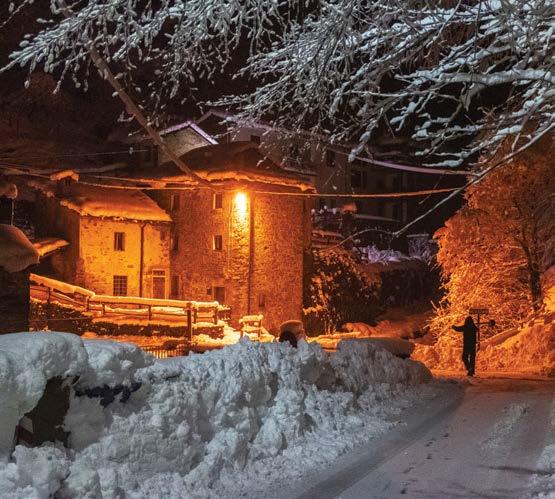
own a mobile phone and hasn’t been dragged into the vortex of calls and WhatsApp messages. He’s preparing a show with Elio Germano to present the way of life of Tibetan monks. Due to the 20th anniversary of the end of his father Tiziano’s earthly life, Folco has to attend a few public events. Then there’s his writing activity, which is more and more reduced, but is continuing. Above all, there’s the conviction of the need to preserve spaces of freedom. “I think I’m a city expert; I lived in all the biggest cities in the world, but when you live in a city, you don’t realize that there’s a bigger world outside. Cities are built on the ground, but the ground lies beneath the cement and we risk to forget it. I’m interested in the Earth, in finding it
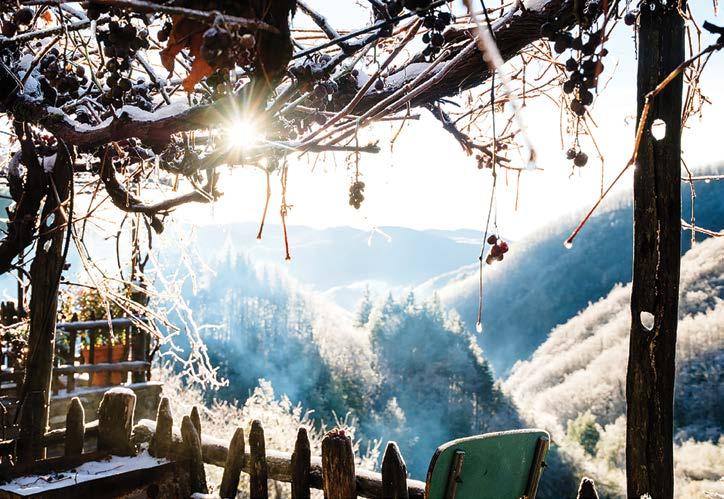
again, in moving barefoot on it. Why should I interpose a piece of plastic between my foot and Mother Earth? The universe is eternal, and we are part of it. Here it’s easier to keep your eyes on it, whereas it’s difficult to do it from an apartment in the city, in a life among banks and supermarkets”.
As we talk, Ana Baba, who came from India to spend some time with Folco in Orsigna, is cooking in the room nearby. “Ana” means “food”. He comes to greet us and quietly goes away. One of Folco’s sons gets out of bed, too. He’s happy to spend a new day without a definite schedule. Maybe he’ll help Ana Baba in the kitchen, maybe he’ll go to the woods, maybe he’ll catch the bus to go playing football in Maresca.



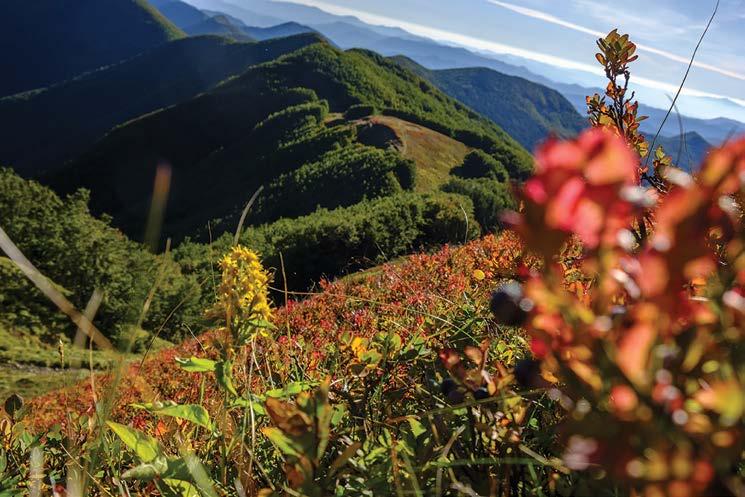

Cities are built on the ground, but the ground lies beneath the cement and we risk to forget it. I’m interested in the Earth, in finding it again, in moving barefoot on it.
There are several levels in this journey back to Nature: you can live a different live also without becoming an ascetic. You feel more and more the need to take this path: “Today, people are feeling worse and worse – reflects Folco – They are unsatisfied, tired. They run: but where do they go? The future they are putting ahead of us is less and less interesting: more and more people do not want to go towards that future”.
Before returning to Pistoia, we watch together the mountains around us. They look like the Himalayan foothills, explains Folco; then, after these foothills and a cloud layer, the white peaks emerge and they seem to navigate across the sky. You don’t need to go that far to live in a different way: “Here – concludes Folco – you can live this wild, rather than green, life: you no longer need to go to India or Nepal”.



A winter image of the “gompa” where Tiziano Terzani decided to spend the last period of his life.

Un’immagine invernale della “gompa” dove Tiziano Terzani decise di trascorrere l’ultimo periodo della sua vita.
Per Folco Terzani ci sono molti gradi sulla strada del ritorno verso la Natura: è possibile vivere una vita diversa anche senza diventare asceti e questa è oggi un’esigenza sempre più sentita…
According to Folco Terzani, there are several levels on the way back to Nature: we can live a different life also without becoming ascetics, and we feel this need more and more…

ogni regola, vivere senza denaro, rischiare la vita per vivere la libertà…
La storia di Baba Cesare, partito per l’India in cerca di una vera spiritualità. La vita di un uomo che inseguendo il piacere scopre la rinuncia. Un baba, un sadhu, è un uomo che ha rinunciato: la sua città è la giungla, il suo tetto è una grotta, il suo letto la terra, la sua acqua quella del fiume, il suo cibo le offerte spontanee. Il sadhu non vuole possedere niente, tiene acceso il fuoco, si dedica all’esecuzione dei riti che scandiscono la giornata in accordo con i ritmi della natura.

Ignoring any rule, living without money, risking your own life to enjoy freedom…
The history of Baba Cesare, who departed for India looking for true spirituality. The life of a man who discovered renunciation as he pursued pleasure. A baba, a sadhu, is a man who made sacrifices: his city is the jungle, his roof is a cavern, his bed is the ground, his water comes from the river, his food are spontaneous offers. A sadhu doesn’t want to own anything, he keeps the fire on, he commits to the execution of rituals that set his daily schedule in agreement with the rhythms of nature.
“A piedi nudi sulla terra” è un percorso di ricerca visto dal di dentro, con gli occhi di qualcuno che si è messo in gioco non per una settimana, un mese o un anno, ma per una vita. E, anche se la sua strada è stata paurosamente tortuosa, Baba Cesare - l’asceta italiano protagonista di questo libro -, dopo essersi ribellato a un’esistenza ordinaria, si è avvicinato al mondo dei sadhu indiani. Il suo percorso è molto diverso da quello che potremmo immaginare noi occidentali, abituati ai “processi di beatificazione” con i quali si cercano tracce di ascesi nelle vite di chi sfiora la santità. Dal mondo senza frontiere degli anni Settanta, attraversato dai magic bus che portavano in India passando per la Turchia, l’Iran, l’Afghanistan, il Pakistan, il suo cammino di uomo avventuroso e assetato di vita ci conduce fino a oggi, alle nazioni chiuse e blindate dei nostri tempi.
L’incontro tra Folco Terzani e Baba Cesare dà vita a un libro unico - romanzo di avventure, viaggio spirituale, inchiesta su un mondo svelato nel suo fascino controverso, dialogo sul senso ultimo della vita -, le cui pagine possono essere lette come un imprevedibile mémoire, un postumo romanzo di formazione e insieme come un testo sapienziale dal passo umile ma rivoluzionario, in grado di cambiare il nostro modo di camminare per le strade del mondo.
Barefoot on the Earth is a research journey as seen from the inside, with the eyes of somebody who got out there not for a week, a month or a year, but for a lifetime. And even if his path was alarmingly tortuous, Baba Cesare – the Italian ascetic who’s the protagonist of this book – approached the world of the Indian sadhus after opposing to an ordinary existence. His journey is very different from what we could imagine as Western people, who are used to “beatification processes” with which we look for traces of asceticism in the lives of those who come close to holiness. From the world without borders of the 1970s, crossed by the magic buses that led to India while going through Turkey, Iran, Afghanistan and Pakistan, his journey as an adventurous man, who’s thirsty for life, brings us to today, to the closed and armoured nations of our time.
The meeting between Folco Terzani and Baba Cesare gives birth to a unique book – a novel of adventures, a spiritual journey, an investigation about a world revealed in its controversial fascination, a dialogue on the ultimate meaning of life – whose pages can be read as an unpredictable mémoire, a posthumous coming-of-age novel and, at the same time, a sapiential text which, at the same time, is humble but revolutionary and can change our way of walking through the streets of the world.



Un grande “Atlante” su tutte (o quasi) le traduzioni e le trasposizioni di Pinocchio nel mondo
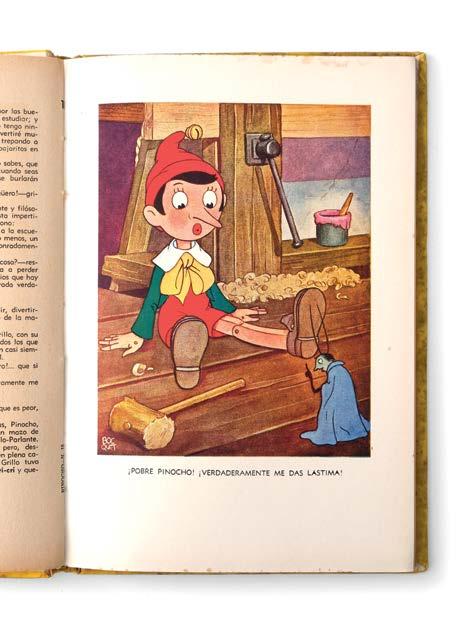
Che cosa comporta il tradurre “Pinocchio” nelle lingue e nelle culture di tutto il mondo? In primo luogo la possibilità di trasmettere una storia che riguarda uomini, animali (tantissimi nel libro di Collodi!), cose che si animano, come un pezzo di legno che diventa un burattinobambino. Siamo quindi nel regno del fiabesco, dove i confini tra i vari ambiti della realtà sono facili da attraversare, le metamorfosi sono continue, l’incredibile non esiste o comunque va superato. Ma ciò fa parte dell’immaginario folklorico di civiltà già antichissime e ancora oggi consente di comparare favole e fiabe diffuse in aree persino molto lontane, per arrivare a racconti di tribù nomadi ben precedenti a quelli ora attestati. Ecco quindi che un grande “Atlante” su tutte (o quasi) le traduzioni e le trasposizioni di Pinocchio nel mondo può consentire un’analisi molto interessante, innanzitutto di come vengono accettati oppure modificati aspetti che sono tipici del testo di partenza, ma possono risultare di difficile comprensione presso i pubblici di arrivo, specie fra i bambini. Però, nello stesso tempo, la storia nel suo sviluppo narrativo interessa davvero in tutto il globo, come spiega bene il curatore Giovanni Capecchi nella sua lucida e ricca “Introduzione”: le nazioni attuali che non hanno

mai avuto una qualche conoscenza di Pinocchio sono poche (collocate, e se ne comprendono le ragioni, specialmente nell’Africa australe), mentre si trovano attestazioni in territori assai remoti rispetto all’Italia, dal Sud America al Tibet. Prendendo proprio quest’ultimo caso come specimen dei 96 capitoli che compongono il volume, accompagnati da sei percorsi iconografici, si trova all’inizio un’introduzione alla lingua e alla cultura locale, utilissima per collocare al meglio le versioni di “Pinocchio”. Vengono poi indicate le caratteristiche di queste ultime, a volte numerose, altre una sola; spesso derivate da una buona conoscenza dell’originale ma in qualche circostanza mediate da ulteriori traduzioni (qui, quelle cinesi); alcune volte lasciate il più possibile con l’atmosfera collodiana, altre adattate alle forme locali di racconto fantastico-allegorico, nel contesto tibetano il “Gtam rgyud”. Ecco allora che il titolo generale dell’opera diventa la “Storia fantastica dell’Omino di legno”, e Pinocchio è “colui che commette errori”, Mastro Ciliegia il “Signor naso rosso” e così via. Ma se si leggono di seguito le accuratissime schede, divise per continente e approntate da 140 ottimi studiosi e studiose, si ricava davvero l’impressione di un grandioso mosaico che varia di continuo i colori delle sue tessere,
Un grande “Atlante” che comprende quasi tutte le traduzioni e le trasposizioni di Pinocchio nel mondo consente un’analisi molto interessante di come vengono accettati oppure modificati aspetti che sono tipici del testo originale, che possono risultare di difficile comprensione nel pubblico di arrivo, specie fra i bambini.
A big “Atlas” that includes almost the translations and adaptations of Pinocchio in the world, and allows a very interesting analysis of how a few typical aspects of the original text, that can be difficult to understand for the target audience (especially for children) are accepted or amended.
benché il disegno, la famosa silhouette di Pinocchio, resti la stessa. Certo, per citare Marco Baliani, che nel 2004 ha curato il celebre progetto teatrale “Pinocchio nero” con i bambini delle periferie di Nairobi, gli effetti locali possono essere molto diversi, per esempio se hai sentito tante storie di piante che si animano, e quindi non ti stupisci all’inizio del racconto collodiano, ma invece non hai mai avuto a disposizione cibo in quantità e il paese dei balocchi non sai nemmeno immaginartelo: quindi interpreti il finale come il riscatto di un personaggio colpito da tante sventure, e tuttavia trionfante e in condizioni positive. Il perbenismo che molti lettori italiani, persino d’eccezione come gli scrittori Luigi Malerba e Giuseppe Pontiggia, colgono nella conclusione di “Pinocchio” non è quindi considerato tale in contesti che attendono dalle storie la speranza di un miglioramento.
Peraltro le trasposizioni del capolavoro di Carlo Lorenzini non comportano soltanto una traduzione più o meno fedele. Spesso sono le immagini che accompagnano il testo a modificare la sua ricezione. Sotto questo aspetto, l’“Atlante” dimostra con sicurezza che un discrimine molto forte nella fortuna di “Pinocchio” è segnato dall’uscita negli Stati Uniti del film di Walt Disney nel 1940, arrivato poi, in anni anche parecchio

successivi, ovunque nel mondo. Se prima di quella data prevalgono le rielaborazioni dell’iconografia delle prime edizioni a stampa (molto importante quella originale di Enrico Mazzanti del 1883), in seguito le variazioni sono sempre più forti: mentre in molti casi si coglie la volontà di avvicinarsi alla rotondità e alla dolcezza del modello disneyano, in altri si accentuano invece le componenti più introverse e oscure del testo collodiano, che evoca spesso la morte e addirittura fa assassinare una prima volta il burattino nel capitolo 15, con la macabra impiccagione che doveva sancire la conclusione della storia, per fortuna superata dall’autore a grande richiesta del suo pubblico. E tuttavia anche lo strano disprezzo con cui il bambino Pinocchio, nel finale, guarda il sé stesso burattino, lasciato scomposto su una sedia, non può non colpire la fantasia dei disegnatori: in fondo, è come se si dovesse sancire la regolamentazione dell’Es, la parte ribelle che si coglie nell’inconscio, e poi magari nelle azioni di ogni essere umano, da parte di un Super-io che certo Collodi tende ad esaltare, con scopi pedagogici, e però non costituisce la parte più coinvolgente dell’opera. Semmai, come direbbe Ermanno Cavazzoni, Pinocchio resta un ‘miscredente’, che sa di dover agire in un certo modo ma poi fa il contrario, che inganna ed è ingannato, che fa il furbo però ha
un buon cuore, eccetera.

Oltre a questi preziosi materiali, che davvero rispondono alla richiesta di tanti studiosi e amanti di “Pinocchio”, ossia di avere a disposizione una mappa accurata della sua accoglienza in contesti culturali di ogni parte del mondo, l’“Atlante” fornisce notizie sulle tante rielaborazioni letterarie, teatrali, cinematografico-televisive, e ora anche in internet. Non mancano neppure i ricordi personali di come il burattino-bambino è stato recepito nella formazione di scrittori e

intellettuali: un esempio, per tutti, riguarda Antonia Arslan, che in un breve ma delizioso racconto rievoca il suo incontro con il “Pinocchio” ad Aleppo, con “le lettere dell’alfabeto armeno, complicate e seducenti come ricami, [che] danzavano come le rune di un misterioso linguaggio”. Un’immagine assai suggestiva che potrebbe fungere, in conclusione, come metafora del fascino e dell’incanto che il testo di Collodi, come dimostra questo prezioso “Atlante”, ha diffuso e diffonde in tutto il mondo.




—
That’s how a big “Atlas” on all (or nearly all) the translations and adaptations of Pinocchio throughout the world
What does it entail to translate “Pinocchio” in the languages and cultures throughout the world? In the first place, the possibility to convey a history that involves human beings, animals (there are so many of them in the book by Collodi!), things that come alive, like a piece of wood that becomes a puppet-child. Therefore, we are in the kingdom of fairytales, where the borders between different contexts of reality are easy to cross, there is a continuous metamorphosis and the unbelievable doesn’t exist or must be crossed. But this is part of the folkloric imagination of very ancient civilizations and, still today, it allows to compare fables and fairytales which are spread even in very far off areas, until
getting to the narrations by Nomadic tribes which date back to long before to those that are currently attested.
That’s how a big “Atlas” on all (or nearly all) the translations and adaptations of Pinocchio throughout the world can allow for a very interesting analysis, first of all of how typical aspects of the source text are accepted or amended, since they can be hard to understand for the target audience, especially among children. However, at the same time, the story and its narrative development are really of interest throughout the world, as explained by the curator Giovanni Capecchi in his clear and rich “Introduction”: there’s currently just a few nations that have never had any knowledge of Pinocchio (and, for obvious reasons, these are mostly located in Southern Africa), whereas we find attestations in territories which are very far from Italy, such as South America or Tibet.
Taking this latter case as specimen of the 96 chapters included in the volume, accompanied by six graphic itineraries, we can find in the initial part of the volume an introduction to the local language and culture, which is very useful to best position the different versions of “Pinocchio”. Afterwards, the different characteristics of these latter versions are listed: sometimes there’s many of them, sometimes it’s only one, but often they come from a good knowledge of the original, which is in some circumstances mediated
Questo Atlante ha dimostrato con sicurezza il ruolo avuto dal film sul burattino realizzato da Walt Disney nel 1940. Se prima di quella data a farla da padrone sono le rielaborazioni dell’iconografia delle prime edizioni a stampa (specie quella originale di Enrico Mazzanti del 1883), in seguito le variazioni sono sempre più significative.
This Atlas confidently shows the role played by 1940 Walt Disney’s movie on the puppet. If the re-elaborations of the iconography of the first printed editions would take over before that date (in particular the 1883 original version by Enrico Mazzanti), afterwards variations would become more and more significant.
by further translations (in this case, the Chinese ones). Sometimes, the atmosphere of Collodi’s book is preserved as much as possible, whereas in other cases such characteristics are adapted to the local forms of fantastic –allegorical narration, the “Gtam rgyud” in the Tibetan context. Therefore, the general title of the work becomes “The fantastic story of the wooden small man”, Pinocchio is “the person who makes mistakes”, Maestro Ciliegia is “Mr. Red nose”, and so on.
But if we read below the very accurate data sheets, divided for continents and prepared by 140 excellent researchers, we really get the impression of a magnificent mosaic, where the colours of tiles are continuously changing although the drawing, the well-known silhouette of Pinocchio, remains the same.
Obviously, just to quote Marco Baliani who, in 2004, curated the famous theatre project “Black Pinocchio”, the local effects can be very different with the children from the suburbs of Nairobi: for example, if you heard several stories about plants that come alive, you won’t be astonished by the incipit of the novel. On the other hand, you’ve never had much food available and you can’t even imagine how the Land of Toys looks like, so you interpret the ending of the book as the redemption of a character that was hit by several misfortunes and, despite that, comes out triumphing and in good



Questa opera, realizzata grazie al contributo di oltre 140 studiose e studiosi di tutto il mondo fornisce notizie sulle tante rielaborazioni letterarie, teatrali, cinematograficotelevisive e oggi anche in rete. Non mancano naturalmente i ricordi personali di come sia stato recepito Pinocchio nella formazione di famosi scrittori e intellettuali.
This work, made thanks to the contribution of over 140 experts from throughout the world, provides news on the several literary, theatrical, cinematographic and TV re-elaborations, now available also on the Internet. The volume also includes personal memories of how the puppet-child was perceived in the education of famous writers and intellectuals.
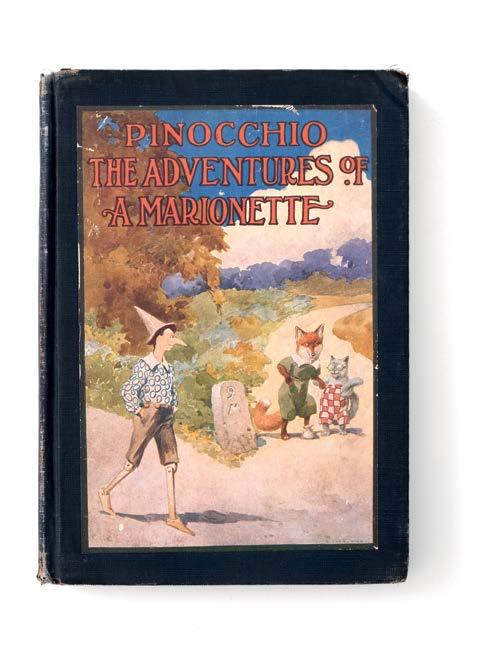
conditions. Therefore, the righteousness that several Italian readers, including some outstanding readers such as the writers Luigi Malerba and Giuseppe Pontiggia, perceive in the ending of “Pinocchio” is not regarded as such in contexts where people expect stories to give them hope of an improvement. Moreover, the adaptations of Carlo Lorenzini’s masterpiece do not just entail a more or less loyal translation. Often, the images that accompany the text modify the way the latter is perceived. In this respect, the “Atlas” shows with confidence that a very strong dividing line in the fortune of “Pinocchio” was marked by the release in the United States of the 1940 film produced by Walt Disney, which was then released quite a few years later all over the world. If before that date the re-elaborations of the iconography of the first printed editions (such as the very important original edition by Enrico Mazzanti, 1883), later on variations are stronger and stronger: while in a few cases we perceive the willingness to reproduce the roundness and sweetness of Disney’s model, in other cases the most introverted and darkest components of the text by Collodi are accentuated. In fact, such text often evokes death and the puppet even gets killed for the first time in chapter 15, with a macabre hanging which was originally meant to mark the ending of the story, although the author changed his mind by popular demand of his audience. However, even the weird contempt with which the child Pinocchio, at the end of the story, looks at the puppet version of himself, broken
down on a chair, cannot help but hit the fantasy of drawers: after all, it’s like you need to ratify the regulation of the Id, the rebellious part that you can find in the subconscious and perhaps in the actions of any human beings, by a Superego that Collodi definitely tries to exalt, with pedagogical purposes, although it isn’t the most engaging part of this work, Actually, as Ermanno Cavazzoni would say, Pinocchio remains a “nonbeliever”: he know he has to behave in a certain way but then he does the opposite; he cheats and gets cheated; he’s shrewd, but good-hearted, and so on.
In addition to these precious materials, that really meet the request by several researchers and enthusiasts of “Pinocchio”, who wished to have at their disposal an accurate map of the reception of this book in different cultural contexts throughout the world, the “Atlas” provides news on the several literary, theatrical, cinematographic and TV re-elaborations, now available also on the Internet. The volume also includes personal memories of how the puppet-child was perceived in the education of writers and intellectuals: one example out of many is that of Antonia Arslan who, in a short but delightful narration, recalls her meeting with “Pinocchio” in Aleppo, with the “letters of the Armenian alphabet, as complicated and seductive as embroideries, that would dance like the runes of a mysterious language”. A very suggestive image that, in conclusion, may serve as the metaphor of the fascination and enchantment spread by Collodi’s text throughout the world, as shown by this precious Atlas.


Atlante Pinocchio. Realizzato con la collaborazione di oltre 140 studiose e studiosi di tutto il mondo
L’Atlante Pinocchio (XXVII+662 pagine, con 92 tavole fuori testo, edito da Treccani nel 2024), ideato e curato da Giovanni Capecchi, rappresenta il punto di arrivo di un progetto di ricerca durato tre anni. Il progetto è stato promosso da Università per Stranieri di Perugia, Fondazione Caript, Fondazione Uniser, Fondazione Nazionale Carlo Collodi, con la collaborazione del Ministero per gli Affari Esteri e la Cooperazione Internazionale e dell’Istituto della Enciclopedia Italiana Treccani. Al progetto hanno collaborato oltre 140 studiose e studiosi di tutto il mondo, concentrati a ricostruire la diffusione del romanzo di Carlo Collodi in ogni angolo del pianeta. Il Comitato scientifico del progetto è composto da Alberto Casadei (docente di Letteratura italiana all’Università di Pisa e autore dell’articolo che pubblichiamo su NATURART), Veronica Bonanni (collaboratrice scientifica del gruppo di ricerca CleComparer les littératures en langues européennes dell’Università di Losanna) e Mario Casari (docente di Lingua e letteratura persiana all’Università di Roma La Sapienza).
Un momento della conferenza stampa di presentazione dell’Atlante Pinocchio alla sede della Treccani a Roma, il 27 maggio 2024. Da sinistra: Pier Francesco Bernacchi (Fondazione Nazionale Carlo Collodi), Lorenzo Zogheri (Fondazione Caript), Massimo Bray (Treccani), Giovanni Capecchi (Università per Stranieri di Perugia) e Ezio Menchi (Fondazione Uniser Pistoia)


Atlante Pinocchio. Over 140 researchers from all over the world were involved in the project
The Pinocchio Atlas (XXVII+662 pages, with 92 out of text illustrations, edited by Treccani in 2024), created and curated by Giovanni Capecchi, represents the point of arrival of a research project that lasted three years. The project was promoted by the University for Foreigners of Perugia, Caript Foundation, Uniser Foundation, Carlo Collodi National Foundation, in partnership with the Ministry of Foreign Affairs and International Cooperation and the Institute of the Italian Encyclopaedia Treccani. Over 140 researchers from all over the world were involved in the
project and they focused on recreating the dissemination of Carlo Collodi’s novel in any corner of the planet. The scientific committee of the project includes Alberto Casadei (professor of Italian Literature at the University of Pisa and author of the article published on NATURART), Veronica Bonanni (scientific research partner of the research group Cle-Comparer les littératures en langues européennes of the University of Lausanne) and Mario Casari (professor of Persian Language and Literature at the Sapienza University of Rome).
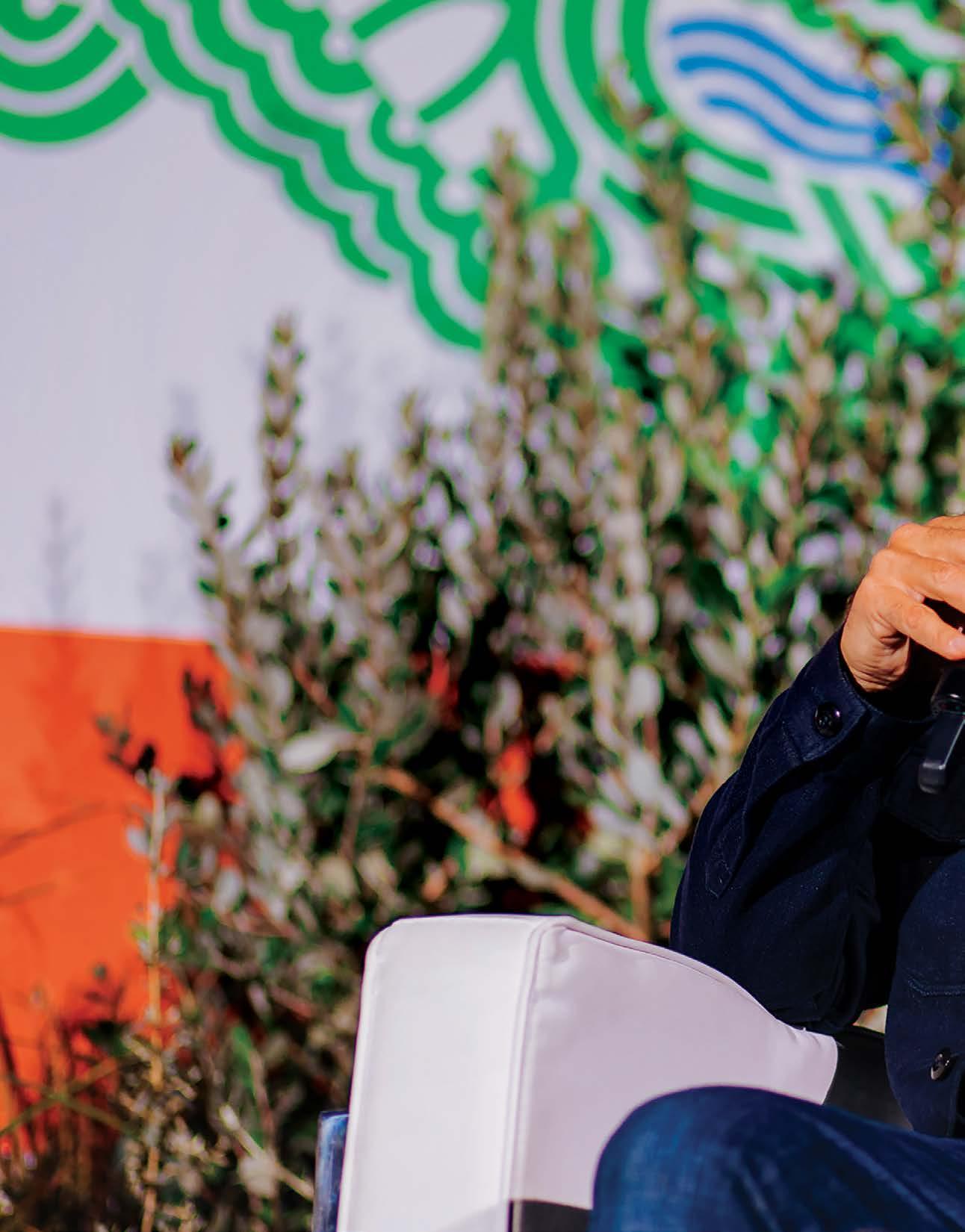
Stefano Mancuso
— Un pezzo in esclusiva per NATURART del direttore artistico di Pianeta Terra Festival, che insegna Arboricoltura generale e coltivazioni arboree all’Università di Firenze ed è direttore dell’International Laboratory of Plant Neurobiology (LINV).
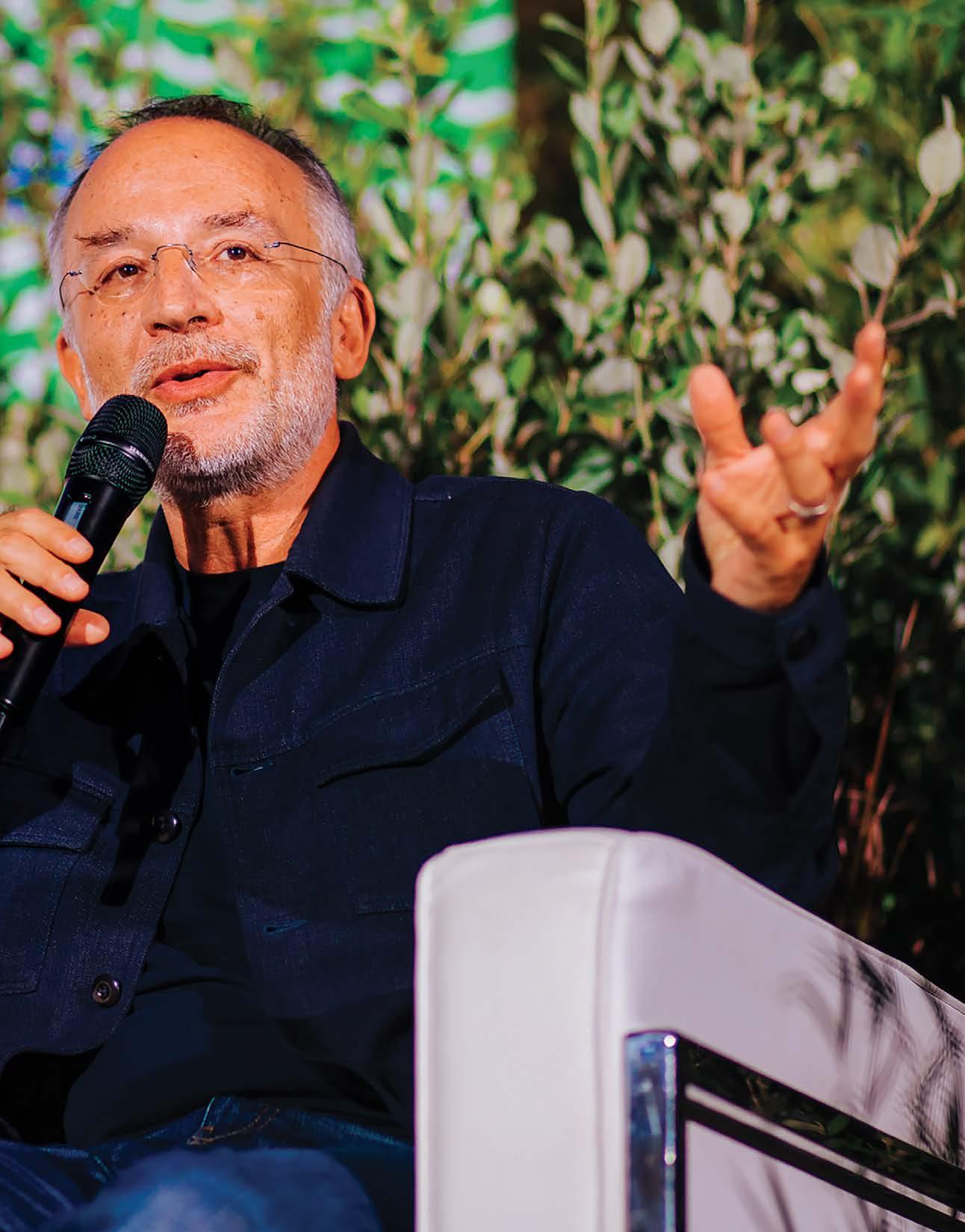


In apertura Stefano Mancuso impegnato durante un evento di Pianeta Terra Festival e accanto un momento del Festival lucchese giunto quest’anno alla sua terza edizione.
On the opening page, Stefano Mancuso during a Planet Earth Festival event; next to it, a moment of the Festival in Lucca, that this year has reached its third edition.
Vi racconto una storia. Qualche anno fa, durante un’escursione in una foresta pluviale a nord di Auckland, due ricercatori neozelandesi, Sebastian Leuzinger e Martin Bader, rinvennero un ceppo di kauri (Agathis australis) che aveva delle caratteristiche inconsuete. Per chi non è un esperto, un ceppo è solo un ceppo, non altro che il resto di un albero ormai morto destinato ad essere consumato dai microrganismi, dai funghi e dagli insetti della foresta, fino a scomparire. Ma agli occhi dei due ricercatori qualcosa non tornava: per quanto un ceppo, i tessuti al suo interno erano restati vivi anche se non aveva foglia alcuna o altro organo in grado di fare la fotosintesi. Come era possibile? Da dove prendeva l’energia e l’acqua per sopravvivere? Senza le foglie un albero manca della sua fonte energetica perché non può produrre gli zuccheri che gli consentono di vivere grazie alla fotosintesi. Non solo. Non può nemmeno assorbire l’acqua di cui ha bisogno dal terreno perché è sempre dalle foglie, dalla loro traspirazione che un albero trae la forza motrice che permette all’acqua di essere assorbita dal suolo e pompata all’interno dell’albero. Ora prima di finire di raccontare questa storia e la spiegazione di questo enigma, voglio fare quella che sulle prime vi sembrerà una digressione ma scoprirete più avanti che non lo è.
Noi siamo dominati da una visione antropocentrica del mondo. Cioè pensiamo il mondo dominato e governato dalla competizione e dai conflitti. Noi conviviamo con l’idea che la competizione e la lotta per la
sopravvivenza siano il motore dell’evoluzione.
Noi siamo dominati da una visione antropocentrica del mondo. Cioè pensiamo il mondo dominato e governato dalla competizione e dai conflitti. Noi conviviamo con l’idea che la competizione e la lotta per la sopravvivenza siano il motore dell’evoluzione. È così che immaginiamo il funzionamento delle nostre comunità. Nonostante Darwin. O a causa di una grave distorsione del pensiero di Darwin prodotta proprio da coloro che si autodichiaravano eredi e custodi di quel pensiero rivoluzionario. Sono loro ad aver imposto l’idea della competizione come forza dominante e regolatrice dei rapporti fra gli organismi viventi. Non sono bastate a contrastarla le tante voci, altrettanto autorevoli, che si sono levate contro. Penso ad esempio a quella di Kropotkin, sostenitore della necessità di individuare nella cooperazione o, come lui la chiamava, nel ‘mutuo appoggio’, la chiave di volta su cui si regge l’intera storia dell’evoluzione. Nonostante oggi il numero delle prove a sostegno del ruolo

fondamentale della cooperazione nell’evoluzione delle specie viventi sia considerevolmente cresciuto, continua a essere percepita come marginale rispetto alla solidità della controparte competitiva. Perché? La mia idea è che la causa principale stia nel fatto che la quasi totalità delle evidenze a sostegno di questa teoria proviene dal mondo delle piante. Ovvero una specie considerata incredibilmente irrilevante.
Starete pensando che sto – come si usa dire - menando il can per l’aia. Torniamo alla nostra storia. Come faceva quel ceppo a essere ancora vivo? Sebastian Leuzinger e Martin Bader ipotizzarono che ricevesse ciò di cui aveva bisogno dall’apparato radicale degli alberi vicini, grazie a un fenomeno conosciuto come innesto radicale. Ai più è noto come la pratica agronomica che permette la fusione fra due individui diversi ma affini, per creare un individuo nuovo formato dall’unione dei due bionti (è questo il termine tecnico che si assegna ai due individui che partecipano all’innesto).

Normalmente si utilizza un portinnesto, che costituirà la parte basale (con le radici) della nuova pianta, e un nesto, che invece formerà la parte aerea (con foglie e frutti). Con l’innesto si crea una completa connessione vascolare fra i tessuti dei due bionti che permetterà la circolazione fra parte basale e parte aerea e viceversa. In una foresta, come quella dove sta il nostro ceppo, avremo innesti fra parti diverse dello stesso apparato radicale (autoinnesto), innesti fra apparati radicali di alberi diversi ma appartenenti alla stessa specie (innesto intraspecifico) e, infine, innesti fra apparati radicali di alberi appartenenti a specie diverse (innesto interspecifico). Questo fenomeno è noto da secoli ma è stato considerato fino a non molto tempo fa poco più che una particolarità botanica. Dal mio punto di vista, invece, rivoluziona la nostra idea di cosa sia realmente una comunità vegetale. È la stessa ragione per cui Leuzinger e Bader decisero di fare uno studio accurato del ceppo vivo in cui incapparono.
Tornati a Auckland decidono di concentrarsi sulla misurazione dei cicli di assorbimento dell’acqua all’interno del ceppo e degli alberi vicini. Sperano di riuscire a osservare una qualche sincronia che possa far loro stabilire un’effettiva connessione idraulica sotterranea e funzionante. Così, con gli strumenti necessari ritornano nella foresta e iniziano a impiantare sul ceppo e sugli alberi circostanti dei sensori in grado di registrare in tempo reale il flusso idrico all’interno del tronco. Sistemano gli strumenti e ritornano a Auckland per seguire dai loro laboratori il flusso costante di dati proveniente dalla foresta. Ora siccome voglio arrivare alla questione centrale che il ceppo pone e alla morale della storia, vi dico solo che i due ricercatori, sulla base dei dati registrati, arrivano alla conclusione che effettivamente esiste una stretta relazione idraulica fra gli alberi vicini e il ceppo non morto.
Il modello predatorepreda non ha nulla a che spartire con il mondo delle piante. Loro esibiscono un comportamento cooperativo perché è il più vantaggioso.
La questione è: Perché degli alberi sani dovrebbero farsi carico per un tempo molto lungo di un ceppo? È qui che torna utile quella che all’inizio poteva apparire una digressione, ovvero la nostra visione antropocentrica del mondo. Il modello predatore-preda non ha nulla a che spartire con il mondo delle piante. Loro esibiscono un comportamento cooperativo perché è il più vantaggioso. Ne cito solo due a titolo di esempio: in un innesto radicale meglio avere vicini sani e soprattutto l’innesto con altri alberi aumenta la stabilità degli alberi e resistono meglio a eventi atmosferici estremi. Ditemi ora se non abbiamo molto da imparare dalle piante?

Stefano Mancuso insegna Arboricoltura generale e coltivazioni arboree all’Università di Firenze ed è direttore dell’International Laboratory of Plant Neurobiology (LINV). È uno dei membri fondatori dell’International Society for Plant Signaling & Behavior, e accademico ordinario dell’Accademia dei Georgofili. Tra le sue pubblicazioni Verde brillante. Sensibilità e intelligenza del mondo vegetale (Giunti Editore, 2013, con Alessandra Viola), Uomini che amano le piante (Giunti Editore, 2014), Botanica. Viaggio nell’universo vegetale (Aboca Edizioni, 2017), Plant revolution (Giunti Editore, 2017), L’incredibile viaggio delle piante (Laterza 2018), La nazione delle piante (Laterza 2019), La tribù degli alberi (Einaudi, 2022) e Fitopolis, la città vivente (Laterza, 2023).
Stefano Mancuso teaches General Arboriculture and Tree Cultivation at the University of Florence, and is director of the International Laboratory of Plant Neurobiology (LINV). He’s one of the founding members of the International Society for Plant Signaling & Behavior and a full professor at the Accademia dei Georgofili. Its publications include Verde brillante. Sensibilità e intelligenza del mondo vegetale (Giunti Publishing House, 2013, with Alessandra Viola), Uomini che amano le piante (Giunti Publishing House, 2014), Botanica, Viaggio nell’universo vegetale (Aboca Edizioni, 2017), Plant revolution (Giunti Publishing House, 2017), L’incredibile viaggio delle piante (Laterza 2018), La nazione delle piante (Laterza 2019), La tribù degli alberi (Einaudi, 2022) and Fitopolis, la città vivente (Laterza, 2023).


— Stefano Mancuso
An exclusive article for NATURART by Stefano Mancuso, artistic director of Planet Earth Festival, who teaches General Arboriculture and Tree Cultivation at the University of Florence, and is director of the International Laboratory of Plant Neurobiology (LINV).
I’ll tell you a story. A few years ago, during an excursion in a rainforest north of Auckland, two New Zealander researchers, Sebastian Leuzinger and Martin Bader, found a stump of kauri (Agathis australis) that had a few unusual characteristics. For those who do not have any experience with it, a stump is just a stump, nothing other than the rest of a dead tree which is destined to be consumed by microorganisms, mushrooms and insects in the forest, until it disappears. But something was wrong in the eyes of the two researchers: even if it was a stump, its internal tissues had remained alive, even if it didn’t have any leaf or any other organ that was capable of photosynthesizing. How was it possible? From where did it take the energy and water to survive? Without leaves, a tree doesn’t have its source of energy, because it can’t produce the sugars that allow it to survive thanks to photosynthesis. And it’s not only that. It can’t even absorb the water it

needs from the ground because, again, a tree takes from leaves and their transpiration the motor power that allows water to be absorbed by the soil and pumped within the tree. Now, before I finish this story and explain this enigma, I want to make what may initially look like a digression: later one, you’ll find out that it isn’t so.
We are dominated by an anthropocentric vision of the world, that is, we think that the world is dominated and ruled by competition and conflicts. We live with the idea that competition and the fight for survival are the engine of evolution. That’s how we imagine the functioning of our communities, despite Darwin, or due to a serious distortion of his thought, produced by those who had self-declared as heirs and keepers of that revolutionary thinking. It’s them who imposed the idea of competition as a dominating force, that regulates the relationships between human beings. The several, equally authoritative voices against it weren’t enough to oppose it.
I think, for example, of the voice of Kropotkin, who supported the need to find in cooperation or, as he used to call it, “mutual aid”, the keystone on which the whole story of evolution is based. Although the number of evidences that support the key role of cooperation in the evolution of living species has significantly grown, it continues to be perceived as marginal vs its strong competitive counterpart. Why?
In my opinion, the root cause is the fact that almost all evidences that support this theory come from the world of
plants, that is, a species that is regarded as incredibly irrelevant.
You may think that, as they say, I’m beating around the bush. Let’s go back to our story. How come was that stump alive? Sebastian Leuzinger and Martin Bader speculated that it received what it needed from the root system of the nearby trees, thanks to a phenomenon that is known as root graft. Most people know it as the agronomic practice that allows the fusion between two different but affine individuals, to create a new individual that derives from the combination of two bionts (this is the technical term assigned to the two individuals that participate in the graft). Normally, you use a rootstock, which will form the basal part (with roots) of the new plant, and the scion which, instead, will form the aerial part (with leaves and fruits). The graft allows to create a full vascular connection between the tissues of the two bionts, that will allow the circulation between basal part and aerial part, and vice versa. In a forest, similar to that where our stump is located, we will have grafts between different parts of the same root system (autograft), grafts between root systems of different trees that belong to the same species (intraspecific graft) and, finally, grafts between root systems of trees belonging to different species (intraspecific graft). This phenomenon has been known for centuries, but until not so long ago it was regarded as nothing more than a botanical specialty. In my opinion, instead, it revolutionizes our idea of what a plant community is. It’s the same reason why Leuzinger and Bader decided to make

an accurate study of the live stump they had found. Following their return to Auckland, they decided to focus on measuring the absorption cycles of water within the stump and the nearby trees. They hoped to manage to observe some synchrony, that could help them establish whether there’s actually an underground, working hydraulic connection. Therefore, with the necessary tools, they went back to the forest and started to implant a few sensors, capable of recording in real time the water flow within the trunk. They organized their tools and went back to Auckland to follow from their laboratories the continuous flow of data coming from the forest. Now, I’d like to get to the key issue posed by the stump and the moral of the story, so I’ll just tell you that the two researchers, based on the recorded data, reached the conclusion that there’s actually a close hydraulic relation between the nearby trees and the undead stump. The question is: why should some healthy trees take charge of a stump for a very long period of time? It’s here that what may initially look like a digression, that is our anthropocentric vision of the world, comes in handy. The predatorprey model doesn’t have anything to do with the world of plants. They show a cooperative behaviour because it’s the most advantageous one. I’ll just mention two examples: in a root graft, it’s better to have healthy neighbours. In particular, the graft with other trees increases the stability of trees, that are more resistant to extreme atmospheric events. Do you still think we don’t have much to learn from plants?
In alto alcuni allestimenti “green” realizzati da Giorgio Tesi Group nella edizione 2023. Il modello predatore – preda, spiega l’autore, non ha nulla a che spartire con il mondo delle piante. Loro esibiscono un comportamento cooperativo perché è il più vantaggioso…
Above some “green” installations created by Giorgio Tesi Group in the 2023 edition. As explained by the author, the predator-prey doesn’t have anything to do with the world of plants. They show a cooperative behaviour because it’s the most advantageous one…

Da troppo tempo ci siamo posti al di fuori della natura, dimenticandoci che rispondiamo agli stessi fondamentali fattori che controllano l’espansione delle altre specie. Da come immagineremo le nostre città nei prossimi anni dipenderà una parte consistente delle nostre possibilità di sopravvivenza. Nel volgere di pochi decenni, l’umanità è andata incontro a una rivoluzione nelle sue abitudini ancestrali. Senza che ce ne accorgessimo, la nostra specie, che fino a poco tempo fa viveva immersa nella natura abitando ogni angolo della Terra, ha finito per abitare una parte davvero irrisoria delle terre emerse del pianeta. Cosa è accaduto? Da specie generalista in grado di vivere dovunque, ci siamo trasformati, in poche generazioni, in una specie in grado di vivere in una sola e specifica nicchia ecologica: la città. Una rivoluzione paragonabile soltanto alla transizione da cacciatori-raccoglitori ad agricoltori avvenuta 12.000 anni fa. È certo che in termini di accesso alle risorse, efficienza, difesa e diffusione della specie questa trasformazione è vantaggiosa. Ma è altrettanto certo che ci espone a un rischio terribile: la specializzazione di una specie è efficace soltanto in un ambiente stabile. In condizioni ambientali mutevoli diventa pericolosa. Il nostro successo urbano richiede, infatti, un flusso continuo ed esponenzialmente crescente di risorse e di energia, che però non sono illimitate. Il riscaldamento globale può cambiare in maniera definitiva l’ambiente delle nostre città e costituire proprio quella fatale mutazione delle condizioni da cui dipende la nostra sopravvivenza. Ecco perché è diventato vitale riportare la natura all’interno del nostro habitat. Le città del futuro, siano esse costruite ex novo o rinnovate, devono trasformarsi in “fitopolis”, luoghi in cui il rapporto fra piante e animali si riavvicini al rapporto armonico che troviamo in natura. Non c’è nulla che abbia una maggiore importanza di questo per il futuro dell’umanità.
Autore: Stefano Mancuso - Editore: Laterza Collana: I Robinson - Letture - Anno edizione: 2023
Pagine: 176 - Confezione: Brossura - EAN: 9788858152607



Da giovedì 3 a domenica 6 ottobre 2024 a Lucca. Tra gli ospiti: Roberta De Monticelli, Dario Fabbri, Vittorio Gallese, Vittorio Lingiardi, Daniela Silvia Pace, Telmo Pievani, Gaia Vince, Alice Rohrwacher Green supporer Giorgio Tesi Group
Anche quest’anno Lucca sarà il magnifico teatro urbano che ospiterà la terza edizione di Pianeta Terra Festival, diretto da Stefano Mancuso, ideato, progettato e organizzato dagli Editori Laterza e promosso dalla Fondazione Cassa di Risparmio di Lucca. La manifestazione si terrà da giovedì 3 a domenica 6 ottobre 2024, in alcuni dei luoghi più suggestivi della città, tra cui: la Chiesa di San Francesco, Palazzo Ducale, l’Orto Botanico e, per la prima volta, la Casa del Boia. Le comunità naturali sarà il tema generale che attraverserà gli incontri, i dialoghi, le lezioni e gli spettacoli di questa edizione. Durante i quattro giorni di

festival, saranno oltre 90 gli eventi che chiameranno a raccolta scienziati, antropologi, filosofi, economisti, scrittori, artisti e innovatori. I tanti ospiti mostreranno come le relazioni fra gli esseri viventi siano incredibilmente più complesse di quanto immaginiamo e siano governate da forze molto diverse dalla semplice competizione. Scopriremo che è la cooperazione, la cui azione agisce indifferentemente dal livello degli individui a quello delle comunità, uno dei motori fondamentali dell’evoluzione. È, infatti, la cooperazione la forza attraverso la quale la vita prospera, la vera forza trainante che decide il destino degli esseri viventi. Si discuterà di come le specie vegetali e animali costruiscono delle comunità, di simbiosi, di alleanze fra le specie, delle complessità specifiche delle comunità umane e di quelle caratteristiche di ciascuna specie e ancora di biodiversità, sostenibilità, politiche del cibo, paesaggi e fenomeni estremi, del nostro Mediterraneo, e molto altro. L’obiettivo è osservare e conoscere il modo in cui ogni individuo crea alleanze con gli altri della sua specie e con le altre specie sperimentando quel piccolo miracolo che si avvera quando specie diverse, imparando a stare insieme, stringono una relazione.
Pianeta Terra Festival è progettato e organizzato dagli Editori Laterza e promosso dalla Fondazione Cassa di Risparmio di Lucca. La Città di Lucca e la Rappresentanza in Italia della Commissione europea sono partner istituzionali dell’evento. La manifestazione è resa possibile anche dalla compartecipazione della Camera di Commercio Toscana NordOvest / The Lands of Giacomo Puccini e Confindustria Toscana Nord. Hanno conferito il loro patrocinio la Regione Toscana e la Provincia di Lucca. Il Festival si avvale della collaborazione con la Scuola IMT Alti Studi di Lucca, la Scuola Superiore Sant’Anna, l’Università di Pisa, l’Associazione di Fondazioni e Casse di Risparmio, l’Ufficio Scolastico Territoriale di Lucca e Massa Carrara, la Fondazione Campus. Hanno confermato la loro partecipazione al progetto A11 Venture, l’Associazione Musicale Lucchese, l’Associazione Talea, la Biblioteca civica Agorà, la Fondazione Giuseppe Pera, Green Cross Italia, il Conservatorio di Musica “Luigi Boccherini”, Lucca Comics&Game, il Lucca Film Festival, Lucense, l’Orto Botanico di Lucca e Photolux Festival. Importantissimo il sostegno di numerosi sponsor. Ad oggi si ringraziano: Banco BPM, Sofidel, Confagricoltura, Ecopol, EOS IM, Findus, Green Utility, Gruppo Hera, RetiAmbiente, Ricola e Toscotec. Giorgio Tesi Group è il green partner dell’iniziativa.
Per maggiori informazioni e dettagli consultare il sito del festival pianetaterrafestival.it e i canali social Facebook, Instagram, Twitter e Youtube.

From Thursday October 3rd, to Sunday October 6th, 2024. Among the guests: Roberta De Monticelli, Dario Fabbri, Vittorio Gallese, Vittorio Lingiardi, Daniela Silvia Pace, Telmo Pievani, Gaia Vince, Alice Rohrwacher
Also this year, Lucca will be the magnificent urban theatre that will host the third edition of Planet Earth Festival, directed by Stefano Mancuso, created, designed and hosted by Editori Laterza and promoted by the Cassa di Risparmio di Lucca Foundation. The event will take place from Thursday, October 3rd, to Sunday October 6th, 2024, in some of the most suggestive places of the city, including: the Church of San Francesco, the Ducal Palace, the Botanical Garden and, for the first time, the Hangman’s House. Natural communities will be the general topic of the meetings, conversations, lessons and shows that are scheduled for this edition. During the four days of the festival, over 90 events will be attended by scientists, anthropologists, philosophers, economists, writers, artists and innovators. The several guests will show how the relationships between human beings are way more complex than how we imagine them and are governed by strengths that are very different from the simple competition. We will find out that it’s cooperation, which acts indifferently at an individual and community level, is one of the key engines of evolution. In fact, cooperation is the strength through which life, the actual driving force that decides the
fate of human beings, thrives. We will discuss how plant and animal species build communities of symbiosis, alliances between species, specific complexities of human communities and peculiar complexities of each species, biodiversity, sustainability, food politics, extreme landscapes and phenomena, communities within our Mediterranean region, and much more. The goal is to observe and know the way with which every individual forms alliances with other individuals from their species and other species, experimenting that small miracle that happens when different species establish a relationship by learning to live together.
Planet Earth Festival is designed and hosted by Editori Laterza and promoted by the Cassa di Risparmio di Lucca Foundation. The Municipality of Lucca and the Representation of the European Commission in Italy are the institutional partners of the event.
The event is made possible also by the joint participation of the North West Tuscany Chamber of Commerce / The Lands of Giacomo Puccini and North Tuscany Confindustria. The event was endorsed by the Tuscany Region and the Province of Lucca.
The Festival relies on the collaboration with the IMT School for Advanced Studies Lucca, the Sant’Anna School of Advanced Studies, the University of Pisa, Associazione di Fondazioni e di Casse di Risparmio S.p.A., the Territorial School Office of Lucca and Massa Carrara and the Campus Foundation. A11 Venture, the Lucchese Music Association, the Talea Association, the Agorà civic library, the Giuseppe Pera Foundation, Green Cross Italia, the “L. Boccherini” Music Conservatory, Lucca Comics&Game, Lucca Film Festival, Lucense, the Botanical Garden of Lucca and Photolux Festival confirmed their participation in the project. The support of several sponsors is also very important. As of today, we thank: Banco BPM, Sofidel, Confagricoltura, Ecopol, EOS IM, Findus, Green Utility, RetiAmbiente, Ricola and Toscotec. Giorgio Tesi Group is the green partner of the initiative.
For further information and details, please check the website of the festival pianetaterrafestival.it and the social media channels Facebook, Instagram, Twitter and YouTube.
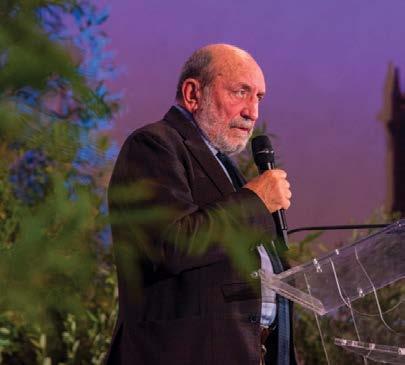
Durante i 4 giorni di festival saranno oltre 90 gli eventi che chiameranno a raccolta scienziati, antropologi, filosofi, economisti, scrittori, artisti e innovatori. I tanti ospiti mostreranno come le relazioni fra gli esseri viventi sono incredibilmente più complesse di quanto immaginiamo e sono governate da forze molto diverse dalla semplice competizione.
During the four days of the festival, over 90 events will be attended by scientists, anthropologists, philosophers, economists, writers, artists and innovators. The several guests will show how the relationships between human beings are way more complex than how we imagine them and are governed by strengths that are very different from the simple competition.



Non è possibile la conservazione delle specie animali minacciate senza un processo di formazione di tutte le persone coinvolte, sia nei Paesi che ospitano le specie in pericolo, sia in quest’altra parte del mondo abitata da “consumatori di biodiversità”. L’educazione alla conservazione fa parte di un processo chiamato “One Plan Approach”. Cosa significa veramente?
La conservazione della biodiversità è una grande sfida per l’uomo moderno e dalla buona riuscita di questa impresa dipende la sopravvivenza stessa della nostra specie, ma la maggior parte delle persone pare non rendersene conto. Da qualche anno i professionisti che lavorano alla conservazione della Natura sono allineati su un importante punto: salvare le specie dell’estinzione è possibile solo con la collaborazione di tutti e con tutti gli strumenti possibili. Le azioni da mettere in campo sono tante e fortemente connesse le une alle altre: dall’allevamento delle specie nei giardini zoologici e acquari, la protezione degli habitat naturali, l’attività di ricerca per individuare quanto prima le cause della diminuzione, la divulgazione e il coinvolgimento delle popolazioni, sia nei territori dove le specie sono minacciate, sia in questa parte del mondo dove gli uomini sono dei costanti “consumatori di biodiversità”. Ogni progetto a sostegno di una specie minacciata è affrontato secondo il “One Plan Approach”, un approccio a 360° che permette di gestire le problematiche relative alla sopravvivenza di una specie da ogni angolazione possibile unendo le forze di tutti i protagonisti. Il movimento Reverse
the Red dell’IUCN (Unione Internazionale per la Conservazione della Natura) riassume bene l’importanza delle sinergie per ottenere storie di successo, in cui le specie animali minacciate riconquistano territori o risalgono la “scala” della Red List, la lista che le classifica in base al rischio di estinzione.
Il Giardino Zoologico di Pistoia fa parte di questa alleanza ed è impegnato nelle azioni di conservazione con il mantenimento di specie a rischio di estinzione e le attività di ricerca, di divulgazione e di formazione.
Grazie al supporto dei nostri visitatori, sosteniamo economicamente progetti di conservazione in differenti parti del mondo, alcuni attraverso il finanziamento di associazioni strutturate e affidabili come la Red Panda Network in Nepal o la SANCOOB in Sud Africa, altri condotti dai centri di ricerca delle Università italiane di Pisa, Firenze o Torino.
In ogni progetto una buona parte del finanziamento è per le attività di sensibilizzazione e formazione delle popolazioni locali.
Negli anni siamo riusciti a raggiungere molti bambini con libri, matite colorate e progetti didattici adattati alla loro lingua
e alle loro necessità. Per trasferire risorse economiche verso realtà in cui le persone vivono in condizioni di estrema povertà è necessario costruire una filiera trasparente e sicura, affinché non si disperdano i materiali acquistati o i fondi raccolti. Una delle nostre ambasciatrici più efficaci è la Prof.ssa Elisabetta Palagi (Dipartimento di Biologia dell’Università di Pisa) con cui il GZP collabora da più di 25 anni. È con lei e il suo team che siamo tornati in Etiopia per sostenere un progetto che ha come protagoniste le magnifiche scimmie gelada (Theropithecus gelada) specie di cui abbiamo solo frammentarie informazioni. Sono scimmie erbivore che amano pascolare sugli altipiani etiopi, unici posti al mondo dove vivono condividendo le praterie con i pastori e gli agricoltori. Proprio l’espansione delle aree agricole e dei pascoli sta determinando gravi modifiche al loro habitat costringendole a frequentare zone sempre più piccole e inaccessibili all’uomo.
Lo studio etologico è condotto in collaborazione con l’Università di Addis Abeba e una parte importante del progetto riguarda le persone che vivono nei villaggi vicini all’area interessata dalla ricerca: sono stati organizzati incontri per spiegare l’importanza delle gelada e i bambini e le bambine hanno ricevuto materiale scolastico e un piano di formazione condiviso con i loro insegnanti. La “cassa di risonanza” di queste azioni di conservazione è il Parco affinché i nostri visitatori ne diventino parte attiva. Per non essere “predatori di biodiversità” è importante acquistare con attenzione i beni la cui produzione comporta l’uso di risorse naturali. Vivere in modo sostenibile è davvero complesso e spesso si deve scendere a compromessi. Ognuno di noi può costruire passo dopo passo il proprio modo, per far sì che davvero si possa “invertire la rotta” della perdita di biodiversità. Insieme è possibile!
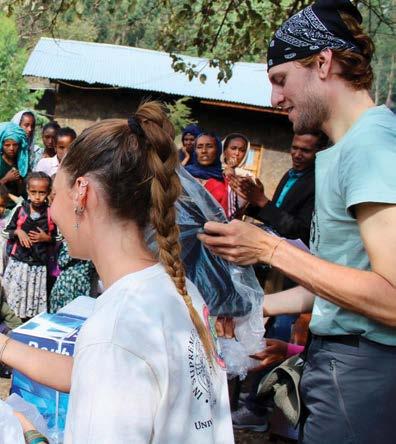
A sinistra due magnifiche scimmie gelada (Theropithecus gelada). Accanto, nel corso degli anni siamo riusciti a raggiungere molti bambini con libri, matite colorate e progetti didattici adattati alla loro lingua e alle loro necessità.
(Foto Elisabetta Palagi)
At left are two magnificent gelada monkeys (Theropithecus gelada). Side by side, over the years we have managed to reach many children with books, colored pencils and educational projects adapted to their language and needs.
(Photo Elisabetta Palagi)
Education for conservation, one of the actions of the “One Plan Approach”.
It’s not possible to preserve the threatened animal species without a training process of all the persons involved, both in the countries that host endangered species and in this other part of the world, inhabited by “biodiversity consumers”. Education for conservation is one of the actions that are part of a process called “One Plan Approach”. What does it really mean?
The conservation of biodiversity is a great challenge for modern human beings and the survival itself of our species depends from the success of this endeavour. However, most people do not seem to realize it. Professionals who work on the conservation of Nature have been aligned on an important point: saving species from extinction is possible only if everyone collaborates with all the possible tools. There are several actions that can be carried out, which are strongly interconnected: the breeding of species in zoological gardens and aquariums, the protection of natural habitats, the research activity to detect as soon as possible the reasons of the decrease, the dissemination and involvement of populations, both in territories where species are threatened and in this part of the world where human beings are constant “biodiversity consumers”. Every project to support a threatened species should be managed according to the “One Plan Approach”, an all-round approach that allows to manage the issues related to the survival of a species from any possible corner, by joining the forces of all protagonists. The IUCN (International Union for Conservation of Nature)’s Reverse the Red movement
summarizes well the importance of synergies to obtain successful stories, where threatened animal species reconquer territories or climb back the “stair” of the Red List, the list that classifies species according to their risk of extinction.
The Zoological Garden of Pistoia is part of this alliance and commits to conservation actions, by maintaining species that are at risk of extinction and carrying out research, dissemination and training activities.
Thanks to the support of our visitors, we financially support conservation projects in different parts of the world: in some cases, by financing structured and reliable associations such as the Red Panda Network in Nepal or the SANCCOB in South Africa, whereas other projects are carried out by the research centres of the Italian universities of Pisa, Florence or Turin.
In every project, a good part of the funds is allocated to awareness and training activities for local populations.
Over the years, we managed to reach several children with books, coloured pencils and didactic projects adapted to their language and needs. To transfer economic resources towards realities where people live in conditions of extreme poverty, we need to build a transparent
and safe supply chain, so that the purchased materials or the collected funds are not dispersed.
One of our most effective ambassadors is Professor Elisabetta Palagi (Department of Biology of the University of Pisa), with whom the Zoological Garden of Pistoia has been partnering for over 25 years. It’s with her, and with her team, that we returned to Ethiopia to support a project whose protagonists are the wonderful gelada monkeys (Theropithecus gelada), a species about which we only have fragmented information.
They are herbivorous monkeys that love to graze on the Ethiopian tablelands, the only places in the world where they live by sharing prairies with shepherd and farmers. Actually, the expansion of agricultural areas and pastures is leading to serious amendments to their habitat, forcing them to frequent increasingly smaller areas, which are inaccessible to human beings.
The ethological study is conducted in partnership with the University of Addis Abeba, and an important part of the project involves the people who live in the villages next to the area interested by the research: a few meetings were organized to explain the importance of the gelada monkeys, and children received school material and a training plan shared with their teachers.
The “sounding board” of these conservation actions is the Park, so that our visitors can become an active part of it. To avoid being “predators of biodiversity”, it’s important to carefully purchase goods whose production entails the use of natural resources. Living in a sustainable way is really complex and we must often compromise. Each of us can build, step by step, their own method, so that we can really “reverse the course” of the loss of biodiversity. Together we can do it!

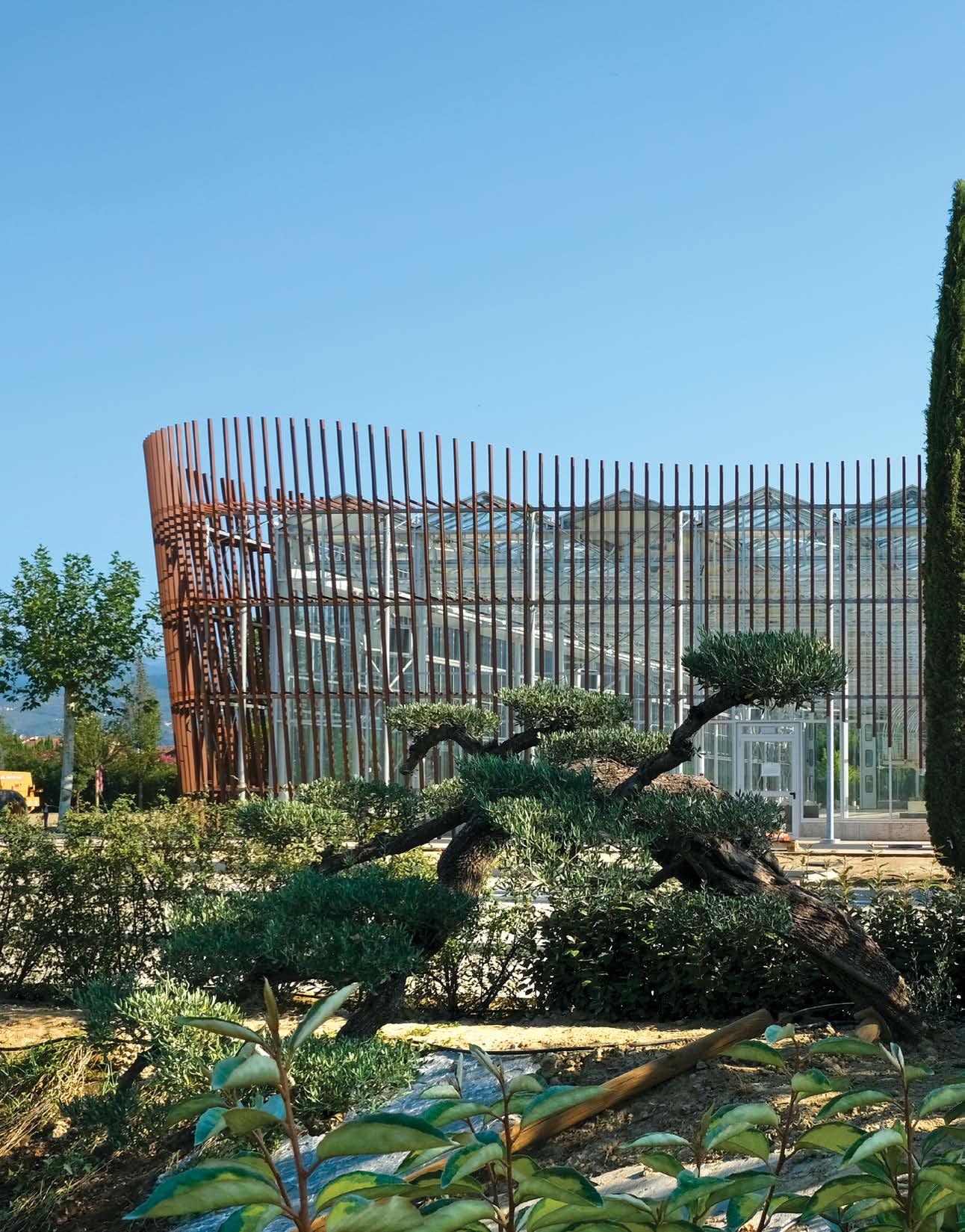
Verde, cibo e cultura
— Work in progress per il luogo “fisico” che riassumerà al suo interno un po’ tutti i valori e le passioni che Giorgio Tesi Group ha espresso nei suoi primi 50 anni di attività.
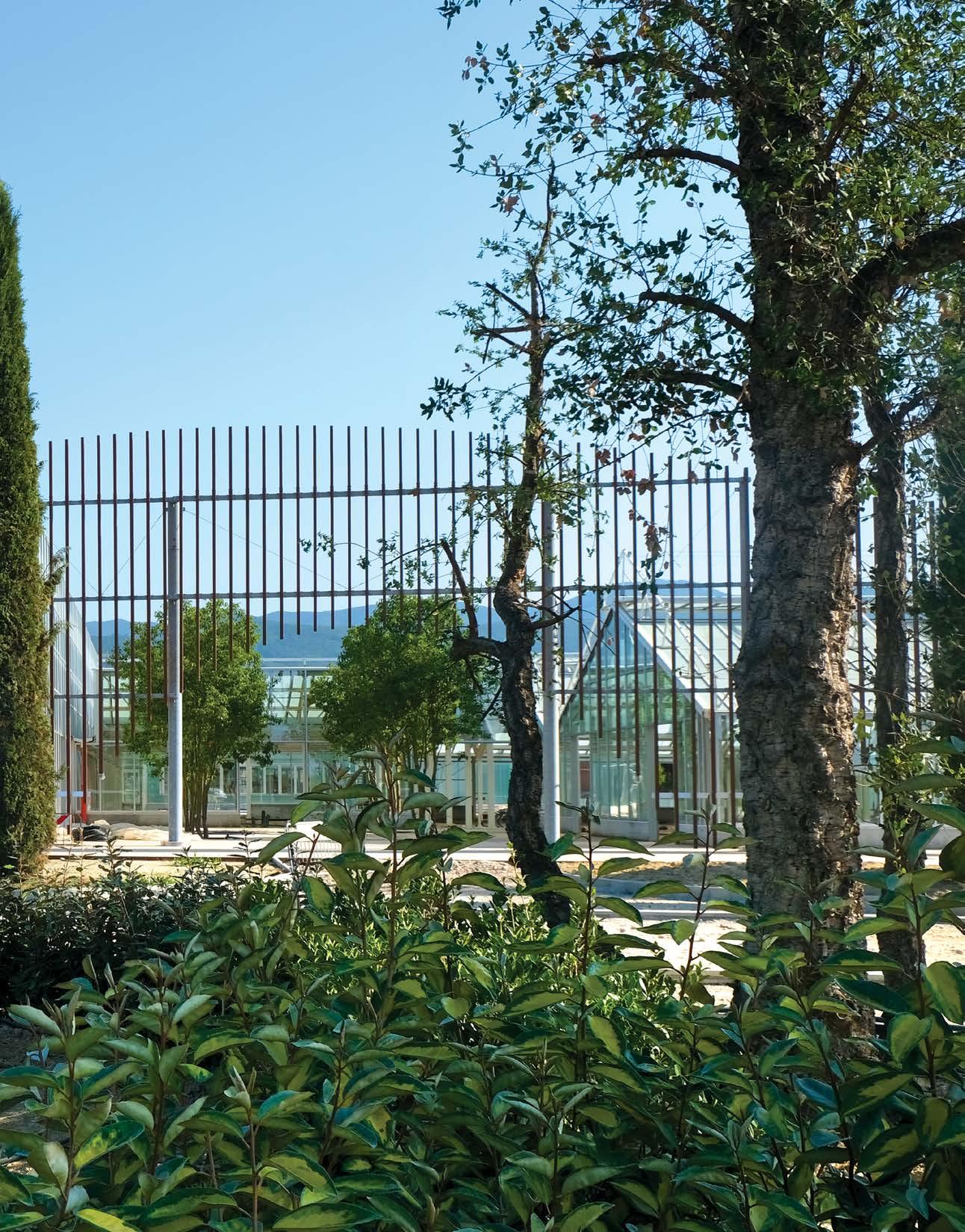

In apertura un’immagine della struttura che sta nascendo lungo Via Toscana a Pistoia. In queste pagine, accanto Marco Cappellini, Direttore Generale di Giorgio Tesi Group e alcune foto che mostrano l’avanzamento dei lavori sia all’interno che nel parco che circonda il NATURART VILLAGE.
In the opening page, an image of the facility that is being built along Via Toscana in Pistoia. In these pages, next to Marco Cappellini, General Manager of Giorgio Tesi Group, and a few pictures that show the progress of the works both internally and inside the park that surrounds NATURART Village.
Con Marco Cappellini, Direttore Generale di Giorgio Tesi Group, facciamo il punto sullo stato dei lavori necessari per completare la realizzazione di questa struttura che oltre a rappresentare un hub strategico per l’azienda vivaistica pistoieseleader a livello europeo nel vivaismo di piante ornamentali - avrà un ruolo molto importante sia per il territorio, che partendo da Pistoia, capitale europea del verde abbraccia una vasta area metropolitana, che per la comunità cittadina e soprattutto per la promozione e la valorizzazione delle piante pistoiesi in tutto il mondo.
I lavori per il completamento del NATURART Village proseguono spediti e percorrendo Via Toscana sono molti quelli che vedendone l’avanzamento si domandano quando termineranno. Cosa può dirci in proposito?
I lavori stanno procedendo speditamente ma dobbiamo sempre tener conto che si tratta di un progetto molto complesso pensato diversi anni fa a cui si è aggiunta in itinere un’acquisizione di un’area limitrofa, peraltro molto importante, che ci ha permesso di aumentare l’area verde esterna e di avere entrata e uscita lungo le due strade principali che collegano Pistoia con Prato e quindi con tutta l’area metropolitana
fiorentina. Naturalmente la realizzazione di una struttura del genere coinvolge più anime e più soggetti tra aziende impegnate nella sua realizzazione, istituzioni, tecnici e professionisti e questo ha generato continue riflessioni che hanno portato a migliorare il progetto iniziale. Per quanto riguarda l’apertura, questa è prevista per il 2025.
Conoscendo l’impegno nel sociale, nella promozione sportiva e nella valorizzazione territoriale che da anni contraddistingue l’azienda, su questo NATURART Village ci sono tanta curiosità e anche tante aspettative. Cosa troveremo in questa struttura e cosa potrà rappresentare per la città e il territorio che la circonda?
Oggi la nostra azienda guarda con grande attenzione al futuro, proprio con la realizzazione di NATURART VILLAGE, un luogo che riassumerà al suo interno un po’ tutti i valori e le passioni che Giorgio Tesi Group ha espresso nei suoi primi 50 anni di attività. Si tratta indubbiamente di una struttura molto importante per avvicinare il mondo del vivaismo alla comunità e che abbiamo voluto aperta a tutti. Al NATURART Village sarà possibile tutti i giorni visitare lo show room aziendale con le più interessanti varietà di piante della nostra produzione compresi meravigliosi
e unici esemplari di bonsai oppure fruire di un’area convegni decisamente importante che sarà animata da eventi legati allo sport, all’arte e alla cultura della nostra città, ma anche all’attività della Giorgio Tesi Editrice, con NATURART e Discover Pistoia, a quella della Fondazione Giorgio Tesi (voluta dalla Famiglia Tesi in ricordo di Giorgio, Tullio e Franco per cercare di restituire


dignità agli ultimi e migliorare le situazioni di maggiore difficoltà, cercando di prendersi cura delle persone più disagiate, dei malati, degli anziani e dei bambini), e al Progetto Giorgio Tesi Junior, ideato nel 2016 con lo scopo di sostenere lo sport pistoiese premiando le realtà che si distinguono per la promozione dei valori dello sport e nell’organizzazione del settore giovanile.
Nelle belle giornate, visitatori, bambini e famiglie avranno poi la possibilità di passeggiare e fermarsi nel parco di 3 ettari realizzato con splendide piante dove saranno predisposte aree dedicate agli eventi e ai giochi per i più piccoli.
Tutto questo, naturalmente, legato ad una moderna e funzionale area food con varie eccellenze gastronomiche della Toscana, dove sarà possibile sia acquistare che gustare a pranzo e a cena i migliori prodotti del territorio, che passare una bella serata in compagnia degli amici bevendo una buona birra o un cocktail a ritmo di musica.
Un luogo quindi che oltre ad ospitare lo show room aziendale di Giorgio Tesi Group, un’area food di eccellenza assoluta e tanti eventi legati sia al mondo delle piante che al territorio, sarà importante anche per la creazione di nuovi posti di lavoro e quindi motore di significative economie …
Certamente questo è un progetto che prima di tutto porterà decine di nuovi posti di lavoro rappresentando quindi un importante valore per la città.
L’azienda ha fatto un significativo investimento creando sul territorio una struttura unica nel suo genere che ha sicuramente tutte le carte in regola per diventare un polo d’attrazione molto importante per diversi
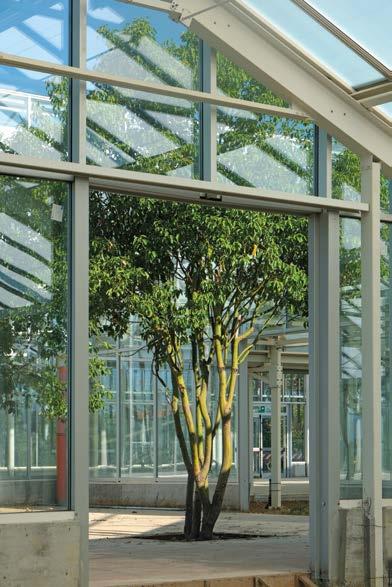
settori sia a livello regionale che nazionale e internazionale.
Un luogo, e questo ci teniamo a dirlo con grande soddisfazione, unico nel suo genere, aperto a tutti e pensato per rispondere alle esigenze di tutte le persone, con l’obiettivo di far conoscere sempre di più la nostra azienda cercando di garantire a chi lo frequenterà, benessere all’interno di un’ambiente green e sostenibile.

Work in progress for NATURART Village, the “physical” place that will somehow summarize all the values and passions expressed by Giorgio Tesi Group in its first 50 years of activity.
With Marco Cappellini,
General Manager of
All’interno del Village
oltre allo show room dell’azienda vivaistica pistoiese, ci sarà una moderna e funzionale area food dove sarà possibile sia acquistare che gustare a pranzo e a cena i migliori prodotti e le eccellenze gastronomiche espresse dal territorio toscano.
Giorgio Tesi Group, we take stock of the situation of the required works to complete this facility which, as well as representing a strategic hub for the Pistoiese nursery – a European leader in ornamental plants nursery – will play a key role for the territory which, starting from Pistoia, encloses a wide metropolitan area for the local community and, above all, the promotion and enhancement of Pistoiese plants throughout the world. The works for the completion of NATURART Village continue in earnest and many people who cross Via Toscana and see their progress ask themselves when they will be completed. What can you tell us about it?
The works continue in earnest but we must always take into account that it’s a very complex project about which we thought several years ago and to which we added underway the acquisition of a neighbouring area,
which by the way is very important and has allowed us to increase the external green area and have an entrance and exit along the two main roads that link Pistoia with Prato and, therefore, with the whole metropolitan area in Florence. Obviously, the completion of this kind of facility involves several people and stakeholders, ranging from the companies that are engaged in its completion to institutions, technicians and professionals, and this caused continued reflections that led us to improve the initial project. As regards the opening, it’s scheduled for 2025. Knowing the commitment to social, sports promotion and territorial development that, for years, has been characterizing the company, there are several curiosities and expectations about NATURART Village. What will we find in this facility and what may it represent for the surrounding city and territory?
Today, our company is paying close attention to the future with the completion of NATURART Village, a


place that will summarize all the values and passions that Giorgio Tesi Group has expressed in its first 50 years of activity.
It’s undoubtedly a very important facility to bring the nurserystock world closer to the community and we wanted it to be open to everyone. NATURART Village will allow to visit the company showroom every day, with the most interesting varieties of plants that we produce, including wonderful and unique specimens of bonsai trees, or use a conference space that is very important and will be animated by events that are related to sports, art and the culture of our city, but also to the activity of Giorgio Tesi Publishing, with NATURART and


Discover Pistoia, to that of the Giorgio Tesi Foundation (wanted by the Tesi family to commemorate Giorgio, Tullio and Franco, to try and give back dignity to the last, improve the most difficult situations and, at the same time, try and take care of the most disadvantaged people, sick people, elderly people and children) and the Giorgio Tesi Junior Project, created in 2016 with the goal of supporting sports in Pistoia by awarding those realities that distinguish themselves for the promotion of the values of sports and the organization of the youth sector.
During days of sunny weather, visitors, children and families will also have the opportunity to walk and stop in the 3-hectare park made with wonderful
plants, where a few areas dedicated to events and games for little ones will be arranged.
All of this will obviously be linked to a modern and functional food area, with different food excellences of Tuscany, where it will be possible to buy and taste, for lunch and dinner, the best products of the territory and spend a nice evening in the company of friends, while drinking a nice beer or a cocktail to the rhythm of music.
A place that, as well as hosting Giorgio Tesi Group’s company showroom, a food area of absolute excellence and several events related to the world of plants and the territory, will be important also to create new jobs and, therefore, will be the engine of significant economies….

First of all, this is a project that will bring dozens of new jobs and, therefore, will represent an important value for the city. The company made a significant investment by creating a one-of-a-kind facility in the territory, which has definitely what it takes to become a very important centre of attraction for different sectors, both at a regional and a national and international level. A one-of-a-kind place, and we want to say it with great satisfaction, which is open to everyone and is designed to meet all people’s needs, with the goal of making our company more and more known and trying to guarantee the wellbeing of visitors within a green and sustainable environment.
Within the Village, as well as the Pistoiese nursery stock’s showroom, there will be a modern and functional food area, where it will be possible to buy and taste, for lunch and dinner, the best products and food excellences expressed by the Tuscan territory.

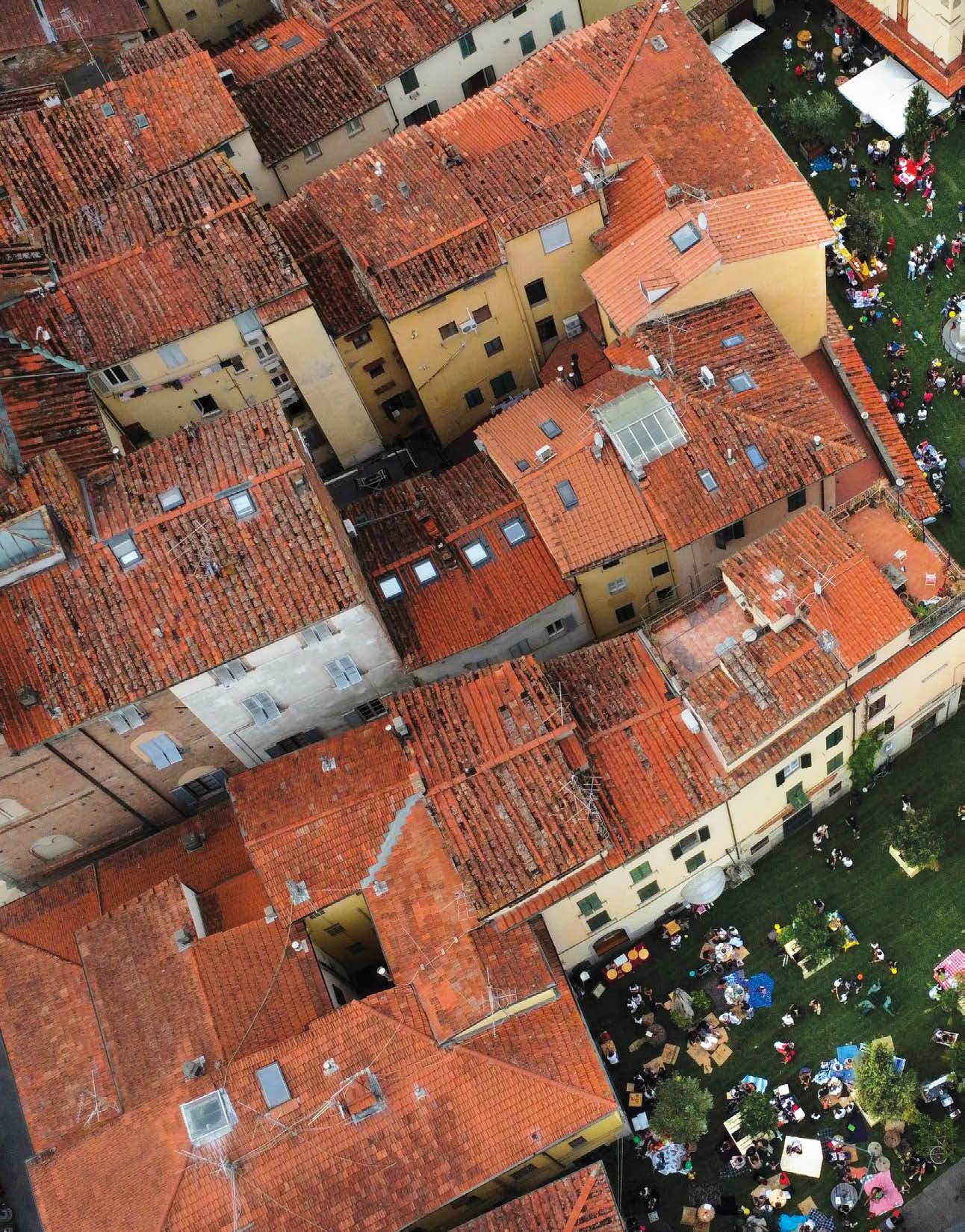
Pistoia e la sua identità
— Torna a Pistoia “Un altro Parco in città”, l’evento unico nel suo genere che per un intero week end colorerà di verde il cuore pulsante del centro storico, trasformandolo in un vero e proprio giardino con un meraviglioso prato verde e tante piante. Un’occasione importante per valorizzare glio obiettivi della filiera EDEN

Attività di promozione della filiera “EDENEfficientamento, ammodernamento e innovazione nel vivaismo nazionale” candidata al finanziamento del V Avviso MASAF n. 0182458 del 22/04/2022 e s.m. per la selezione dei Contratti di filiera e di distretto di cui al DM n. 0673777 del 22/12/2021

Sopra, Piazza della Sala durante la scorsa edizione di Un Altro Parco in Città, evento sempre molto partecipato del pubblico. In basso, l’area verde dedicata ai talk ed agli eventi, predisposta in Piazza Duomo, davanti al Palazzo Comunale.
Un Altro Parco in Città è un evento nato nel 2012 dall’idea di 6 giovani architetti di UAS Studio, con l’intento di coinvolgere la comunità cittadina su una tematica fondamentale: l’importanza del verde all’interno dei contesti urbani. Partendo da questo presupposto, il progetto negli anni è cresciuto sempre di più e oltre alla valorizzazione dell’identità green della nostra città, ha avuto un importante ruolo sociale di aggregazione, ma anche e soprattutto di sensibilizzazione verso tematiche sempre più attuali come il riciclo, la sensibilità, l’ambiente, l’energia e l’alimentazione.
Tutto questo tenendo conto anche che Pistoia, indiscussa capitale europea del verde e del vivaismo di piante ornamentali, è anche la “città dei giardini segreti”, i numerosi spazi verdi pubblici, semi pubblici e privati, nascosti dietro le mura medievali.
L’obiettivo della manifestazione, che rappresenta senza dubbio una festa sia per la comunità che per i turisti che giungono in città appositamente per vivere questa esperienza unica, è quello di voler rendere al giardino urbano la sua attrattività. Il verde urbano viene così restituito alla vita quotidiana dei cittadini, trasferendolo per tre giorni nei luoghi nevralgici del centro storico della città.
sviluppo della società moderna. Dallo scorso anno al consueto allestimento verde di Piazza della Sala e Piazza degli Ortaggi si sono aggiunti quello di Piazza dello Spirito Santo e quello, meraviglioso, di Piazza del Duomo - un’area green dove si svolgeranno numerosi importanti eventi, talk e dj set, per creare momenti di divulgazione su temi trasversali che si mescolano all’intrattenimento leggero.
Nelle vie e nelle piazze del centro storico pistoiese, dove da secoli si svolgono ciclicamente le attività cardine della vita cittadina, come il tradizionale mercato ortofrutticolo, la storia secolare della città trova il suo punto di incontro con i costumi delle generazioni future e presenti, diventando un perfetto palcoscenico per la restituzione del verde al suo ruolo principe, quello di aggregante sociale, fondamentale per lo
Il primo appuntamento in programma è per venerdì 13 settembre alle ore 17.00 in Piazza Duomo con il Talk “I campioni olimpici, modelli di ispirazione per i giovani” durante il quale il campione di basket e argento olimpico Giacomo “Gek” Galanda e il pistoiese Gabriele Magni, ex schermitore italiano e vincitore di una medaglia di bronzo alle Olimpiadi di Sydney 2000, condivideranno le proprie esperienze personali e professionali, raccontando come l’impegno e la costanza consentano di raggiungere grandi risultati nelle competizioni sportive più importanti a livello mondiale.
Sabato mattina in programma il convegno dell’Associazione Italiana Architetti Paesaggisti dal titolo “L’albero in città e la forestazione urbana: idee, progetti, pubblicazioni” seguito

nel pomeriggio, a partire dalle 17.00 da un talk dedicato al green e alla sostenibilità che vedrà la presenza di prestigiosi ospiti. Il primo sarà Folco Terzani, che a 20 anni dalla scomparsa e nel giorno del compleanno del padre Tiziano Terzani, presenterà il suo libro “A piedi nudi sulla Terra” raccontando le sue riflessioni sul mondo in cui viviamo e le idee alle quali è approdato nel corso del cammino che continua a proseguire.
A seguire, dopo la presentazione del progetto NATURART Village a cura di Marco Cappellini e Nicolò Begliomini, rispettivamente Direttore Generale e Responsabile Marketing e Comunicazione di Giorgio Tesi Group, il popolare attore Giovanni Storti, del trio “Aldo, Govanni e Giacomo”, presenterà il suo nuovo progetto “Immedia”, un portale e palcoscenico per un domani sostenibile: informazioni e (innov)azioni per aver cura delle generazioni future e del nostro mondo. Insieme ad Arianna Izzi, naturalista e divulgatrice scientifica, alla quale è affidata la direzione editoriale del progetto, racconteranno la filosofia ed il loro impegno volto a diffondere un modello più consapevole e più sostenibile del mondo, che sia di ”ispirazione e rivoluzione”.


Al termine, saluti e conclusioni, con distribuzione gratuita dell’ultimo numero della rivista NATURART. La serata si concluderà alle ore 21.00 con la presentazione del progetto fotografico “Visioni sul Territorio. Rapporto uomo natura”, un progetto che nasce dalla sinergia tra Studio Marangoni, scuola di fotografia di Firenze e Giorgio Tesi Group e che si inserisce in un lavoro di ricerca che vede lo studio del rapporto uomo/natura tra i temi centrali di indagine, con l’obiettivo di creare una ricerca che sia testimonianza del paesaggio e dei territori nonché delle dinamiche sociali e culturali che li abitano.
Domenica mattina appuntamento per bambini e famiglie alle ore 10.00 sempre in Piazza Duomo con NATURART Kids, l’evento – quest’anno organizzato in collaborazione con Aboca Erbeche attraverso il linguaggio dei bambini vuole tentare di cambiare il futuro del mondo partendo proprio dalle nuove generazioni. Saranno presentati due libri per bambini editi proprio
dall’azienda di Sansepolcro dal titolo “Il favoloso mondo delle piante” di Stefano Mancuso e Philip Giordano e “Pando, una storia vera” di Giorgia Conversi e Andrea Rivola. Al termine saranno organizzati dall’Impresa Sociale Germina, con la presenza
anche di Giorgia Conversi, laboratori didattici gratuiti per i più piccoli sui temi trattati nei due volumi presentati. Per l’occasione saranno posati oltre 3000 mq di manto erboso che sarà poi riutilizzato - come peraltro fatto fino dalla prima edizione – per ”curare” sia delle aree verdi trascurate che altre di utilità pubblica e sociale presenti nel tessuto urbano ed extraurbano.
L’edizione 2024 si fonda sulla partnership tra una serie di soggetti uniti per promuovere una crescita costante della manifestazione: gli organizzatori UAPC (che un anno fa, per il decimo anniversario, si è trasformato in un’Associazione di promozione sociale) e Consorzio Turistico Città di Pistoia, la Fondazione Caript, il Comune di Pistoia, Giorgio Tesi Group, Confcommercio Pistoia e Prato e Coldiretti Pistoia. Si tratta di un’iniziativa importante, che guarda con grande attenzione verso un futuro più sostenibile delle nostre città, concentrando l’attenzione sulle azioni utili a migliorare sempre più sia il nostro approccio verso la sensibilità ambientale che il coinvolgimento della cittadinanza per la riscoperta comune dell’identità cittadina.
Il popolare attore Giovanni Storti, del trio “Aldo, Govanni e Giacomo” sarà l’ospite d’onore di questa edizione di UAPC. Insieme ad Arianna Izzi, naturalista, divulgatrice scientifica, e direttore editoriale del progetto IMMEDIA racconteranno il loro impegno volto a diffondere un modello più consapevole e più sostenibile del mondo.
The successful actor Giovanni Storti from the trio “Aldo, Giovanni and Giacomo” will be the guest of honor of this edition of UAPC. Along with Arianna Izzi, naturalist, scientific disseminator and editorial director of the IMMEDIA project, he will narrate the commitment aimed at spreading a more aware and sustainable model of the world.
Attività di promozione della filiera “EDENEfficientamento, ammodernamento e innovazione nel vivaismo nazionale” candidata al finanziamento del V Avviso MASAF n. 0182458 del 22/04/2022 e s.m. per la selezione dei Contratti di filiera e di distretto di cui al DM n. 0673777 del 22/12/2021
From September 13 to 15, “Another park in the city” returns to Pistoia. It’s a one-of-a-kind event that, for a full weekend, will colour of green the beating heart of the old town, turning it into an actual garden with a wonderful green lawn and several plants.
Another park in the city, is an event that was born in 2012 from the idea of 6 young architects of UAS Studio, aimed at engaging the community of the city on a key topic: the importance of green within urban contexts. Starting from this assumption, the project has grown more and more over the years and, as well as enhancing the green identity of our city, it played a key social role of aggregation and, above all, it raised awareness about increasingly current issues such as recycling, sensitivity, environment, energy and nutrition.
UAPC è un evento unico nel suo genere che rappresenta senza dubbio una festa sia per la comunità cittadina che per i turisti che giungono in città appositamente per vivere questa esperienza pensata per restituire Il verde urbano alla vita quotidiana dei cittadini, trasferendolo nei luoghi nevralgici del centro storico di Pistoia.
UAPC is a one-of-a-kind event, that undoubtedly represents a celebration for both the local community and tourists who specifically come to the city to enjoy this experience, created to give back the urban green to the daily life of citizens and transfer it to the critical places of Pistoia’s old town.
All of this while also keeping in mind that Pistoia, the undoubted European capital of green and ornamental plant nurseries, is also the “city of secret gardens”, the several public, semi-public and private green spaces hidden behind the medieval walls.
The event is undoubtedly a celebration for both the community and the tourists who come to the city to live this unique experience; it aims a giving its attractiveness back to the urban garden. Therefore, the urban green is given back to the daily life of citizens and transferred for three days to the neuralgic places of the historic centre of the city.
In the streets and squares of the Pistoiese historic centre, where the key activities of the city life, such as the historical fruit and vegetable market, have been periodically going on for centuries, the secular history of the city finds its meeting point with the habits of future and present generations, becoming a perfect stage to give its key role back to the green: that of a tool for social aggregation, which is essential to develop modern society.
Compared to last year, the green stage of Piazza dello Spirito Santo and the wonderful stage of Piazza del Duomo have been added to the usual green stage of Piazza della Sala and Piazza degli Ortaggi. A green area dedicated to events, talks and DJ sets, to create moments of
dissemination on cross-cutting themes that are mixed with light entertainment. The first event is scheduled for Friday, September 13 at 5 PM in Piazza Duomo, with the talk “Olympic champions, role models for young people”, during which the basketball champion and winner of an Olympic silver medal, Giacomo “Gek” Galanda, and the Pistoiese Gabriele Magni, former Italian fencer and winner of a bronze medal at the 2000 Sydney Olympics, will share their personal and professional experiences and narrate how commitment and perseverance allow to achieve excellent results in the most important sport competitions at a global level. The conference of the Italian Association of Landscape Architects, entitled “Trees in the city and urban forestation: ideas, projects and publications”, is scheduled for Saturday morning. It will be followed, in the afternoon and starting from 5 PM, by a talk on green and sustainability that will be attended by prestigious guests. The first one will be Folco Terzani who, 20 years after the death of his father Tiziano Terzani and on the day of Tiziano’s birthday, will present his book “Barefoot on the Earth” and narrate his reflections on the world in which we live and ideas he matured during the journey that he’s continuing. Following this event and the presentation of the NATURART Village project, curated by Marco Cappellini and Nicolò Begliomini, respectively General Manager and Head of Marketing and Communication of Giorgio Tesi Group, the successful actor Giovanni Storti from the trio “Aldo, Giovanni and Giacomo” will present his new project, “Immedia”, a portal and stage for a sustainable future: information and (inno)vation to take care of future generations and our world. Along with Arianna Izzi, naturalist and scientific disseminator to whom we entrusted the editorial direction of our project, he will narrate the philosophy and commitment aimed at spreading a more and more aware and sustainable model of
the world, that can be both “inspiring and revolutionary”.
At the end of the event, greetings and conclusions with free distribution of the latest issue of the magazine NATURART. The evening will end at 9 PM, with the presentation of the photographic project “Visions on the territory. Man/nature relationship”, that was born from the synergy between Studio Marangoni, a photography school in Florence, and Giorgio Tesi Group, and fits consistently in a research work that sees the study of the man/nature relationship among the central topics of investigation, with the goal of creating research that is a testimony of the landscapes and territories, as well as the social and cultural dynamics that inhabit them. NATURART Kids, an event for children and families, is scheduled for Sunday morning at 10 AM, again in Piazza Duomo. The event – which, this year, is organized in partnership with Aboca Erbe – aims at trying to change the world through the language of kids, starting from new generations. Furthermore, there will be the presentation of two books edited by the company of Sansepolcro, whose titles are “The fabulous world of plants” by Stefano Mancuso and Philip Giordano and “Pando, a true story” by Giorgia Conversi and Andrea Rivola. At the end of the event, the social enterprise Germina, with the presence of Giorgia Conversi, will host free educational workshops for children, on the topics covered in the two presented volumes. On the occasion, over 3,000 square meters of turf will be laid. They will be then reused – as it has been done since the first edition – to “treat” both neglected green areas and other areas of public and social interest that can be found in the urban and extra-urban environment. The 2024 edition is based on the partnership between a few stakeholders that have come together to promote the continuous growth of the event: the organizers, UAPC (one year ago, for their tenth anniversary, they became an association for social advancement) and the Tourist Consortium of the City of Pistoia, the Caript Foundation, the Municipality of Pistoia, Giorgio Tesi Group, Confcommercio Pistoia and Prato and Coldiretti Pistoia. It’s an important initiative which looks with great attention towards a more sustainable future for our cities, focusing on actions that are useful to increasingly improve both our approach to environmental awareness and the involvement of citizens to jointly rediscover the city’s identity.

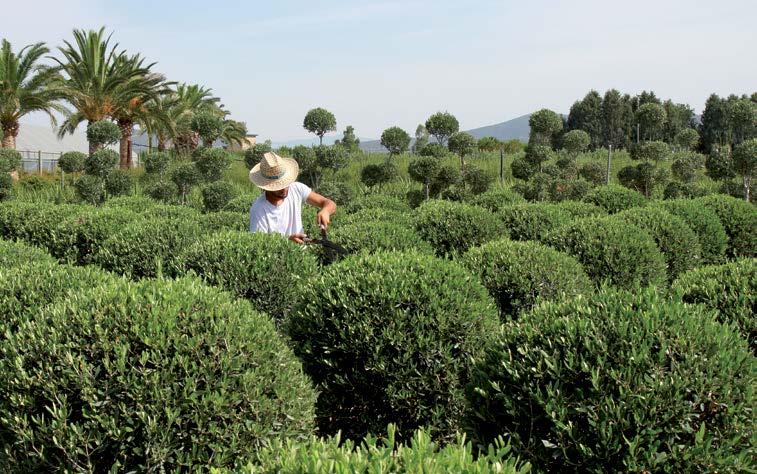
Il programma
EFFICIENTAMENTO, AMMODERNAMENTO E INNOVAZIONE
NEL VIVAISMO
NA-
ZIONALE – acronimo EDEN - mira a realizzare una vera e propria trasformazione green della filiera produttiva del vivaismo ornamentale italiano.
La strategia della filiera individuata dal contratto di filiera EDEN ha come obiettivo finale il riposizionamento in senso ecosostenibile del comparto del vivaismo ornamentale italiano fondandolo su un modello ecosostenibile.
Questo obiettivo generale sarà raggiunto generando dei nuovi paradigmi:
Produttivo: l’adozione di tecniche produttive completamente ecosostenibili, sia sul versante delle metodiche (agricoltura di precisione, sistemi di tele controllo, fertilizzazioni biocompatibili, ecc.) sia sul versante delle attrezzature e degli impianti, con una sostituzione del parco attuale con quelle di ultima generazione a basso/ nullo impatto ambientale sia sul versante dei materiali, con l’introduzione, anche a seguito del trasferimento tecnologico delle attività di ricerca e sviluppo degli Organismi di Ricerca, di metodiche di economie circolare.
Energetico: affrancamento progressivo dalle fonti energetiche fossili e loro sostituzione con fonti di energia rinnovabili, segnatamente fotovoltaico e biomasse da scarti di lavorazione
Ricerca e Innovazione: introduzione di nuovi processi (es. tecniche irrigue avanzate) e prodotti (es. substrati innovativi che richiedono minor impatto della chimica, vasetteria completamente biodegrabile ecc.) con contestuale trasferimento tecnologico alle imprese.
Promozionale: il nuovo posizionamento del settore del vivaismo ornamentale delle aziende che aderiscono al contratto verrà comunicato e veicolato sia attraverso opportune azioni di comunicazione che dei beneficiari diretti del progetto attueranno attraverso progetti di comunicazione pilota volti a mostrare le principali innovazioni che saranno trasferite dalle attività di ricerca e sviluppo alle imprese stesse, che anche attraverso fiere e mercati di settore, tramite alcuni progetti pilota. L’azione avrà lo scopo di creare informazione e educazione sulle caratteristiche peculiari della filiera e dei paradigmi oggetto dell’Accordo, agendo su aspetti quali la qualità, la riconoscibilità, l’autenticità, l’importanza del legame con il territorio d’origine, con i contesti territoriali, ambientali e di biodiversità, la trasparenza, la sicurezza e la sostenibilità ambientale, economica e sociale dei processi di produzione.
program EFFICIENCY,
NATIONAL NURSERY STOCK, known by the acronym EDEN, aims at completing an actual green transformation of the Italian ornamental nursery stock’s supply chain.
The strategy of the production chain detected by the supply chain agreement EDEN has the ultimate goal of repositioning, in an eco-sustainable way, the industry of Italian ornamental nursery stock, which should be based on an eco-sustainable model. This general goal will be achieved by generating new paradigms:
Production: the implementation of fully sustainable production techniques, in terms of both methodologies (precision agriculture, remote control systems, biocompatible fertilisations, etc.), equipment and facilities, thanks to a replacement of the current fleet with state-of-the art equipment and facilities with low/no environmental impact, and materials, thanks to the introduction of circular economy methodologies, also following the technological transfer of the research and development activities of research organisms.
Energy: progressive emancipation from fossil fuels and their replacement with renewable energy sources (specifically, photovoltaic systems and waste biomass.
Research and innovation: introduction of new processes (e.g., advanced irrigation techniques) and products (e.g., innovative substrata that require a lower chemical impact, fully biodegradable pots, etc.) with a concomitant technological transfer to companies.
Promotion: the new position of the industry of ornamental nursery stock for the companies that will adhere to the contract will be communicated and vehiculated through appropriate communication activities, carried out by the direct beneficiaries of the project through pilot communication projects aimed at showing the main innovations that will be transferred from the research and development activities to the companies themselves, and through a few pilot projects in the trade fairs and markets. The activity will aim at creating information and education on the peculiar characteristics of the supply chain and the paradigms that are the object of the agreement, and at intervening on aspects such as quality, recognisability, authenticity, the importance of the bond with the territory of origin and with the territorial, environmental and biodiversity contexts, transparency, safety and environmental, economic and social sustainability of production processes.
Attività di promozione della filiera “EDEN - Efficientamento, ammodernamento e innovazione nel vivaismo nazionale” candidata al finanziamento del V Avviso MASAF n. 0182458 del 22/04/2022 e s.m. per la selezione dei Contratti di filiera e di distretto di cui al DM n. 0673777 del 22/12/2021













— Anche quest’anno in programma l’evento che attraverso il linguaggio dei bambini vuole tentare di cambiare il futuro del mondo partendo proprio dalle nuove generazioni.

Attività di promozione della filiera “EDENEfficientamento, ammodernamento e innovazione nel vivaismo nazionale” candidata al finanziamento del V Avviso MASAF n. 0182458 del 22/04/2022 e s.m. per la selezione dei Contratti di filiera e di distretto di cui al DM n. 0673777 del 22/12/2021
Naturart Kids è diventato un importante appuntamento fisso dedicato a bambini e famiglie, con la presenza di autori e illustratori e l’organizzazione di laboratori didattici gratuiti per i più piccoli sui temi trattati dai volumi presentati.
Naturart Kids has become an important regular event dedicated to children and families, with the presence of authors and illustrators and the organization of free educational workshops for children, on the topics covered in the two presented volumes.

Le ultime due edizioni di Un Altro Parco in Città, evento unico e suggestivo che trasforma per due giorni il cuore pulsante del centro cittadino di Pistoia in un vero e proprio giardino con manto erboso e piante, sono state caratterizzate da importanti appuntamenti culturali come NATURART TALK, evento moderato dal popolare autore e conduttore Rai Federico Quaranta, con la partecipazione di personaggi di caratura nazionale come Antonio Pascale, Annalisa Corrado, Alessandro Gassmann e Massimo Mercati e NATURART KIDS, che ha visto lo scorso anno grandi e piccoli interagire e riflettere insieme anche alle ospiti Giulia Pastorino e Arianna Papini, autrici di libri per bambini di grande successo, su alcuni temi importanti come l’ambiente, la sostenibilità e il vivere bene in comunità, utilizzando il linguaggio dei bambini – universale e sempre in grado di trasmettere suggestioni e concetti a tutti, senza guardare all’età – tanto da essere perfetto per tentare di cambiare in meglio, partendo dalle nuove generazioni - il mondo in cui viviamo.
Il progetto NATURART KIDS, è un percorso partito nel 2018 con la realizzazione da parte di Giorgio Tesi Editrice dell’omonima collana di libri per bambini (Cosimo degli Alberi – Alla scoperta di una città dal cuore verde, Porrettana Express – Alla
scoperta della storica strada ferrata e della montagna che la circonda e San Iacopo – Storia del legame fra Pistoia e Compostela) illustrati da Michele Fabbricatore e scritti da Martina Colligiani, nati per raccontare e promuovere il territorio con un linguaggio semplice e coinvolgente per tutta la famiglia. Pistoia, oltre ad essere l’indiscussa capitale del verde, è anche una città a misura d’uomo presa ad esempio in tutta Europa per la bontà delle proposte educative per i più piccoli, dove da anni lavorano a stretto contatto in importanti progetti di promozione e valorizzazione del territorio e della comunità
enti, istituzioni e soggetti privati. Noi crediamo che lavorare tutti insieme per promuovere questa importante eccellenza espressa dalla nostra città sia assolutamente fondamentale soprattutto per consolidare e rafforzare sempre più l’identità di Pistoia.
Proprio per questo, in concomitanza con UPAC, evento importantissimo sia per la promozione territoriale che per il verde delle piante pistoiesi, protagoniste per un week end del centro cittadino, dopo che nel tardo pomeriggio di sabato 14 settembre sarà presentato al pubblico questo numero di NATURART alla presenza di prestigiosi ospiti, alle 10.00 di domenica 15 è in programma l’evento NATURART KIDS 2024, organizzato in collaborazione con Aboca Erbe, durante il quale oltre a riflettere e confrontarsi su importanti temi legati alla sostenibilità, al futuro del mondo e al bene comune, saranno presentati due libri per bambini editi proprio dall’azienda di Sansepolcro (Ar) dal titolo “Il favoloso mondo delle piante” di Stefano Mancuso e Philip Giordano e “Pando, una storia vera” di Giorgia Conversi e Andrea Rivola. Al termine saranno organizzati dall’Impresa Sociale Germina, con la presenza anche di Giorgia Conversi, laboratori didattici gratuiti per i più piccoli sui temi trattati nei due volumi presentati.

The event is scheduled also for this year: through the language of children, it aims at changing the future of the world starting with new generations.
The last two editions of Another Park in the City, a unique and suggestive event that, for two days, turns the beating heart of Pistoia city center into an actual garden with grass and plants, were characterized by important cultural appointments such as NATURART TALK, an event moderated by the popular RAI author and host Federico Quaranta, with the participation of characters of national profile such as Antonio Pascale, Annalisa Corrado, Alessandro Gassmann and Massimo Mercati, and NATURART KIDS where, last year, children and adults interacted and reflected together with the guests Giulia Pastorino and Arianna Papini, authors of successful books for children, on a few important topics such as environment, sustainability and wellbeing within a community. They used the language of children –which is universal and always capable of conveying suggestions and concepts to everybody, without looking at age -,


so much so that it’s perfect to try and change for the better, starting from new generations, the world in which we live.
The NATURART KIDS project is a journey that started in 2018, when Giorgio Tesi Publishing published the homonymous series of books for children (Cosimo degli Alberi – Alla scoperta di una città col cuore verde (Cosimo degli Alberi – Discovering a city with the green heart), Porrettana Express – Alla scoperta della storica strada ferrata e della montagna che la circonda (Porrettana Express –Discovering the historical railway and the mountains around it) and San Jacopo – Storia del legame tra Pistoia e Compostela (Saint James – History of the bond between Pistoia and Compostela), illustrated by Michele Fabbricatore and written by Martina Colligiani, which were born to narrate and promote the territory with a simple and engaging language for the whole family.

As well as being the undisputed capital of green, Pistoia is also a city on a human scale that is taken as example throughout Europe due to the quality of the educational proposals for children: bodies, institutions and private individuals have been working closely for several years on important projects to promote and enhance the territory and the community. In our opinion, working together to promote this important excellence expressed by our city is paramount to consolidate and strengthen even more the identity of Pistoia.
That’s why, concurrently with UPAC, a very important event to promote the territory and the green of the plants from Pistoia (the protagonists of the city centre for a whole weekend), and following the presentation to the public of this issue of NATURART in the late afternoon of Saturday, September 14th (in the presence of prestigious guests such as the well-known actor and champion of green and sustainability, Giovanni Storti), the event NATURART KIDS 2024 is scheduled for Sunday, September 15th at 10 AM. During this event, hosted in partnership with Aboca Erbe, we’ll reflect and debate on two important themes related to sustainability, the future of the world and the common good and we’ll present two books for children published by the company of Sansepolcro (Ar), whose title is “Il favoloso mondo delle piante” (“The fabulous world of plants”) by Stefano Mancuso and Philip Giordano and “Pando, una storia vera” (“Pando, a true story”) by Giorgia Conversi and Andrea Rivola. Following the event, some free didactic laboratories for children will be hosted to talk about the topics covered in the two presented volumes.
Attività di promozione della filiera “EDENEfficientamento, ammodernamento e innovazione nel vivaismo nazionale” candidata al finanziamento del V Avviso MASAF n. 0182458 del 22/04/2022 e s.m. per la selezione dei Contratti di filiera e di distretto di cui al DM n. 0673777 del 22/12/2021

Il mondo delle piante è pieno di storie straordinarie: alberi più vecchi delle piramidi, mondi sotterranei da esplorare, fiori che si travestono da vespe, supereroi vegetali senza cuore e senza cervello, pozioni per catturare la luce. Sembra una fiaba, invece è tutto vero, e ci riguarda da vicino. Forse non lo sapevate, ma senza le piante non ci saremmo nemmeno noi. Le piante ci donano ossigeno per respirare, ma anche cibo, sostanze per curarci, legno, fibre tessili per vestirci... e tanta bellezza. Dalle piante, infine, dipende il nostro futuro. Eppure ne sappiamo pochissimo…
Entriamo allora in punta di piedi nel mondo vegetale e lasciamoci avvolgere dalla sua magia. Sarà un viaggio sorprendente, ricco di scoperte incredibili. Una grande avventura, verde di clorofilla e gialla di polline.
Stefano Mancuso è professore ordinario presso l’Università di Firenze e dirige il Laboratorio Internazionale di Neurobiologia Vegetale. È stato incluso dal“New Yorker”tra coloro che sono ‘destinati a cambiarci la vita’. Autore di numerosi libri, tradotti in più di venti lingue, per Aboca Edizioni ha pubblicato Botanica. Viaggio nell’universo vegetale (2017, nuova edizione 2021) e Discorso sulle erbe. Dalla botanica di Leonardo alle reti vegetali (2019, con Fritjof Capra).

Philip Giordano, nato in Liguria da madre filippina e padre svizzero, è un illustratore e autore italiano che vive tra il Giappone e l’Italia. I suoi libri, pubblicati in oltre 20 paesi, hanno ricevuto numerosi riconoscimenti, tra cui il Premio Internazionale d’Illustrazione della Bologna Children’s Book Fair –Fundacion SM, il Garden Book of the Year della Garden Media Guild e il premio Andersen per il miglior albo.
È stato inoltre finalista al prestigioso premio The Young People’s Book Prize della Royal Society di Londra.
Editore: ABOCA Edizioni – Collana ABOCA Kids
Autori: Stefano Mancuso e Philip Giordano
Età: 6+
Pagine: 48
Prezzo: € 20,00


Chi dice “io” in questo libro? L’orso nero che dormicchia sotto la coperta, il cervo mulo dispettoso, l’alce che gioca a nascondino o il bruco pigro? A ogni pagina vi sembrerà di saperlo, e a quella dopo vi accorgerete che non è così. Perché a volte le cose grandi sono le più difficili da vedere, e un albero con cinquantamila gambe non si sa bene dove abbia gli occhi... Questa è la storia vera di Pando, l’albero più grande, grosso e vecchio del mondo, in una narrazione che, tronco dopo tronco, si addentra nel cuore di un prodigio della natura che sfida la nostra immaginazione e ci fa sognare. Pando è uno dei più grandi organismi viventi al mondo. Sembra un bosco di 47 mila pioppi tremuli, in realtà è un unico pioppo che continua a riprodursi tramite polloni, nello Utah. È una creatura che oltrepassa la nostra dimensione, quella temporale e quella spaziale, e perfino la nostra immaginazione fatica a comprendere la natura di questo organismo. La storia di Pando, il cosiddetto essere vivente più vecchio della terra, ebbe inizio più di 80.000 anni fa. Il suo nome deriva dal latino pandere, distendere, espandersi quindi, e mai appellativo fu più appropriato visti i suoi 44 ettari di superficie coperta.
Giorgia Conversi, milanese per affinità elettiva, da anni esplora l’universo dei
libri, sperimentando forme e linguaggi. È elastica, ma lavora da sempre con lo stesso art director. Ama le scritte sui muri e le macchine fotografiche che fanno clic. Ha scritto la serie Dadà, i mini-supereroi dalla parte dei più piccoli, vincitrice del Bologna Ragazzi Digital Award e del Premio Andersen per le creazioni digitali.
Andrea Rivola, laureato al Dams Arte di Bologna, vive a Riolo Terme, immerso nei paesaggi campestri della Valle del Senio in compagnia di inseparabili e

variegati personaggi creati dalle sue matite immaginifiche.
Appassionato illustratore, ha pubblicato più di cinquanta libri in Italia e all’estero e collabora con il “Corriere della Sera”.
Editore: ABOCA Edizioni – Collana
ABOCA Kids
Autori: Giorgia Conversi - Andrea Rivola
Formato: cm 24 x 28,8
Pagine: 40
ISBN: 9788855232562
Prezzo: € 18,00

Attività di promozione della filiera “EDENEfficientamento, ammodernamento e innovazione nel vivaismo nazionale” candidata al finanziamento del V Avviso
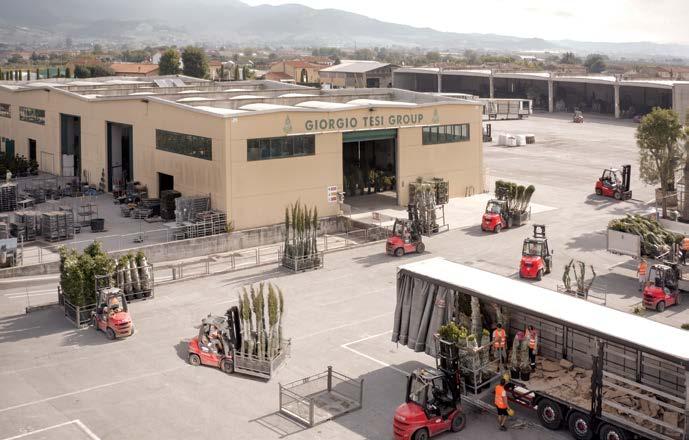

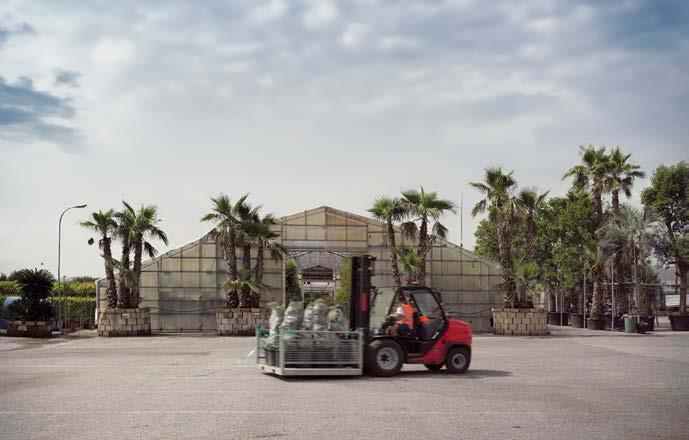

Il prossimo Autunno sarà pubblicata tramite i propri canali web e social
la
prima puntata della serie realizzata da Manitou.
Si tratta di 6 puntate, registrate dal Nord al Sud Italia, dedicate a realtà imprenditoriali e partner eccezionali che per la propria attività hanno scelto di utilizzare le soluzioni di Manitou.
Il lancio ufficiale avverrà i primi giorni di Ottobre e riguarderà l’episodio dedicato alla Giorgio Tesi Group. Infatti, grazie al concessionario ufficiale presente in loco, la EnneCi Macchine S.r.l. con sede ad Agliana (Pistoia), è nata una vera e propria amicizia tra il costruttore francese e questo top player del florovivaismo.
Il Gruppo Manitou infatti è una multinazionale nata ad Ancenis, nei pressi
di Nantes in Francia oltre 60 anni fa, la quale progetta, costruisce e distribuisce le proprie soluzioni in tutto il mondo: sollevatori telescopici, carrelli elevatori, piattaforme aeree così come minipale, terne e tanto altro. Il fatturato del Gruppo Manitou nel 2023 è stato pari a 2,9 Miliardi di euro.
Durante la puntata sarà possibile osservare i mezzi che tutti i giorni svolgono le proprie operazioni all’interno dello splendido vivaio della famiglia Tesi, dallo scarico al carico, la movimentazione a 360°, fino a supportare le operazioni di piantumazione. Non può inoltre mancare il Giardino della Mente, parte
del progetto Growing Creativity, il futuro Naturart Village di prossima apertura, così come un’intervista speciale al campione di pallacanestro Giacomo Galanda e al Sig. Romeo Tesi. Si tratta dell’episodio che avvia questo importante progetto, che vedrà la pubblicazione di una nuova puntata ogni due settimane. Una bella opportunità per osservare e conoscere da vicino tutti i segreti, le caratteristiche e i colori che contraddistinguono una splendida realtà come la Giorgio Tesi Group. Vi invitiamo a cercare online la Web Serie di Manitou, commentando e condividendo, siamo sicuri che vi piacerà!



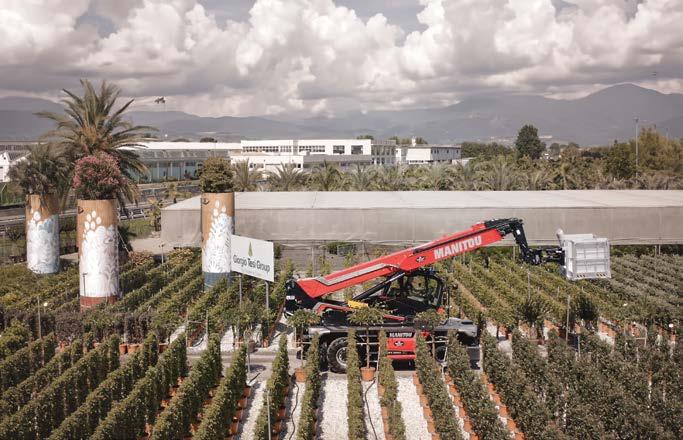
Next Autumn, Manitou will publish the first episode of its series via its web and social channels.
There will be 6 episodes, shot from Northern to Southern Italy, dedicated to entrepreneurial realities and exceptional partners that chose to use Manitou’s solutions for their activity. The official launch will take place in the first days of October, with the episode dedicated to Giorgio Tesi Group. In fact, thanks to the official local distributor (Enneci Macchine S.r.l., located in Agliana (Pistoia), a true friendship was born between the French manufacturer and this top player of the nurserystock industry.
Manitou Group is a multinational company born in Ancenis, near Nantes (France), over 60 years ago. It designs,
builds and distributes its solutions throughout the world: telescopic handlers, forklifts, aerial platforms as well as skid steer loaders, backhoe loaders, and much more. In 2023, Manitou Group had a turnover of 2.9 billion euros. During the episode, you’ll be able to observe the vehicles that, every day, carry out their activities within the wonderful nursery owned by the Tesi family: from unloading to loading, 360-degree handling and tree planting activities. The Mind Garden, part of the Growing Creativity project, will also be there: same goes for the future Naturart Village, that will open soon. There will
also be a special interview with the basketball champion Giacomo Galanda and Mr. Romeo Tesi.
This is the episode that starts this important project, which will see the publication of a new episode every two weeks. A nice opportunity to observe and get to know closely all the secrets, features and colours that distinguish a wonderful reality like the Giorgio Tesi Group.
We invite you to search online the Web Series of Manitou, commenting and sharing, we are sure you will like it!

— Queste tre parole per sintetizzare i programmi di Luca Gori, nuovo Presidente della Fondazione Caript
Prima di tutto, complimenti per la sua elezione e buon lavoro!
Lei è attualmente il più giovane presidente fra tutte le Fondazioni di origine bancaria in Italia…
Innanzitutto, grazie per l’augurio e, per quanto riguarda il primato anagrafico, devo dire che probabilmente solo in Italia fa notizia una presidenza affidata a un quarantenne. In ogni caso, al di là del dato personale, dedicherò particolare attenzione al ricambio generazionale, insieme ai temi della parità di genere e, per quel che riguarda il territorio pistoiese, di un’adeguata rappresentanza delle diverse aree. Servirà l’impegno di un grande numero di soggetti, dalle associazioni agli enti locali, dai cittadini alle imprese, per realizzare progetti innovativi e che abbiano un forte impatto sulla comunità.
Come intende svolgere questo ruolo anche alla luce della sua formazione specifica per quanto riguarda il Terzo Settore?
I miei interessi di ricerca accademici sono principalmente legati alla disciplina giuridica di questo settore e anche sul piano culturale lo considero il mio mondo di provenienza. Un Terzo Settore forte è una risorsa molto importante perché
la comunità possa essere coesa, economicamente, socialmente e culturalmente sviluppata. Per questo, la Fondazione continuerà a sostenere in modo particolare il settore. Inoltre, consolidarne conoscenze e competenze attraverso formazione, consulenze qualificate e innovazione potrà assicurare che le risorse destinate abbiano ricadute efficaci sulla qualità della vita delle persone.
Quali sono i suoi obiettivi di mandato?
Oggi le fondazioni non operano più come enti tendenzialmente erogativi, ma agiscono da veri e
propri attori delle libertà sociali, agevolando, promuovendo e favorendo il cambiamento in ambiti cruciali per la comunità. Il nostro obiettivo, dunque, è impegnarci per una solidarietà moderna, che non sia una mera forma di beneficenza, ma risponda a una visione di comunità più equa, tenendo insieme prospettive culturali, sociali, politiche ed economiche. Questo, tra l’altro, significa rinunciare a interventi di piccolo cabotaggio o con orizzonti limitati, evitando allo stesso tempo la tentazione di sperimentazioni che non riescano poi a strutturarsi in interventi stabili.
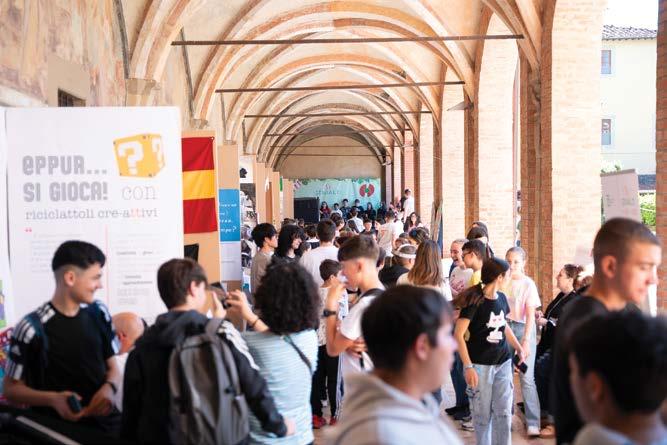
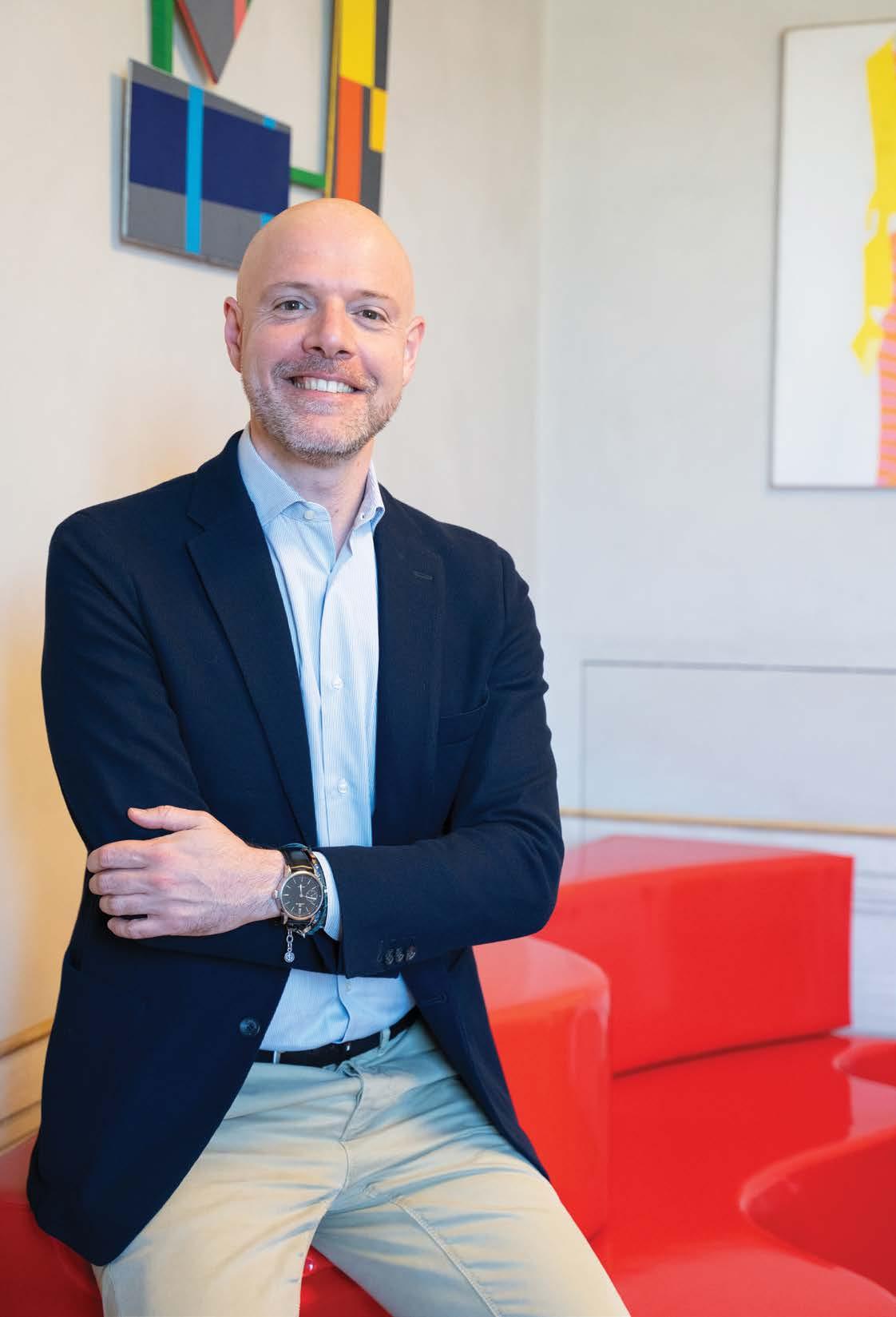

Per raggiungere risultati importanti è necessario aggregare risorse e soggetti, sia pubblici che privati.
Quali potrebbero essere le azioni per cercare di rafforzare l’identità della nostra città in un panorama nazionale e internazionale in continuo sviluppo?

Nel suo programma è sottolineata l’attenzione per le cosiddette aree interne, a iniziare dalla montagna. Pensa che lo sviluppo passi anche da questi territori?
In alto a sinistra un momento dell’Open Day di Gea. A destra invece, un’immagine scattata durante il Festival di antropologia “Dialoghi di Pistoia”. Accanto la presentazione del Masterplan della Valdinievole commissionato dalla Fondazione Caript allo studio Boeri di Milano.
At the top left, a moment of Gea’s Open Day. On the right, an image taken during the anthropology festival “Dialogues of Pistoia”. Next to it, a presentation of the masterplan of Valdinievole commissioned by the Caript Foundation to the Boeri studio in Milan.
Una sfida decisiva ci sembra quella di riuscire a mettere insieme soggetti di natura diversa ma legati da obiettivi comuni e farli lavorare in un’unica direzione. Secondo lei sarà possibile vincerla sul nostro territorio?
Ovviamente, per raggiungere risultati importanti è necessario aggregare risorse e soggetti, sia pubblici che privati, dal Terzo Settore al mondo delle imprese in modo da agevolare e sostenere cambiamenti che, pur radicati nel contesto locale, siano allo stesso tempo connessi alle grandi evoluzioni globali. Si tratta di mettere in atto quella “sussidiarietà in azione” che, a esempio, stiamo sperimentando con la Fondazione delle comunità pistoiesi, con il progetto del Masterplan della Valdinievole e, soprattutto, con il percorso per insediare a Pistoia un nuovo polo di formazione, ricerca e trasferimento tecnologico dell’Università di Firenze.
Pistoia è ormai l’indiscussa capitale europea del verde e del vivaismo di piante ornamentali.
La Fondazione può stimolare soggetti a investire in chiave innovativa sui punti di forza più qualificanti del nostro territorio. Questo potrà contribuire a uno sviluppo economico stabile e basato sulle vocazioni produttive. In quest’ottica, il vivaismo è uno degli asset fondamentali al quale, tra l’altro, è rivolto l’impegno di GEA, nostro ente strumentale, che ha per missione innovare il sistema agricolo, valorizzare il territorio, diffondere una cultura green e favorire la nascita e la crescita di imprese sostenibili.
Sicuramente bisogna tenere conto delle specificità e della complessità della provincia di Pistoia, dove ci sono aree con caratteristiche differenti: oltre alla città, la Piana, legata all’area metropolitana pratese e fiorentina; la Valdinievole, che guarda anche a Lucca e Pisa e la montagna, dove si assiste a un forte spopolamento e alla perdita di servizi e attività imprenditoriali. Tenere conto di queste specificità è importante e, per questo, punteremo su progetti che valorizzano le risorse locali per migliorare qualità della vita, turismo, imprenditoria e sviluppo green.
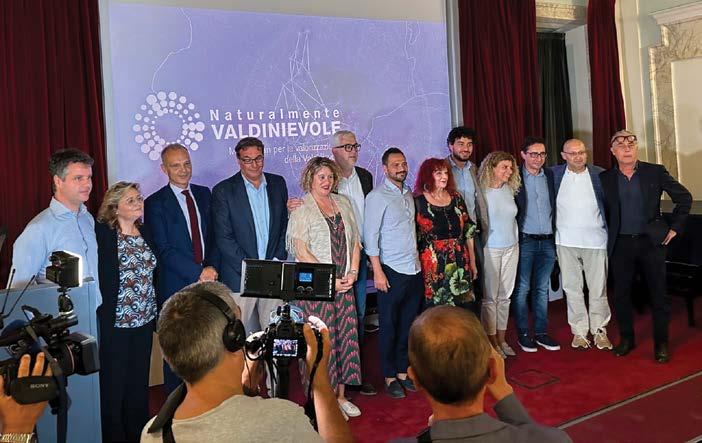

—
These three words summarize the programmes of Luca Gori who is the new President of the Caript Foundation.
First of all, congratulations for your election and good luck with your work!
You’re currently the youngest president among all the bank foundations in Italy…
First of all, thanks for the good wishes; as regards the demographic record, I must say that only in Italy it’s a news when a presidency is entrusted to a forty-year-old. Anyway, beyond this personal information, I will pay particular attention to the generational change, along with the topics of gender equality and, as regards the territory of Pistoia, an adequate representation of the different areas. We will need the commitment of several stakeholders, from associations to local bodies, from citizens to businesses, to complete innovative projects with a strong impact on the community.
How do you intend to fulfil this role, also in view of your specific education as regards the Third Sector?
My academic research interests are mainly related to the legal regulations of this sector and, also on the cultural level, I regard it as my original world. A strong Third Sector is a very important resource so that the community can be cohesive and economically, socially and culturally developed. Therefore, the Foundation will continue to support this sector in a special way. Furthermore, by consolidating knowledge and skills through training, qualified consultancy and innovation, we’ll ensure that the allocated resources have an effective impact on people’s quality of life.
What are your goals for this mandate?
Today foundations do not longer operate as a disbursing body, generally, but rather as actual stakeholders of social freedoms, by facilitating, promoting and favouring change in crucial contexts for our community. Therefore, our goal is to commit to a modern solidarity, that is not a pure form of charity, but is in line with a fairer vision of community and holds together cultural, social, political and economic prospects. Among other things, this means to give up small interventions with limited horizons and, at the same time, to avoid the temptation of experiments that can’t be structured in stable interventions.
We think that a decisive challenge is to manage to bring together individuals of a different nature who, however, are linked by shared goals and have them working in one direction. Do you think we’ll be able to win this challenge in our territory?
Obviously, to reach important goals, we must bring together both public and private resources and individuals, from the Third Sector to the business world, so that we can facilitate and support changes that, even though they are rooted in the local context, are at the same time connected to the big global
changes. It’s about putting in place that “subsidiarity in action” that, for example, we’re experimenting with the Foundation of Pistoiese communities, with the project of the masterplan for the enhancement of Valdinievole and, above all, with the path to establish a new training, research and technological transfer pole of the University of Florence.
Pistoia is now the undisputed European capital of green and ornamental plant nurseries. What may be the actions to try and strengthen the identity of our city within a national and international landscape that is continuously developing?
The Foundation can motivate the different stakeholders to invest, in an innovative way, in the most qualifying strengths of our territory. This may contribute to a stable economic development, based on production vocations. With this in mind, nurseries are one of the key assets to which GEA, our instrumental body, commits. Its mission is to innovate the agricultural system, enhance the territory, spread a green culture and promote the birth and growth of sustainable businesses.
In your programme, we highlighted the need for the so-called internal areas, starting from the mountains. Do you think that development may involve also these territories?
We must definitely keep in mind the specificity and complexity of the province of Pistoia, where there are areas with different characteristics: not only the city, but also the plain, that is linked to the metropolitan area of Prato and Florence; Valdinievole, that also pay attentions to what happens in Lucca and Pisa, and the mountains, where we can witness a strong depopulation and the loss of entrepreneurial services and activities. Keeping in mind this specificity is important and, therefore, we must bet on projects that enhance local resources to improve quality of life, tourism, entrepreneurship and green development.


Palazzo de’ Rossi | Collezioni del Novecento
— Alla sua terza edizione, al via a fine settembre In Visita, dedicato all’artista Maria Lai. Esposta l’opera Senza titolo (Geografia), grande tela cucita, eseguita tra il 1982 e il 1988, in prestito da Intesa Sanpaolo
Il progetto In Visita di Fondazione Pistoia Musei nasce con l’intento di creare momenti di dialogo e confronto, offrendo al pubblico esposizioni di una sola opera che consentano un rapporto più intimo con l’arte: momenti di approfondimento su autori, temi e correnti culturali dei secoli 20° e 21° all’interno del percorso permanente di Collezioni del Novecento a Palazzo de’ Rossi.
MThe In Visita project by Pistoia Musei Foundation was born with the purpose of creating moments of dialogue and debate and offering to the audience singlework exhibitions that allow to establish a more intimate relationship with art. A few in-depth discussions on authors, topics and cultural trends from the XX and XXI centuries will be held within the permanent itinerary of Collezioni del Novecento at Palazzo de’ Rossi.
ai come in questa occasione la proposizione di Pistoia Musei di offrire al pubblico esposizioni destinate a un rapporto più intimo con i visitatori è stata più appropriata, visto che un desiderio di Maria Lai era quello di poter avere l’occasione di organizzare mostre di poche opere da offrire alla relazione dello spettatore in un dialogo diretto e personale.
L’opera esposta in questa edizione di In Visita, una delle (Geografie) elaborate da Maria Lai lungo gli anni Ottanta parallelamente alle Tele, alle Fiabe e ai Libri cuciti è una testimonianza rappresentativa del lavoro dell’artista sarda e della sua pratica creativa incentrata sul potere simbolico e relazionale intrinseco all’uso del filo come elemento di collegamento tra entità diverse e come strumento narrativo. Questa modalità operativa offre spunti di riflessione su temi universali connessi ai miti femminili della tessitura, dove il filo è simbolo della vita e della conoscenza. Le (Geografie) sono grandi stoffe cucite in cui fili che disegnano planisferi con meridiani e paralleli. Vi si sovrappongono rette che tracciano traiettorie tese fuori dal limite del supporto e scritture illeggibili che evocano narrazioni. In alcuni punti, l’inserimento di elementi geometrici in tessuto colorato sembra voler
— The third edition of In Visita will start in late September and is dedicated to the artist Maria Lai. The work Untitled (Geography), a large stitched canvas completed between 1982 and 1988, is exhibited; it is borrowed from Intesa Sanpaolo.
Pistoia Musei aims at offering to the audience exhibitions that are designed to establish a more intimate relationship with visitors, and such purpose has never been more appropriate. In fact, Maria Lai wished to host exhibitions with just a few works on display, so that she could offer a direct and personal dialogue to the observer.
mettere in evidenza zone di crisi in un mondo fragile. Malgrado il loro ricondursi all’ambito geografico, quelle di Lai sono rappresentazioni, mappe, che non rimandano alla descrizione ‘oggettiva’ di luoghi specifici. Esse hanno la capacità di proiettarci nella dimensione del viaggio, ponendoci nei panni di un viandante a cui sia donata la facoltà di esplorare il proprio piccolo cosmo avendo contemporaneamente la percezione che esso è parte di un mondo più vasto che lo ricomprende. Guardando queste tele, procedendo lungo gli itinerari visivi, sempre diversi, tracciati dal filo, si ha l’impressione di essere all’interno e all’esterno della mappa, al confine tra terra e cielo, tra territorio finito e spazio infinito.
Come atto conoscitivo e ‘immaginativo’ del mondo, il tema della geografia è per l’artista anche tensione verso spazi ignoti, metafora di un viaggio verso l’altrove che, nel momento presente, può divenire narrazione di un viaggio individuale e collettivo: l’errare dell’esistenza umana, la migrazione, il pellegrinaggio. Ecco perché l’opera Senza titolo (Geografia), oltre che sollecitare in chi guarda un’esperienza estetica visibile e tattile, stimola a una narrazione in cui particolare e generale, accadimento quotidiano e storia universale possano essere ricompresi.
The work exhibited in this edition of In Visita comes from the Geographies series, completed by Maria Lai during the 1980s along with her stitched canvas, books and fairytales. It is a representative testimony to the work of the Sardinian artist and her creative practice, focused on the symbolic and relational power that is inherent to the use of threads as a binding
Per approfondimenti:
Elena Pontiggia, Maria Lai. Arte e relazione, Nuoro, Illisso, 2017.
Maria Lai. Tenendo per mano il sole, a cura di Bartolomeo Pietromarchi e Luigia Lonardelli, catalogo della mostra, Roma MAXXI, 2019-2020, Milano, 5 Continents, 2019.
Enrico Crispolti, Maria Lai, Io sono Sardegna, a cura di Silvia Loddo, Archivio Parlante, Macerata, Quodlibet, 2021. www.fondazionemarialai.it

element between different entities and as a narrative tool. This way of working offers insights on universal topics, which are connected to the feminine myths of weaving, where threads become a symbol of life and knowledge. Geographies are large cloths stitched with threads that draw planispheres with meridians and parallels, which are juxtaposed with straight lines that trace flat trajectories outside the limits of the support and illegible handwriting that evokes narrations. In a few points, the insertion of geometric elements in coloured fabric seem to highlight a few crisis zones in a fragile world. Despite they can be attributable to the geographic context, the works by Lai are representations, maps that do not refer to “objective” description of specific places. They are capable of projecting us into the dimension of travel and putting us in the shoes of a wanderer who’s given the power to explore their own small cosmos and, at the same time, perceives that such small cosmos is part of a wider world that encompasses it. When we look at these canvases and we proceed along visual itineraries that are always different and traced by threads, we have the impression of being inside and outside the map, at the border between earth and sky, finite territory and infinite space.
As an act of knowledge and imagination of the world, the topic of geography represents for the artist also the tension towards unknown spaces, the metaphor of a journey towards the elsewhere that, currently, can become the narration of an individual and collective journey: the wandering of human existence, migration, pilgrimage. That’s why the Geographies series, as well as eliciting in the observer a visible and tactile aesthetic experience, encourages us to engage in a form of narration that can encompass the particular and the general, daily events and universal history.
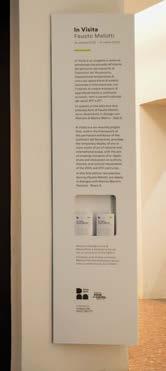
“Giungiamo alla terza edizione di In Visita, un progetto che ho fortemente voluto per ampliare le prospettive di studio e riflessione intorno a Collezioni del Novecento. Questa edizione è speciale per me, poiché portiamo a Pistoia un’opera di Maria Lai, artista sarda di fama internazionale, mai esposta prima nella nostra città. La scelta di quest’opera, una Geografia, è stata determinata anche dalla contingenza storica: il tema, con le sue implicazioni simboliche e geopolitiche, appare oggi più rilevante che mai, evocando riflessioni su frontiere, conflitti, esistenza umana e memoria collettiva”.
“We have now reached the third edition of In Visita, a project that I strongly wanted to expand the perspectives for study and reflection about Collezioni del Novecento. This edition is special for me, because we are bringing to Pistoia a work by Maria Lai, a Sardinian artist of international fame, that has never been exhibited in our city. The choice of this work, from the Geographies series, was also driven by the historical contingency: the topic, with its symbolic and geopolitical implications, is more relevant now than ever and evokes reflections on borders, conflicts, human existence and collective memory”.
Monica Preti, Direttrice generale, Fondazione Pistoia Musei
In Visita, arrivato alla sua terza edizione, è un progetto di Fondazione Pistoia Musei fortemente voluto per ampliare le prospettive di studio e riflessione intorno a Collezioni del Novecento.
In Visita has now reached its third edition; it’s a project by Pistoia Musei Foundation and the project was strongly wanted to expand the perspectives for study and reflection about Collezioni del Novecento.

Nasce a Ulassai nel 1919. A Cagliari incontra lo scrittore Salvatore Cambosu, suo professore all’Istituto Magistrale; nel 1934 riceve prime lezioni di scultura da Francesco Ciusa. Nel 1939 lascia la Sardegna per frequentare il Liceo Artistico di Roma dove studia con Renato Marino Mazzacurati. Nel 1943 si trasferisce a Venezia: all’Accademia di Belle Arti è allieva di Arturo Martini, segue le lezioni di Mario Deluigi e Alberto Viani. Nel 1945 torna in Sardegna dove rimane sino al 1956: a Cagliari insegna all’Istituto Tecnico Femminile; riprende l’amicizia con Cambosu, conosce lo scrittore Giuseppe Dessì. Tornata a Roma, nel 1957 tiene la prima personale alla Galleria dell’Obelisco. Delusa dall’attenzione ricevuta dalla critica, per circa un decennio abbandona quasi del tutto l’attività espositiva, iniziando un periodo di riflessione artistica in stretto dialogo con poeti e scrittori. Grazie anche allo scambio con Giuseppe Dessì riscopre il senso del mito e delle leggende della sua terra, sperimentando con strumenti e materiali della tradizione artigianale sarda come il tessuto, il pane, la creta. Nel 1971 alla Galleria Schneider di Roma espone i primi Telai, composizioni di fili, legno e stoffe. Dalla metà degli anni Settanta e lungo gli anni Ottanta si dedica alle Tele cucite, realizza i Libri cuciti, le Geografie. Progressivamente estende la sua sfera di azione al teatro, si apre a interventi di dimensione ambientale in relazione con il paesaggio e con le comunità del territorio. Nel 1981 a Ulassai realizza l’azione di arte partecipata Legarsi alla Montagna anticipando i temi e i metodi dell’arte relazionale. Nel 1983 realizza la prima Fiaba cucita, Tenendo per mano il sole. Nel 1993 si stabilisce definitivamente a Cardedu. Nel 2006 si apre Stazione dell’Arte, il museo di arte contemporanea a lei dedicato a Ulassai. Nel 2011 vince il Premio della Camera dei deputati per il 150° Anniversario dell’Unità d’Italia. Muore a Ulassai nel 2013. Nel 2017 importanti riconoscimenti sono tributati alla sua opera alla 57ᵃ Biennale Internazionale d’arte a Venezia e a Documenta a Kassel; nel 2019 il Museo MAXXI di Roma, in collaborazione con Archivio Maria Lai e Fondazione Stazione dell’Arte, le dedica una prima grande retrospettiva in occasione del centenario della nascita.
In Visita. Maria Lai
22 settembre 2024 – 23 febbraio 2025
Palazzo de’ Rossi | Collezioni del Novecento Pistoia, Palazzo de’ Rossi, via de’ Rossi, 26
A cura di Monica Preti e Annamaria Iacuzzi
Catalogo: Gli Ori, Pistoia, 2024 con testi di Francesco Tedeschi, Monica Preti, Annamaria Iacuzzi
Inaugurazione: 21 settembre 2024

Foto

Camerata strumentale di Prato
— A ventisei anni dalla sua fondazione, la Camerata strumentale di Prato è oggi, oltre che una delle principali Orchestre da camera italiane, un’officina di attività intese a far crescere la cultura dell’ascolto e a consolidare lo spirito di comunità.

ALa Camerata strumentale di Prato
è nata nel 1998 da un’idea di Riccardo Muti e dalla partecipazione di forze pubbliche e private ed e è sostenuta dal Comune di Prato e dalla Fondazione Cassa di Risparmio di Prato, oltre che dalla Regione Toscana e dal Ministero della Cultura.
The Instrumental Camerata of Prato was born in 1998 from an idea by Riccardo Muti and the participation of public and private strengths and is supported by the Municipality of Prato and the Cassa di Risparmio Foundation of Prato, as well as the Tuscany Region and the Ministry of Culture.
ventisei anni dalla sua fondazione, la Camerata strumentale di Prato è oggi, oltre che una delle principali Orchestre da camera italiane, un’officina di attività intese a far crescere la cultura dell’ascolto e a consolidare lo spirito di comunità. L’integrazione con la Scuola comunale di Musica «G. Verdi» di Prato ha amplificato la vocazione che la Camerata strumentale ha perseguito fin dai suoi esordi, quella di far diventare l’Orchestra uno strumento di avvicinamento consapevole alla musica, disponibile per tutti, dai più piccoli fino alla terza età, una missione che è resa ancor più efficace grazie alla residenza condivisa dall’Orchestra e dalla Scuola nel Palazzo della Musica di Prato.
In virtù dell’intenso lavoro di educazione musicale che l’Orchestra ha sempre svolto, decine di migliaia di giovani pratesi hanno avvicinato la musica d’arte potendo contare su una adeguata preparazione e su una guida all’ascolto; la stessa attenzione è stata rivolta al pubblico adulto delle Stagioni concertistiche. Dallo spirito che ha sempre animato la Camerata sono nati progetti e laboratori, come l’Orchestra di ragazzi «Prato Sinfonietta» e il Coro «Città di Prato», complessi che coinvolgono centinaia di partecipanti nella gioia di far musica, affiancati dai professori della Camerata. Inoltre l’Orchestra fa parte
dell’ambizioso progetto cittadino «Prato Comunità Educante» promosso dalla Fondazione Cassa di Risparmio pratese. Queste iniziative hanno trovato un ispiratore e un moltiplicatore d’entusiasmo nel direttore musicale Jonathan Webb, che guida l’Orchestra dal 2014. Un importante simbolo dello spirito di coinvolgimento attivo è stata nel maggio 2016 la produzione di Noye’s Fludde di Benjamin Britten, il cui allestimento condiviso da tanti cittadini piccoli e grandi ha segnato per Prato un momento di nuova partenza e di rinascita. Allo stesso modo, la rappresentazione nel marzo 2019 di Wir bauen eine Stadt di Paul Hindemith e Mahagonny
Songspiel di Kurt Weill, in un dittico inedito, ha avuto l’obiettivo di mostrare la forza armoniosa della musica come modello di una società ideale.
Come organismo musicale che si fa strumento di inclusione e partecipazione, la Camerata strumentale ha voluto festeggiare i venticinque anni di vita commissionando al compositore britannico John Barber una nuova «Opera da chiesa», The Song of the Ladder, un dono a tutta la comunità pratese. Ispirato esplicitamente al modello britteniano dell’Arca di Noè, il nuovo lavoro ha visto la luce nel maggio del 2023 nella Chiesa di San Domenico. L’allestimento, coprodotto col Teatro Metastasio, è stato reso possibile grazie all’impegno di duecentosettanta partecipanti all’impresa, dai bambini delle scuole primarie, ai ragazzi dei cori giovanili e della Prato Sinfonietta, al Coro «Città di Prato» e al Coro giovanile Euphonios, oltre ai professori della Camerata, tutti guidati dalla fede appassionata di Jonathan Webb nella forza unificante della musica che si traduce in gioiosa cooperazione. Al di là dell’impegno vincente nella formazione del nuovo pubblico
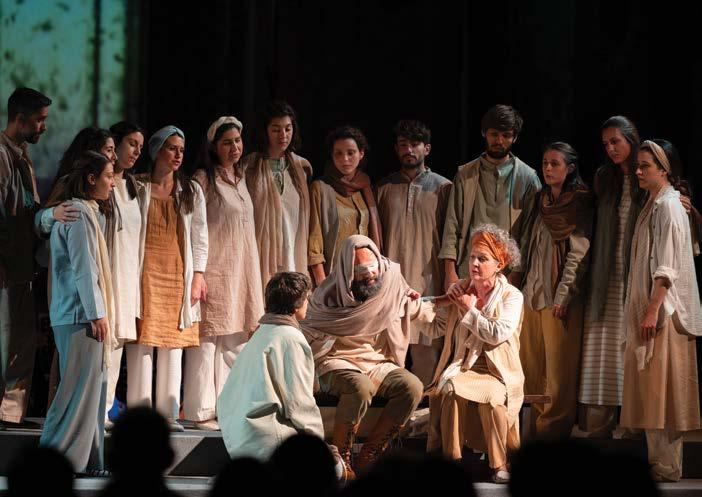

e nella capacità di fare rete fra le istituzioni per il massimo coinvolgimento comunitario, il pilastro su cui da sempre si fondano le Stagioni concertistiche della Camerata Strumentale di Prato e su cui si muovono la programmazione musicale è la qualità indiscutibile degli interpreti, selezionati fra i migliori artisti nazionali e internazionali, con particolare attenzione alle personalità emergenti. Altro elemento distintivo e indispensabile all’azione culturale dell’Orchestra è la varietà dell’offerta di repertorio, che cerca di garantire di stagione in stagione la presenza dei capolavori della letteratura sinfonica, con
attenzione anche al repertorio meno frequentato e alla musica contemporanea.
Una delle novità più significative e gratificanti messe in cantiere dalla Camerata strumentale in questi ultimi anni è stata l’istituzione di un Concorso internazionale di Composizione sinfonica, «Dante 700 – La dolce sinfonia di Paradiso», con cadenza biennale, ispirato al sommo poeta. L’esito dell’iniziativa è stato felicissimo: al bando di concorso, nelle prime due edizioni, hanno risposto con le loro partiture originali compositori da tutto il mondo.
Grazie a questa linea attenta alla diversificazione dell’offerta culturale

e musicale, la progettazione concertistica dell’Orchestra, con le sue numerose ramificazioni cameristiche intese a valorizzare anche i giovani artisti, è il motore della cultura musicale a Prato e il laboratorio di iniziative che hanno come primo obiettivo quello di fare della musica il telaio di un tessuto sociale migliore, più integrato, arricchito di nuove consapevolezze e prospettive culturali. Nata nel 1998 da un’idea di Riccardo Muti e dalla partecipazione di forze pubbliche e private, la Camerata strumentale è sostenuta dal Comune di Prato e dalla Fondazione Cassa di Risparmio di Prato, oltre che dalla Regione Toscana e dal Ministero della Cultura. Alessandro Pinzauti è stato il primo direttore musicale e un contributo artistico decisivo per la crescita dell’Orchestra è venuto da artisti come Piero Bellugi, Franco Rossi e Bruno Bartoletti, che le hanno prodigato cure paterne. Nelle ultime stagioni la Camerata ha avviato un percorso di collaborazione pluriennale con Hugo Ticciati, direttore e violinista animato da una visione artistica ed etica che ha trovato feconda affinità con il patrimonio ideale dell’Orchestra pratese. Nel corso degli anni, la Camerata ha stretto collaborazioni privilegiate con molti artisti di fama e prestigiose compagini corali. L’Orchestra è stata ospite dell’Accademia Musicale Chigiana, degli Amici della Musica di Firenze, Perugia e Palermo, della Sagra Musicale Umbra. Ha compiuto tournée in America Latina, con numerosi concerti in Argentina, Brasile, Cile e Uruguay, in Europa e in Italia con i progetti di circuitazione musicale promossi dal CIDIM. Riccardo Muti ha diretto la Camerata a Prato e al Ravenna Festival. La sua lezione-concerto sulla Sinfonia «Incompiuta» di Schubert è stata pubblicata in dvd. Registrazioni della Camerata sono pubblicate da CPO e da Brilliant e numerosi concerti sono stati trasmessi da RAI5.
Grazie al lavoro di educazione musicale che l’Orchestra ha sempre svolto, decine di migliaia di giovani pratesi hanno avvicinato la musica d’arte potendo contare su un’ottima preparazione e su un’adeguata guida all’ascolto. Stessa attenzione è stata rivolta al pubblico adulto delle Stagioni concertistiche.
By virtue of the work that the Orchestra has always carried out in terms of music education, tens of thousands of young people from Prato have approached art music. In doing so, they could rely on adequate training and a listening guide: the same attention was paid to the adult audience of concert seasons.
Twenty-six years after its foundation, the Instrumental Camerata of Prato is currently a workshop of activities which are designed to enhance the culture of listening and consolidate the spirit of community, as well as being one of the most important chamber orchestras in Italy.
TUna delle novità più interessanti messe in cantiere dalla Camerata in questi ultimi anni è stata l’istituzione del Concorso biennale internazionale di Composizione sinfonica «Dante 700 – La dolce sinfonia di Paradiso», ispirato al sommo poeta.
One of the most significant and gratifying news put in the pipeline by the Instrumental Camerata in the last few years was the institution of an international symphonic composition contest, «Dante 700 – La dolce sinfonia di Paradiso», which draws inspiration from the supreme poet.

he integration with the «G. Verdi» Municipal School of Music of Prato has amplified the vocation that the Instrumental Camerata has been pursuing since its debut, that is turning the Orchestra into a tool for consciously approaching music, available for anyone, from the smallest to the elderly. Such mission is made even more effective by the cohabitation between the Orchestra and the School at the Palace of Music of Prato.
By virtue of the hard work that the Orchestra has always carried out in terms of music education, tens of thousands of young people from Prato have approached art music. In doing so, they could rely on adequate training and a listening guide: the same attention was paid to the adult audience of concert seasons. Projects and laboratories were born from the spirit that has always inspired the Camerata, including the Children’s Orchestra «Prato Sinfonietta» and the Choir «City of Prato», groups that involve thousands of participants in the joy of making music, supported by the professors from the Camerata. Furthermore, the Orchestra is part of the ambitious city project “Prato Comunità Educante”, promoted by the Cassa di Risparmio Foundation of
Such initiatives have found an inspirer and a multiplier of enthusiasm in the music director Jonathan Webb, who has been leading the Orchestra since 2014. In May 2016, the production of Noye’s Fludde by Benjamin Britten was an important symbol of the spirit of active involvement: its staging, shared by several children and adult citizens, marked a moment of restart and rebirth for Prato. Similarly, in March 2019, the performance of Wir bauen eine Stadt by Paul Hindemith and Mahagonny Songspiel by Kurt Weil, in an original diptych, aimed at showing the harmonious strength of music as the model of an ideal society. As a music organism that becomes a tool for inclusion and participation, the Instrumental Camerata wanted to celebrate its first 25 years of life by commissioning a new «Church opera», The Song of the Ladder, to the British composer John Barber: it’s a gift for the whole community of Prato. This new work, which expressly draws inspiration from the Britten’s model of Noye’s Fludde, saw the light in May 2023 at the Church of San Domenico. The staging, coproduced with the Metastasio Theatre, was made possible thanks to the effort of 270 participants to the endeavour: from primary school children to the kids from youth choirs and Prato Sinfonietta, the Choir «City of Prato»
and the youth choir Euphonios, as well as the professors from the Camerata, all led by Jonathan Webb’s passionate belief in the unifying strength of music, which translates to a joyful cooperation. In addition to the winning effort to shape the new audience and the ability to network between institutions to ensure the maximum involvement of the community, the pillar on which the concert seasons of the Instrumental Camerata of Prato has always rested and on which the music programme has always rested is the undoubtable quality of the interpreters, chosen among the best national and international artists with a special focus on emerging personalities. Another distinctive and necessary element for the cultural action of the Orchestra is the wide repertoire offering, which from season to season tries to ensure the presence of the masterpieces of symphonic literature, also with a focus on the less popular repertoire and contemporary music.
One of the most significant and gratifying news put in the pipeline by the Instrumental Camerata in the last few years was the institution of an international symphonic composition contest, «Dante 700 – La dolce sinfonia di Paradiso», which takes place every two years and draws inspiration from the supreme poet. The initiative was

very successful: in the first two editions, composers from all over the world took part with their scores in the call for proposals.
Thanks to this approach, which pays attention to the diversification of the cultural and musical offering, the concert programmes of the Orchestra, with its several chamber music branches that are aimed at enhancing also young artists, is the engine of music culture in Prato and a laboratory of initiatives whose first goal is turning music into the framework of a better and more integrated social fabric, enriched by new awareness and cultural perspectives.
Born in 1998 from an idea by Riccardo Muti and the participation of public and private strengths, the Instrumental Camerata is supported by the Municipality of Prato and the Cassa di Risparmio Foundation of Prato, as well as the Tuscany Region and the Ministry of Culture. Alessandro Pinzauti was the first musical director and a decisive artistic contribution to the growth of the Orchestra came from artists such as Piero Bellugi, Franco Rossi and Bruno Bartoletti, who did their best for it with paternal care. In the last few seasons, the Camerata started a multi-year partnership journey with Hugo Ticciati, a director and violinist who’s driven by an artistic and ethical vision that has found a deep affinity with the ideal heritage of the Orchestra of Prato. Throughout the years, the Camerata established privileged collaborations with several well-known artists and prestigious choirs. The Orchestra was the guest of the Chigiana Music Academy, of the Friends of Music concert groups in Florence, Perugia and Palermo and of the Umbria Music Festival. The Orchestra toured in Latin America, with several concerts in Argentina, Brazil, Chile and Uruguay, Europe and Italy and the music circulation projects promoted by the CIDIM. Riccardo Muti led the Camerata in Prato and at the Ravenna Festival. His lesson-concert on Schubert’s «Unfinished» Symphony was released on DVD. The recordings of the Camerata were published by CPO and Brilliant and several concerts were broadcasted by RAI5.


Da qualche numero a questa parte NATURART è uscita oltre i confini politici del territorio pistoiese, guardando con grande attenzione ad un’area vasta composta dai territori di Pistoia, Prato e Lucca, identificabile come “Green Tuscany”. Il primo passo è stato cambiare il sottotitolo della rivista in “Nature, art and culture in the Green Tuscany” dedicando alcuni articoli a eventi e importanti eccellenze di questi territori.
Questo articolo, dedicato alla Camerata strumentale di Prato, che oggi oltre ad essere una delle principali Orchestre da camera italiane è un’officina di attività dedicate alla diffusione di una cultura dell’ascolto e al consolidamento dello spirito di comunità, rappresenta un altro significativo passo su un percorso comune che ci vede accanto a Fondazione Cassa di Risparmio di Prato, che porterà ad una collaborazione più ampia su temi importanti come verde, sostenibilità, cultura e impegno sociale con enti ed istituzioni, seguendo visioni e obiettivi comuni.
In its last few issues, NATURART has gone beyond the political borders of the Pistoiese territory and is paying significant attention to a wide area made up of the territories of Pistoia, Prato and Lucca, which we can identify as “Green Tuscany”. The first step was changing the subheading of the magazine into “Nature, art and culture in the Green Tuscany” and dedicating a few articles to events and important excellences of these territories.
This article is dedicated to the Instrumental Camerata of Prato which today, as well as being one of the main chamber orchestras in Itay, is a workshop of activities dedicated to spreading a culture of listening and consolidating the spirit of community. It represents another significant step in a common journey that sees us next to the Cassa di Risparmio Foundation of Prato and will lead us to a wider partnership on important topics, such as green, sustainability, culture and social commitment, with bodies and institutions, by following shared visions and goals.
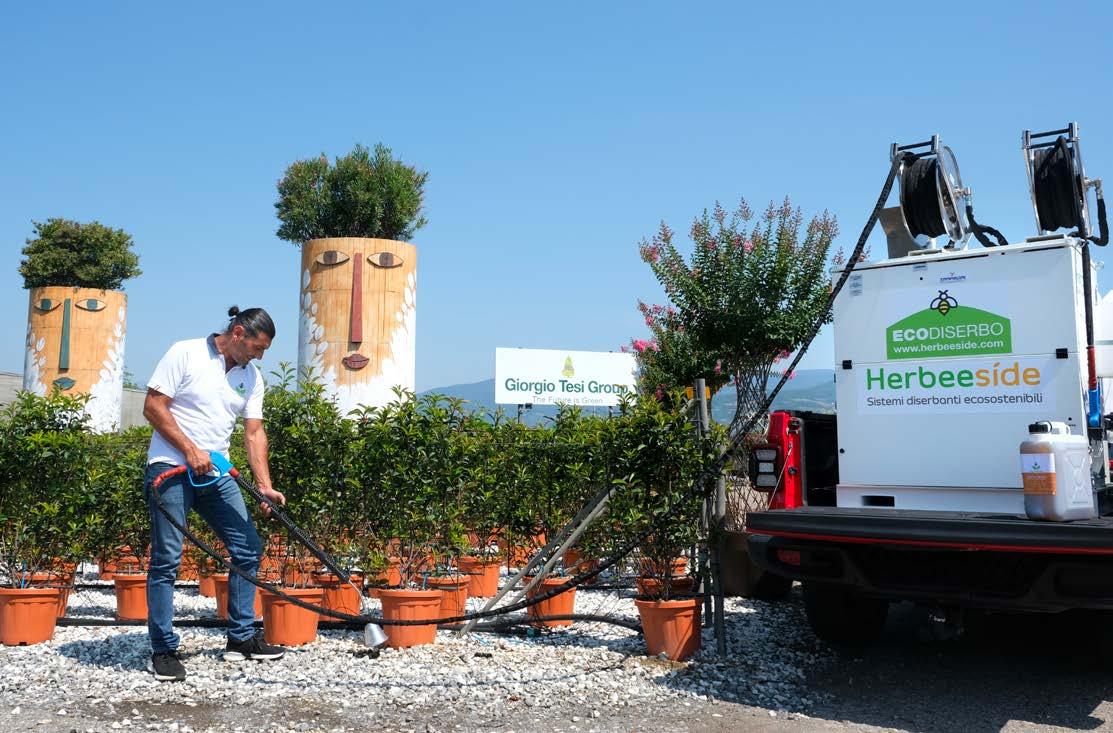
Herbeeside è un sistema di diserbo ecologico che si compone di un macchinario, con accessori che variano in base al contesto da trattare e di un additivo brevettato di origine naturale che viene erogato a temperature fino a 140°. Il sistema Herbeeside provoca uno shock termico alle piante infestanti che ne determina l’essiccazione in meno di 24 ore.
L’additivo brevettato Herbeeside è stato ideato e realizzato in un territorio a vocazione agricola del Sud Sardegna, è 100% naturale perchè prodotto dalle eccedenze di altre lavorazioni della filiera alimentare.
Tra gli ingredienti principali, la pompìa, un frutto del territorio Sardo, oggetto di numerosi studi dell’Università di Sassari. Quella che viene utilizzata per produrre l’additivo Herbeeside proviene dal territorio di Siniscola, nel nord-est della Sardegna, da campi di proprietà comunale coltivati tramite un progetto finalizzato al reinserimento lavorativo di soggetti con disabilità, normalmente esclusi dal mercato del
lavoro. Questi frutti vengono prima adoperati per lavorazioni alimentari e cosmetiche che ne utilizzano solo la buccia, per poi diventare l’ingrediente principale di Herbeeside. Il modello di utilità che eroga l’additivo nei macchinari è stato progettato e brevettato dai tecnici dell’azienda ed è l’unico a garantire l’erogazione di additivo nei tempi e nelle dosi corrette per poter neutralizzare le erbe infestanti in modo mirato ed efficace. È rapido ed efficace, agisce in 24 ore con risultati eccellenti usando sostenibilmente l’acqua e inquinando 1000 volte meno di un dispositivo di tipo tradizionale. Agendo tramite shock termico, apporta la sua azione sia sulle foglie che sulla radice della pianta infestante, eliminandola o ritardandone la ricrescita. Non necessita della chiusura al pubblico dell’area da trattare, perché è totalmente sicuro per gli esseri umani e per l’ambiente in quanto non lascia residui tossici sul suolo. Non è pericoloso per gli operatori o gli utenti, che durante
l’impiego non hanno nessun obbligo di indossare particolari protezioni. Per utlizzare Herbeeside non servono patentini, l’additivo è totalmente naturale e quindi non richiede abilitazione all’acquisto, all’utilizzo, alla manipolazione e allo smaltimento come nel caso dei prodotti fitosanitari tradizionali.
Il sistema ritarda la rigerminazione delle infestanti grazie a una temporanea, lieve variazione dell’acidità del terreno e alla pacciamatura creata dalle infestanti “cotte”, nutre l’area trattata tramite il rilascio delle sostanze nutritive delle piante “cotte” e favorisce gli insetti impollinatori nutrendoli con le sostanze zuccherine di cui è composto l’additivo.
Il 10% degli utili viene reinvestito in progetti di tutela ambientale come la piantumazione di nuovi alberi. Herbeeside è dotato di etichetta di qualità ecologica di tipo II in conformità alla UNI ISO 14021:2016, requisito tra quelli riconosciuti per i Criteri Ambientali Minimi (CAM).


In apertura Giorgio Tesi Group, azienda leader a livello internazionale, e Herbeeside, realtà innovativa nell’ambito dei diserbanti bio e sostenibili, sperimentano un additivo di origine 100% naturale. Due Green Heroes insieme per un futuro più verde del settore.
In the opening page Giorgio Tesi Group, an international leading company, and Herbeeside, an innovative reality in the field of organic and sustainable weed killers, experiment a 100% natural additive. Two Green Heroes together for a greener future in the industry.
An innovative and natural system for the management of undesired green
Herbeeside is an ecological weeding system that is made up of a machine, with accessories that vary based on the context to be treated, and a patented additive of natural origin, that is dispensed at temperatures up to 140°. The Herbeeside system causes a thermal shock to weeds, which leads to their drying in less than 24 hours.
The patented additive Herbeeside was designed and manufactured in an agricultural land of South Sardinia, is 100% natural because it’s produced by the surplus of other food chain processes. Among the main ingredients is pompia, a citrus fruit from Sardinia, which is the object of several studies by the University of Sassari. That used to produce the additive Herbeeside comes from the territory of Siniscola, in the north-east of Sardinia, from municipal fields cultivated through a project aimed at the professional reintegration of
people with disabilities, who are usually excluded from the job market. These fruits are initially used for food and cosmetic processing that only use their skin, and then they become the main ingredient of Herbeeside. The utility model that dispenses the additive in the machines was designed and patented by the technicians of the company and is the only one that ensures the supply of additive in the correct times and doses to neutralize weeds in a targeted and effective way. It’s fast and effective, and provides excellent results in 24 hours by using water in a sustainable way and polluting 1000 times less than a traditional device. It acts through thermal shock both on the leaves and the root of the weed and kills it or delays its growth. The area to be treated doesn’t need to be closed to the public; in fact, the product is totally safe for human beings and the

environment since it doesn’t leave any toxic waste on the soil. It’s not dangerous for operators or users, who don’t need to wear any specific protection during use. You don’t need any license to use Herbeeside, because the additive is 100% natural and, therefore, no certificate of competency is needed for the purchase, use, handling and disposal as it happens with traditional plant protection products.
The system delays the regermination of weeds thanks to a temporary and mild variation of the acidity of the soil and the mulching created by the “cooked” weeds, feeds the treated area through the release of the nutrients of the “cooked” plants and favours pollinating insects by feeding them with the sugars that make up the additive.
The 10% of profits is reinvested in environmental protection projects such as the planting of new trees. Herbeeside comes with a type II ecological quality label, in compliance with UNI ISO 14021:2016. Such requirement is recognized as one of the minimum environmental criteria (MEC).
è un marchio di proprietà di Agrimachine Green Evolution S.r.l. Via Alghero 51 – 09127 Cagliari www.herbeeside.com info@herbeeside.com Telefono: +39 391 7091500


Valerio Ceccarelli

Copiare significa studiare l’arte dei maestri, conoscerne in profondità la tecnica pittorica e rendere loro omaggio.

Quella di Valerio Ceccarelli, nato a Poppi nel 1954 ma trasferitosi a Pistoia prima di compiere un anno di vita, è una storia che merita di essere raccontata e conosciuta. È la storia di una dedizione: all’arte e ad alcuni grandi maestri della pittura.
In apertura Porto di mare di Jan Brueghel. Sopra Valerio Ceccarelli al lavoro su Piccolo giudizio finale di Rubens. Accanto, Corteo nuziale Jan Brueghel e a destra, Il grande calvario, ancora di Jan Brueghel.
In the opening page, Seaport by Jan Brueghel. Above, Valerio Ceccarelli working on The Small Last Judgement by Rubens. Next to it, The Wedding procession by Jan Brueghel and, on the right, The Large Calvary, again by Jan Brueghel.
C’è una data e un luogo dal quale la vicenda ha avuto inizio: Valerio, che già alle scuole elementari e alle scuole medie aveva mostrato una grande passione per il disegno e la pittura, è al secondo giorno delle superiori, alla Scuola d’Arte, oggi Liceo artistico. Manca la professoressa di matematica e viene a sostituirla in classe Pietro Bugiani, che mostra agli alunni un piccolo libro: è un libro dedicato a Rembrandt. In Valerio scatta immediatamente la passione per questo artista: una passione che lo porta subito dopo a frequentare gli Uffizi per andare a vedere le tele del maestro olandese e ad osservare con attenzione e curiosità un copista che ne riproduce le opere. Anche Valerio decide di provare a riprodurre in copia le opere d’arte che più ama, iniziando proprio da due autoritratti di Rembrandt. Questa attività, una volta finita la Scuola d’Arte, dove ha incontrato Bugiani ma anche Jorio Vivarelli, con il quale resterà legato per tutta la vita, diventa un mestiere, il proprio mestiere. Dal 1977 fino a tre anni fa, ha riprodotto e venduto oltre 4.000 opere: “Direi di aver fatto tra le 4.300 e le 4.500 copie – racconta. Le facevo su committenza, ma spesso chi le ordinava non mi
lasciava il tempo per riprodurre gli originali con la dovuta calma e precisione. Dal 1985 ho così deciso di dividere in due la mia attività: mentre continuavo a fare copie su committenza, per guadagnarmi da vivere e mantenere la mia famiglia, ho iniziato anche a fare delle copie solo per me”. Queste copie fatte per sé sono oggi 70. Sono copie di quadri di grandi maestri italiani (da Leonardo, la cui “Annunciazione” campeggia nel salotto di casa: ed era un’opera che andava spesso a vedere Alfio Del Serra, che si era occupato del restauro dell’originale, a Raffaello, Pontormo e Tiziano) ma sono soprattutto riproduzioni dei maestri fiamminghi. “I fiamminghi sono la mia passione –spiega mente ci mostra le tele nel suo studio e nella sua abitazione –; ho incontrato la loro pittura alla mostra che gli venne dedicata a Firenze nel 1976 e da allora sono rimasto conquistato dai colori straordinari e dalla ricchezza dei dettagli delle loro tele. Direi che anche quando riproduco gli italiani, scelgo opere che hanno aspetti ricollegabili al gusto fiammingo”.
Copiare, per Valerio Ceccarelli, significa studiare l’arte dei maestri, conoscerne in profondità la tecnica pittorica e rendere loro


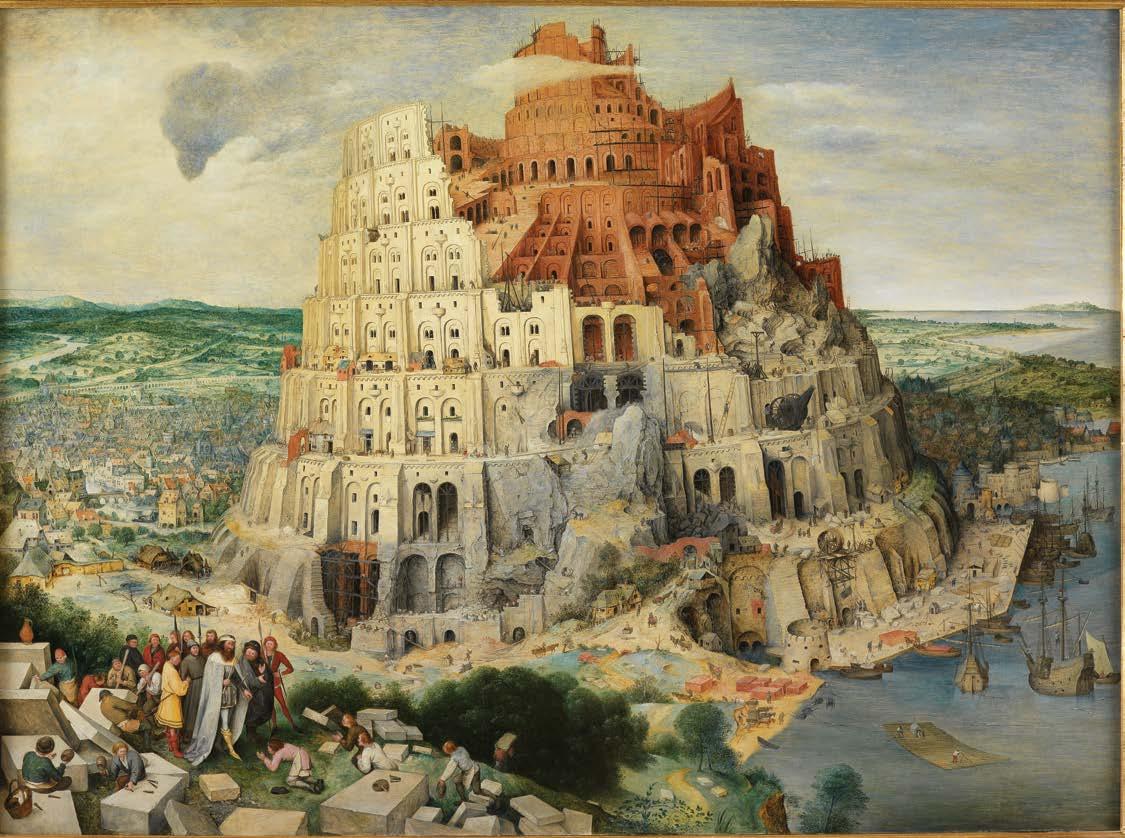
In alto Torre di Babele di Peter Brueghel il vecchio. Nell’altra pagina Valerio Ceccarelli accanto ad Alfiere di Rembrandt, Deposizione nel sepolcro di Rogier van der Weyden e un particolare dell’opera Deposizione di Raffaello.
Above Tower of Babel by Pieter Bruegel the Elder. In the next page Valerio Ceccarelli next to The Standard Bearer by Rembrandt, Deposition by Rogier van der Weyden and a detail of the work Deposition by Raphael.
omaggio. Ogni giornata prende senso se è dedicata almeno in parte ad un “a tu per tu” con un maestro. E le 70 opere realizzate, su tela e – soprattutto – su tavola, hanno richiesto circa 50.000 ore di lavoro e non sono in vendita: restano tra le cose più care che Ceccarelli ha e, per poterle vedere una accanto all’altra, Valerio ha anche acquistato un fondo dove esporle. Ogni copia ha richiesto un lavoro accurato: andarla a vedere (la storia di Valerio è anche una storia di viaggi nei musei d’Europa), fotografarla con centinaia di scatti in modo da poter osservare i minimi tratti e le pennellate (su uno scaffale dello studio ci sono accumulate – in ordine – le scatole con le fotografie fatte) e poi, nella tranquillità dello studio, iniziare a riprodurla. E dietro ogni tela riprodotta c’è una storia. Il “Compianto sul Cristo morto” di Rogier van der Weyden, per esempio, era custodito in un deposito degli Uffizi in prossimità di via dei Georgofili: “L’ho fotografato
una settimana prima dell’attentato del 1993 – racconta – e poi l’ho ricollocato non di fronte alla finestra, dove si trovava, ma su una parete laterale; mi vengono i brividi a pensarci, ma se l’avessi rimesso dove era, oggi non avremmo più questa grande opera, che sarebbe stata distrutta dallo scoppio della bomba che ha mandato in frantumi anche la finestra di quella stanza; invece è stata solo lievemente danneggiata e possiamo ancora ammirarla”. Anche oggi Valerio Ceccarelli, al quale sono state dedicate a Pistoia due mostre, nel 2001 e nel 2015, continua a riservare una parte importante del suo tempo agli artisti che ama. Nella sua abitazione, dove ci guida insieme alla moglie Giovanna, ci mostra anche “La torre di Babele” di Pieter Bruegel il Vecchio e non può non impressionare l’esattezza della riproduzione di questa che considera un po’ il simbolo e la sintesi del suo lavoro. Pochi giorni fa è andato all’Ambrosiana,
a Milano, per un’altra opera di Bruegel, “Vaso di fiori con monili”: “È un’opera straordinaria – ci dice con gli occhi che gli brillano e la voce che si incrina –, sono rimasto a contemplarla per due ore e mi sono emozionato: l’ho sempre ammirata ma non mi sentivo in grado di riprodurla; ora, invece, ho deciso di provarci”.
Nello studio, invece, i due cavalletti sono occupati dal “Piccolo giudizio finale” di Rubens e dall’“Alfiere” di Rembrandt, il cui originale è stato acquistato tre anni fa dall’Olanda per 150 milioni di euro.
E appoggiato alla parete c’è già un telaio pronto per un’altra grande opera di Rembrandt che vuole cimentarsi a copiare, “Lezione d’anatomia del dottor Nicolaes Tulp”. Resta fedele, Valerio, ai suoi artisti e al pittore che ha incontrato per la prima volta sui banchi della Scuola d’Arte; e resta fedele, lui che si definisce un artigiano della pittura, alla sua vocazione: rendere omaggio agli artisti amati riproducendone le tele.


Copying means to study the art of the masters, knowing their painting technique in depth and paying tribute to them.
The history of Valerio Ceccarelli, who was born in Poppi in 1954 but relocated to Pistoia before turning one year old, deserves to be narrated and known. It’s a history of devotion: to art and to some great masters of painting. There’s a date and place from which the story began: Valerio, who had already shown a great passion for drawing and painting at primary school and secondary school, was at his second day of high school, at the Art School (known
today as Arts High School). The maths teacher was absent and Pietro Bugiani was called to replace her. He showed a small book to his students: it’s dedicated to Rembrandt. Valerio immediately took the passion for this artist, a passion that would soon lead him to frequent the Uffizi Gallery to see the canvas by
the Dutch master and observe with attention and curiosity a copyist who reproduced Rembrandt’s work. Valerio also decided to try and copy the works of art that he loved the most, actually starting from two self-portraits of Rembrandt. This activity became Valerio’s profession once he finished the

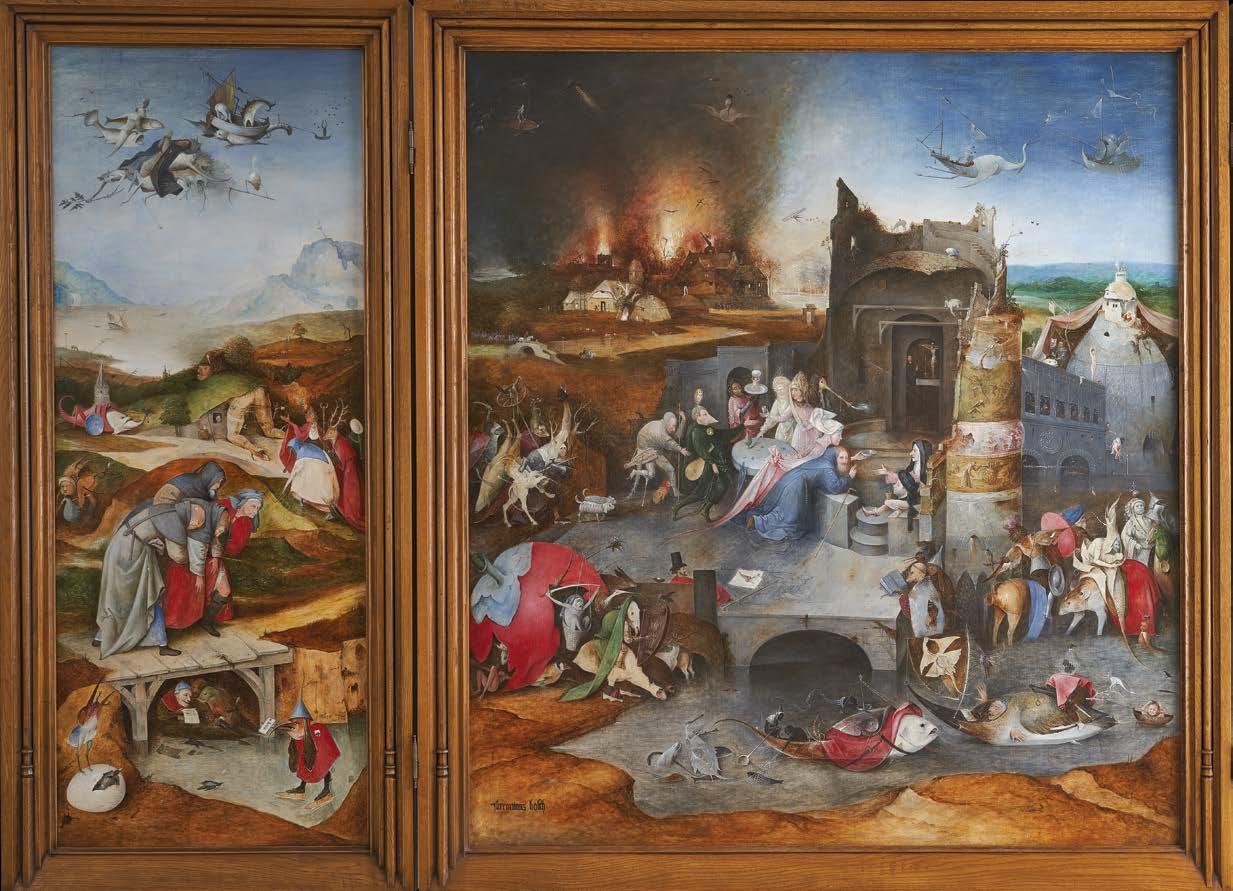
Art School, where he met Bugiani but also Jorio Vivarelli, with whom he had a lifelong bond. From 1977 until three years ago, Valerio reproduced and sold over 4,000 works: “I would say I made about 4,300-4,500 copies – explains Valerio. – I made them on commission, but those who commissioned them would often not leave me enough time to reproduce the originals with the due calm and precision. Since 1985, I decided to divide my activity in two: while I continued to make copies on commission, to make a living and maintain my family, I also started to make them just for myself”.
The copies that Valerio made for himself are currently 700.
These are copies of paintings by great Italian masters (from Leonardo, whose “Annunciation” stands out in the living room of Valerio’s house (Alfio De Serra, who had taken care of restoring the original, would often go and see
this work) to Raphael, Pontormo and Titian), but they are mostly reproductions of the Flemish masters. “The Flemish are my passion – explains Valerio, as he shows us the canvas in his studio and house -; I discovered their panting at the exhibition that was dedicated to them in Florence, in 1976, and I was conquered by the extraordinary colours and richness of details of their canvas. I would say that, also when I reproduce Italian painters, I choose works with elements that can be ascribed to the Flemish taste”.
For Valerio Ceccarelli, copying means studying the art of masters, knowing their painting technique in depth and paying homage to them. Every day makes sense if it’s dedicated, at least in part, to a “face to face” interaction with a master. And it took nearly 50,000 hours of work to complete the 70 works on canvas and – above all – on board, which are not for sale: they still are
among the copyist’s most cherished possessions and he even bought a property so that he can exhibit them and see them one beside the other. It took some accurate work to complete each copy: Valerio had to go and see it (his story is also a story of his journey through the museums of Europe), take photographs with hundreds of clicks so that he could observe the minimum traits and brush strokes (the boxes with the photographs he took have been accumulating – in order – on a shelf of the studio) and, in the tranquillity of his studio, start to reproduce it. Behind every reproduced canvas there’s a story. For example, the “Lamentation over the Dead Christ” by Rogier van der Weyden, was preserved in a deposit of the Uffizi in the proximity of Via dei Georgofili: “I took a photograph of it a week before the attack in 1993 – explains Valerio – and then I didn’t place it back in front the window,

where it was originally located, but rather on a side wall: I get chills if I think about it, but if I had placed it back where it was, we would no longer have this great work, that would have been destroyed by the blast of the bomb that shattered also the window of that room; instead, it was just mildly damaged and we can still admire it”. Even today Valerio Ceccarelli, to whom two exhibitions were dedicated in Pistoia, in 2001 and 2015, continues to allocate an important part of his time to the artists he loves.
In house, where he guides us along with his wife Giovanna, he shows us also the “The tower of Babel” by Pieter Bruegel the Elder and we cannot but remained impressed by the accuracy of this reproduction, that Valerio regards as the symbol and synthesis of his work. A few days ago, Valerio went to the Ambrosian Art Gallery, in Milano, to see another work by Bruegel, “Vase of flowers with
Accanto, la riproduzione realizzata da Valerio Ceccarelli dell’opera Tentazioni di San Antonio di Bosch. L’artista pistoiese tra il 1977 e tra anni fa ha realizzato e venduto oltre 4000 opere.
Next, the reproduction of Bosch’s work The Temptation of St. Anthony, by Valerio Ceccarelli. Between 1977 and three years ago, the Pistoiese artist completed and sold over 4.000 works.





jewel”: “It’s an amazing work – he says as his eyes shine and his voice cracks –, I spent two hours observing it and I was moved. I’ve always admired it, but I didn’t feel capable of reproducing it: now, I decided to give it a try”. Instead, in his studio, the two tripods are occupied by the “Small last judgement” by Rubens and the “Standard Bearer” by Rembrandt, whose original was purchased three years ago by the Netherlands for 150 million euros. And, leaning against the wall, there’s also a frame which is ready for another great work by Rembrandt that Rembrandt wants to try and copy: “ The Anatomy Lesson of Dr. Nicolaes Tulp”. Valerio remains loyal to his artists and the painter that he encountered for the first time at Art School and, since he defines himself as an artisan of painting, he also remains loyal to his vocation: paying homage to the artists he loves by reproducing their canvas.



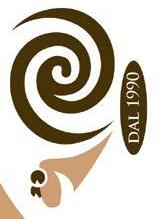
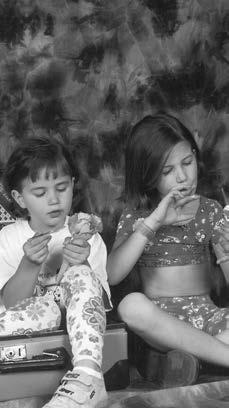






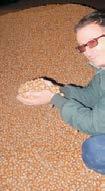

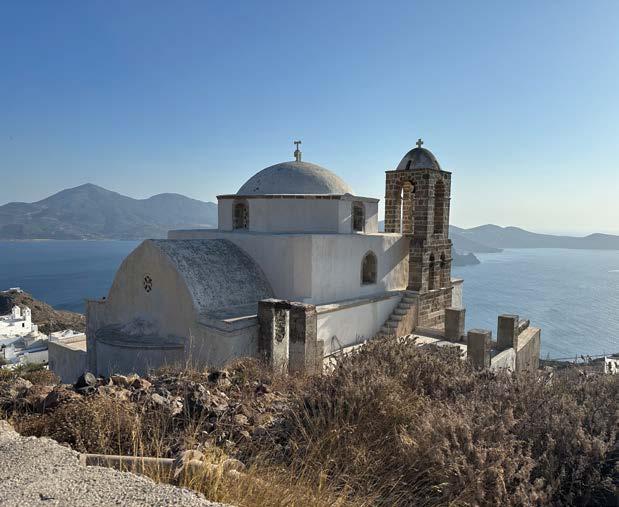

Da sinistra: la copertina del libro, la chiesa di Kastro sull’isola di Milo, veduta di Astipalea dal castello veneziano, la barca a vela Milanto in navigazione, un ritratto dell’autore.
From left: the book cover, the church of Kastro on the island of Milos; a sight of Astypalaea from the Venetian castle; the sailing boat Milanto underway; a portrait of the author.
Il Mediterraneo del mondo antico è stato il luogo dove a un certo punto della Storia è avvenuto uno dei più grandi big bang dell’umanità. Possiamo individuare tracce che ci aiutino a capire com’è nata la nostra cultura? Scopriamo insieme il nuovo libro di Lorenzo Cipriani
Lorenzo Cipriani è un esploratore a 360 gradi del nostro tempo, perché è sempre alla ricerca delle origini della nostra civiltà con la sapienza di chi non separa mai Scienza e Umanesimo ma li intreccia per ascoltare le voci antiche dentro la babele del presente e comporle in quadri viventi che suscitano quelle domande a cui solo il futuro potrà dare una risposta. In questo libro appassionato e multiforme racconta il suo viaggio in barca a vela lungo le rotte mediterranee dei popoli che hanno fondato l’Occidente, approdando nei porti delle terre e delle isole che furono protagoniste del mondo antico. L’itinerario si sviluppa
dall’Italia alla Grecia fino a Istanbul, le isole dell’Egeo e la costa turca, per tornare poi verso casa passando da Creta, Malta, Sicilia, Sardegna e le isole Baleari. Greci, Etruschi, Fenici, Romani, Genovesi, Veneziani, Pisani, Amalfitani, Turchi, Bizantini, Ottomani e Sardi sono fra i popoli che hanno navigato il Mare Nostrum: Cipriani intrattiene un faccia a faccia con le loro interessanti storie, mette a fuoco personaggi talvolta bizzarri, racconta leggende anche un poco strane ed evoca miti non sempre edificanti. Arte e narrazione, ma anche poesia e musica, si intrecciano in questo libro per proporre non solo una
guida coinvolgente per futuri viaggi ma soprattutto un’immersione totale dentro la Natura, che sempre nutre e insegna. Di volta in volta l’autore è stato anche accompagnato da quattro triglie, comprate in ogni porto per una ricerca scientifica ad alto livello sulla presenza di microplastiche nelle loro viscere e poi saltate in padella per il palato degli ospiti italiani e stranieri che si sono avvicendati su Milanto. Per questo siamo di fronte a un vademecum disincantato ma energizzante rivolto a un’anima che voglia ritrovare sé stessa dietro le mistificazioni della nostra società contemporanea.


The Mediterranean Sea of the ancient world was the place where, at some point in History, one of the greatest Big Bangs in humanity took place. Can we detect traces that may help us to understand how our culture was born? Let’s discover together the new book by Lorenzo Cipriani
Lorenzo Cipriani is an all-round explorer of our time, because he’s constantly searching for the origins of our civilization with the wisdom of those who never separate Science and Humanism, but rather intertwine them to listen to ancient voices within the current Babel and assemble them in living pictures, eliciting those questions that only future will be able to answer. In this passionate and multifaceted book, Cipriani narrates his sailing journey along the Mediterranean routes of the peoples who founded Western civilization, docking in the ports of lands and islands that were central to the ancient world. The itinerary spans from Italy to Greece, reaching Istanbul, the Aegean islands, and the Turkish coast, then returning home via Crete, Malta, Sicily, Sardinia, and the Balearic Islands. The Greeks, Etruscans, Phoenicians, Romans, Genoese, Venetians, Pisans, Amalfitans, Turks, Byzantines, Ottomans, and Sardinians are among the peoples who navigated the Mare Nostrum.
Cipriani engages in a dialogue with their fascinating histories, focuses on sometimes eccentric characters, recounts slightly strange legends, and evokes myths that are not always edifying. Art and storytelling, along with poetry and music, intertwine in this book, offering not just an engaging guide for future travels but above all an immersive experience in Nature, which always nurtures and teaches. Throughout his journey, Cipriani was accompanied by four mullets, purchased in each port for high-level scientific research on the presence of microplastics in their guts, which were then cooked for the palate of the Italian and foreign guests aboard Milanto. This book is thus a disenchanted yet energizing handbook aimed at a soul seeking to rediscover itself amid the mystifications of contemporary society.

Lorenzo Cipriani (1971) è storico dell’arte, musicista, scrittore e storyteller. Come skipper naviga per i mari del mondo, collaborando con il dipartimento di Biologia dell’Università di Firenze per ricerche scientifiche sulle microplastiche. È progettista e responsabile culturale di varie istituzioni pubbliche e private. Ha realizzato Gli Spaesati, un ciclo di podcast su opere d’arte disperse nei grandi musei del mondo. Fra i suoi ultimi libri: Pistoia. Arte-Storia-Cultura (Gli Ori 2019) e Il respiro dell’oceano. Giro del mondo in barca a vela ai tempi del covid (I libri di Mompracem 2022). Fotografo, è in uscita Art Odyssey (Metilene) su questo stesso viaggio nel Mediterraneo.
Lorenzo Cipriani (1971) is an art historian, musician, writer, and storyteller. As a skipper, he sails the world’s seas, collaborating with the Department of Biology at the University of Florence on scientific research about microplastics. He is a designer and cultural manager for various public and private institutions. He created Gli Spaesati, a podcast series about artworks dispersed in major museums around the world. Among his recent books are Pistoia. Arte-Storia-Cultura (Gli Ori 2019) and Il respiro dell’oceano. Giro del mondo in barca a vela ai tempi del covid (I libri di Mompracem 2022). He is also a photographer and Art Odyssey (Metilene), about his Mediterranean journey, will be published soon.

— Qual è il rapporto tra il territorio e i suoi abitanti, tra natura, cultura e il futuro del pianeta? Quali le narrazioni che possono aiutarci a comprendere le trasformazioni del paesaggio e l’impatto che hanno sulle nostre vite?
Visioni sul territorio è un progetto che nasce dalla sinergia tra Studio Marangoni, scuola di fotografia di Firenze e Giorgio Tesi Group e si inserisce coerentemente in un lavoro di ricerca che vede lo studio del rapporto uomo/natura tra i temi centrali di indagine, con l’obiettivo di creare un ricerca che sia testimonianza del paesaggio e dei territori nonché delle dinamiche sociali e culturali che li abitano. Il progetto è stato guidato da Chiara Ruberti, docente e curatrice, e ha visto il
Da oltre 30 anni la Fondazione Studio Marangoni, con sede a Firenze, è tra i leader in Italia e in Europa nella formazione e divulgazione della cultura fotografica. Sin dai suoi esordi ha sempre sviluppato, in parallelo a una offerta formativa che coniuga insieme la fotografia artistica con quella commerciale, attività collaterali in campo di produzione e divulgazione culturale, creando un dialogo aperto con il territorio e coinvolgendo sia importanti nomi internazionali che partner locali.
Chiara Ruberti si laurea in Storia dell’Arte nel 2007. Dal 2008 al 2014 lavora per la Fondazione Alinari (Firenze), prima
coinvolgimento di 12 giovan* fotografi e fotografe italian* selezionat* da una open call. L’obiettivo era attivare un percorso creativo di confronto e ricerca con il quale valorizzare l’importanza di uno sguardo collettivo, capace di rappresentare una testimonianza di appartenenza e di identità. Archivio/documento, naturale/ artificiale, memoria/futuro, controllo/possibilità, visione/ indagine. Questi alcuni degli elementi ricorrenti nelle diverse ricerche che, con approcci autoriali spesso multidisciplinari, invitano innanzitutto l’osservatore
come assistente della direttrice scientifica per i progetti espositivi poi come coordinatrice dei progetti editoriali. Nel 2014 frequenta il Corso per curatori dell’immagine contemporanea presso Fondazione Fotografia (Modena) e inizia la collaborazione con il Photolux Festival di Lucca, di cui è stata coordinatrice, co-direttrice e con cui collabora oggi come curatrice. Dal 2019 collabora con la Fondazione Studio Marangoni in qualità di tutor e dal 2022 è docente e coordinatrice del Dipartimento di Fotografia di Accademia Italiana (Firenze). Come curatrice indipendente collabora con fotografi, istituzioni e spazi dedicati alla fotografia e all’arte contemporanea in Italia e all’estero.
a riconsiderare ciò che vede nelle immagini, così come nel paesaggio quotidiano che lo circonda. La fotografia si fa allora strumento indispensabile per svelare gli inaspettati cortocircuiti del reale e dell’immaginario. Il risultato è una geografia inedita che, a partire dalla sensibilità e dalla visione di ogni autore ed autrice, interseca livelli di lettura e di interpretazione diversi. Le questioni legate alla sostenibilità e alle conseguenze delle trasformazioni agite dall’uomo sul paesaggio sono al centro del lavoro di Elsa Pizzuto, Leonardo Bocci e Marco Lumini; Barbara Leolini, Claudia Mann e Matteo Orani hanno indagato la memoria dei luoghi, dove si intrecciano le tracce del passato con le possibili storie del presente; una cartografia personale e visionaria è, invece, quella che hanno costruito Gabriele Fossi, Marco Farmalli e Francesca Renzi. Paesaggi come testi, dunquecitando Serenella Iovino - perché “attraverso di essi possiamo leggere le storie di relazioni sociali e rapporti di potere, equilibri e squilibri biologici, il concreto prendere forma di spazi, territori, vita umana e non umana”. I nove lavori selezionati saranno presentati a due festival importanti: Un altro Parco in città a Pistoia e Photolux a Lucca.
“Lassù dov e speca e balen”, reso in italiano dal dialetto romagnolo parlato nell’Appennino Tosco-Romagnolo, significa semplicemente “Lassù dove hanno origine i fulmini” ed è una espressione, appunto dialettale, per dire che la persona o la cosa a cui ci si
riferisce è collocata lontano, in un luogo difficile e pericoloso”.
Nel cuore del Parco Nazionale delle Foreste Casentinesi, l’intreccio tra l’uomo e la foresta si manifesta come un legame profondo e millenario. Ogni rudere, mulattiera e chiesetta campestre racconta storie di vita e sacrificio, tessendo un mosaico di solidarietà e profonda connessione con la natura.
E’ la malinconia il sentimento che provo quando passo in questi posti, perchè riesco a vedere le famiglie che per secoli vi hanno abitato, faticato per ricavarne


Up there, where flashes originate
da vivere, generazioni di donne e uomini dimenticati la cui storia inevitabilmente è terminata senza rumore, se non quello delle pietre che ogni tanto precipitano da questi vecchi muri.
Questi resti silenziosi custodiscono memorie di un tempo in cui l’uomo trovava rifugio tra gli alberi, cavalcando il flusso misterioso di energia che permea il bosco. Un legame profondo, seppur invisibile agli occhi non allenati, un richiamo alla bellezza di un equilibrio perduto e un invito a preservare e celebrare la saggezza della natura.


In Italian, the expression “Lassù dov e speca e balen” (in the Romagnol dialect spoken in the Tuscan-Romagnol Apennine) simply means “Up there, where flashes originate” and is a dialectal expression to say that the person or thing it refers to is located away, in a difficult and dangerous place”. In the heart of the Foreste Casentinesi
National Park, the interweaving between human beings and forest manifests itself as a deep and thousand-year-old bond. Every ruin, mule track and rural church tells stories of life and sacrifice and weaves a mosaic of solidarity and deep connection with nature.
Whenever I walk through these places, I have a feeling of melancholy, because I manage to see the families that have inhabited there for centuries and have struggled to earn a living: these are generations of forgotten women and

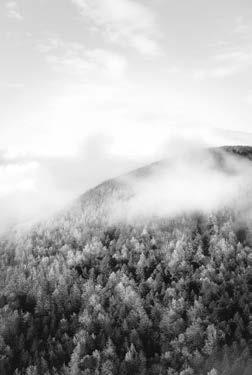
men, whose history has unavoidably ended without noise, if not that of the stones that, sometimes, fall down from these old walls. These silent remains keep memories of a time where men would find a shelter between trees, riding the mysterious flow of energy that permeates the forest.
A deep bond which, however, can’t be seen by non-trained eyes, an appeal to the beauty of a lost balance and an invitation to preserve and celebrate the wisdom of nature.
Selvatico ferroviario è un’indagine visiva sull’area dell’ex scalo ferroviario di Porta Romana, a Milano. Si tratta di una superficie di circa 20 ettari che è rimasta semi dismessa per anni, nel corso dei quali è avvenuto uno spontaneo


processo di rinaturalizzazione. Lungo le rete ferroviarie infatti l’essere umano ha inconsapevolmente creato un ambiente favorevole alla proliferazione di numerose specie: il trasporto di merci e semi, la creazione di suoli privi di humus ma spesso ricchi di sostanze nutritive, hanno infatti fatto sì che queste aree divenissero delle reti ecologiche estremamente variegate, senza la necessità di cure o risorse esterne .
Ad oggi sede dei lavori in vista dei Giochi invernali del 2026, lo scalo appare come un parco incolto e inaccessibile, in contrasto con le rappresentazioni dei render che circondano i confini del cantiere. Il progetto vuole quindi essere un invito a nobilitare quella selvatichezza che, anche in senso figurato, fatica a trovare un proprio spazio e una sua dignità tra le logiche dell città.



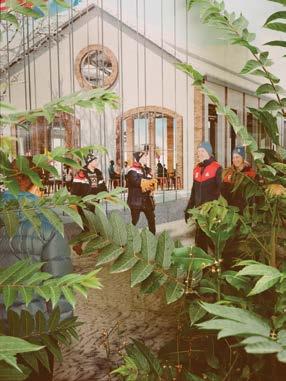

Railway wildlife is a visual investigation on the area of the former railway yard of Porta Romana, in Milan. It’s a surface of nearly 20 hectares, that remained half-abandoned for several years, during which a spontaneous renaturation project occurred. In fact, along the railway network, human
beings have unconsciously created a favourable environment for the proliferation of several species: the transportation of goods and seeds, the creation of soils without humus that are often rich of nutrients, have caused this area to become extremely varied, without the need for external treatments or resources. The railway yard is currently the
location of the works for the 2026 Winter Olympics and appears as a wild and inaccessible park, in contrast with the representations of the renders that surround the borders of the worksite. The project aims at being an invitation to dignify that wildness which, also in a figurative sense, struggles to find its own space and dignity within the logics of the city.
L’antico rito della transumanza nel
Molise si rinnova grazie a Valerio Berardo, 37, nato a Roma da genitori originari di Duronia (CB), che è tornato nella terra d’origine per dedicarsi alla pastorizia. Un allevatore e pastore che

ha scelto di dedicarsi alla zootecnia di resistenza e pratica la transumanza sui tratturi Celano-Foggia e Lucera-Castel di Sangro, partendo da Duronia verso i pascoli estivi di Capracotta. Il recupero delle tradizioni pastorali è fondamentale per il territorio. Contrariamente alle aspettative, la pastorizia sta attraendo sempre più giovani come Valerio, motivati a salvaguardare il territorio.
La transumanza è un’espressione comunitaria che crea legami indissolubili. Nonostante le difficoltà climatiche e i predatori, la determinazione dei pastori è incrollabile. L’amore per gli animali, il rispetto per la natura e la collaborazione tra le persone rendono la transumanza un simbolo di resilienza e armonia, cele brando la bellezza della vita rurale.


The ancient ritual of transhumance in Molise renovates itself thanks to the 37-year-old Valerio Berardo, who was born in Roma from parents from Duronia (CB) and returned to his homeland to dedicate himself to pastoralism. A breeder and shepherd who chose to dedicate himself to “resistance” zootechnics and carries out
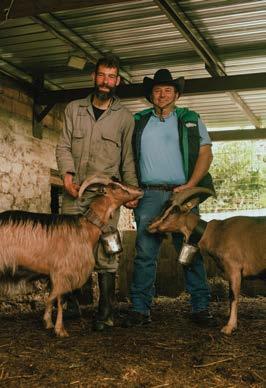

transhumance through the Celano-Foggia and Lucera-Castel di Sangro sheep tracks, departing from Duronia to the summer pastures of Capracotta.
The recovery of the pastoral traditions is essential for the territory. Contrarily to the expectations, pastoralism is attracting more and more young people, such as Valerio, who are motivated to protect the territory. Transhumance is
a community expression that creates indissoluble bonds.
Despite the climatic difficulties and predators, shepherds have an unshakable determination. Due to the love for animals, the respect for nature and the collaboration between people, transhumance becomes a symbol of resilience and harmony and celebrates the beauty of rural life.
Francesca Renzi
La topiaria è l’arte di scolpire alberi e arbusti. Antichissima, ha sempre avuto un ruolo fondamentale nella composizione dei giardini.
Dalla semplice siepe privata alle maestose regge e ville storiche, questa


pratica non è solamente esuberanza decorativa ma è anche progettazione accurata di un paesaggio verde.
Aiuta a creare profondità, prospettiva, accompagna lo sguardo verso i punti di interesse, costruisce percorsi e definisce lo spazio.
La vegetazione è modellata in chiave architettonica attraverso sculture tridimensionali. L’arte topiaria unisce botanica, architettura, arte, tecnica


Topiary is the art of sculpting trees and shrubs. It’s very old and has always played a key role in the composition of gardens.
From the simple private hedge to the majestic palaces and historical villas, this practice is not just decoration
e racconta tanto del nostro bisogno percettivo e del rapporto tra uomo e natura. È espressione dell’istinto primordiale di controllare la natura, nel tentativo estremo di addomesticare il selvatico ma allo stesso tempo è il desiderio di conviverci razionalmente. On topiary è una piccola selezione di forme semplici, props che riproducono l’essenza delle sculture vegetali.


exuberance, but also accurate planning of a green landscape. It helps to create depth, perspective, accompanies the gaze towards points of interest, builds paths and defines space. Vegetation is moulded in terms of architecture through three-dimensional sculptures. Topiary combines botany, architecture, art, technique and says a
lot about our perceptual need and the relationship between men and nature. It’s the expression of the primordial instinct to control nature, in the extreme attempt of domesticating wildlife, but at the same time it’s the desire to rationally live with it. On topiary is a small selection of simple forms, props that reproduce the essence of vegetal sculptures.
Ispirato dall’ ideologia del movimento fotografico “Nuovi Topografi” approccio l’area di Firenze e provincia
con l’intento di documentare con sguardo oggettivo e analitico il rapporto tra l’indole espansionistica del genere umano a scapito della natura. Paesaggi e scorci sono il soggetto secondario, ciò che è rappresentato nelle immagini è un processo di cambiamento avvenuto, che sta avvenendo o che inevitabilmente avverrà. Lo spunto di riflessione sorge quindi da una consapevolezza cruciale:
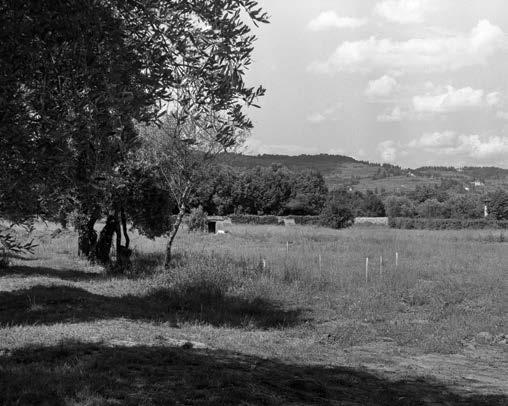

Inspired by the ideology of the photographic movement “Nuovi Topografi”, I approach the area of Florence and the province with the aim of documenting, with an objective and analytical gaze, the relationship between the expansionist nature of mankind to
osservando un paesaggio nell’era dell’ Antropocene, “immacolato” o già contaminato, siamo quasi certi che in futuro quella vista cambierà in modo definitivo sulla base delle azioni dell’essere umano. Uno dei motivi per cui fotografo è la paura di non registrare la realtà o un soggetto presente in un determinato momento del tempo, perdendo così la possibilità di conservare ciò che inevitabilmente subirà un alterazione definitiva.


the detriment of nature. Landscapes and glimpses are the secondary subject; what is represented in the images is a process of change that has occurred, that is occurring or will unavoidably occur. Therefore, the food for thought derives from a key awareness: by observing a landscape in the era of the Anthropocene, that is immaculate or
already contaminated, we are certain that such sight, in the future, will change for good based on the actions of human beings. One of the reasons why I photograph is the fear not to capture reality or a subject that is present in a given moment in time, and subsequently, to miss the opportunity to preserve what will unavoidably change for good.
Lo spazio pubblico non è neutrale e la sua interpretazione varia a seconda della prospettiva di chi lo vive o ne subisce l’influenza. Il progetto La Fauve di Matteo Orani esplora questa ambivalenza legandola al colonialismo francese, indagando le tracce storiche


La Fauve
di quel passato nel Jardin Zoologique de Marseille e i dettagli architettonici sparsi nei suoi dintorni.
Fondato nel XIX secolo, esso rifletteva l’espansione coloniale della Francia e attraverso l’esibizione delle specie esotiche presenti al suo interno forniva un potente strumento di propaganda nazionalistica per mostrare al pubblico il risultato delle politiche belliche

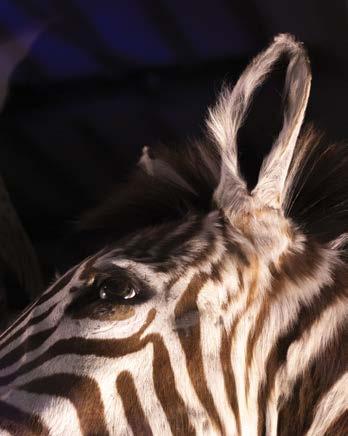
Public space is not neutral and its interpretation changes according to the perspective of those who live in it or are influenced by it. The “La Fauve” project, by Matteo Orani, explores this ambivalence and links it to the French colonialism, by investigating the historical traces of such past in the
condotte oltreoceano. Tenendo conto diqueste osservazioni, la serie ricerca visivamente la presenza di questi animali nello spazio pubblico marsigliese, presenti ancora oggi nei fregi architettonici dei palazzi, esposti nei musei di scienze naturali o riprodotti in copie a grandezza naturale, con l’obbiettivo di trovare in loro una catarsi collettiva.


Jardin Zoologique de Marseille and the architectonic details spread over the surrounding area.
Founded in the XIX century, it reflected the colonial expansion of France and, through the exhibition of the exotic species within it, it provided a powerful tool of nationalist propaganda, to show the audience the result of the war politics carried
out overseas. Keeping in mind these observations, the series visually searches for the presence of these animals in the public space of Marseille: they can be found still today in the architectural ornaments of building, exposed in the natural science museums or reproduced in full-scale copies, with the goal of finding in them a collective catharsis.
Il polo scientifico dell’università di Firenze a Sesto Fiorentino è una area che vive in una costante dualità. Da un lato gli enormi edifici che oscurano il panorama sono casa e sede dei laboratori per studenti e
ricercatori. Dall’altro le due oasi del Lago di Peretola e di Val di Rose, opportunamente celate dalla fitta vegetazione, ospitano e proteggono la flora e la fauna locali. Due realtà che si trovano a dover convivere nello spazio di poche centinaia di metri, e lo fanno guardandosi continuamente ma senza vedersi mai. Nell’assurdità di due mondi separati, vivendo però così vicini, l’intento di questo lavoro


The scientific pole of the University of Florence in Sesto Fiorentino is an area that lives a constant duality. On one side, the huge buildings that darken the landscape are the house and headquarters of the laboratories for students and researchers. On the other side, the two oases of the Lake of
è quello di svelare questa convivenza celata. Ecco che le strumentazioni del Dipartimento di Scienze e Tecnologie Agrarie (DAGRI) entrano veramente in dialogo con la flora circostante mentre l’avifauna locale spicca il volo in mezzo a laboratori ed aule. Finalmente degli spiragli si aprono nel velo che separa queste realtà, facendole diventare davvero l’una parte dell’altra.
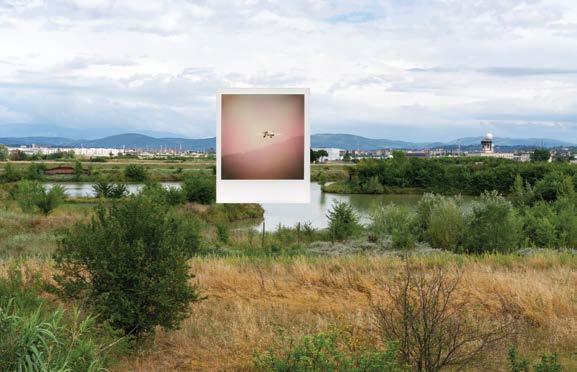
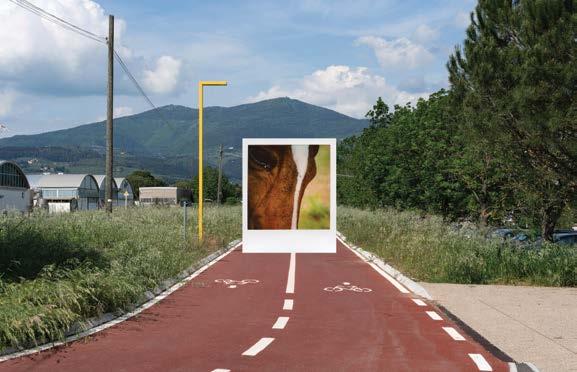
Peretola and Val Di Rose, conveniently hidden by the thick vegetation, host and protect the local wildlife. These are two realities that live together in the space a few hundred meters and do so by continuously looking at each other, without actually ever seeing each other. In the absurdity of two worlds which are apart, even if they live so close together, the aim of this work is
to disclose this cohabitation. That’s where the tools of the Department of Agricultural Science and Technology (DAGRI) create a dialogue with the surrounding flora, whereas the local avifauna takes flight amidst laboratories and classrooms. Finally, a few cracks open in the veil that separates these two realities, and they really become part of each other.
Il Delta del Po vive da sempre sulle sue stesse rovine. Gli abitanti e il territorio hanno subito alluvioni, dissesti idrogeologici e cambiamenti sostanziali della biodiversità. Guardando alle narrazioni di alcuni autori, dal documentario “Gente del Po” di Michelangelo Antonioni, ai racconti di Gianni Celati e Luigi Ghirri, fino al
recente film di Michele Vannucci, la visione del Delta del Po continua a mutare, eppure mantiene in sottofondo un sapore malinconico e complesso. La fragilità è il segno lasciato dal tempo sul territorio: per via del fenomeno della subsidenza il terreno, già sotto il livello del mare, si sta lentamente inabissando; per via della siccità il Po sta lasciando entrare l’acqua salata del mare all’interno dei rami di acqua dolce, compromettendo l’agricoltura; per via


The Po Delta has always lived on its own ruins. The inhabitants and the territory have experienced floods, hydrogeological instabilities and substantial changes of biodiversity. Looking at the narrations by few authors, from the documentary “Gente del Po” by Michelangelo Antonioni to the stories by Gianni Celati and Luigi Ghirri and the recent movie by Michele
cambiamento climatico la riproduzione incontrollata di specie invasive come il granchio blu modifica in modo sostanziale il mercato ittico locale. Il progetto La Risalita racconta la complessa resistenza degli abitanti del territorio, la convivenza tra specie, e il tentativo di fare di questo luogo la propria casa. Un sogno lucido fatto di frammenti di tempi vicini e lontani e di distanze visibili ma allo stesso tempo irraggiungibili.


Vannucci, the vision of the Po Delta continues to change but maintains, in the background, a melancholic and complex taste.
Fragility is the mark left by time throughout the territory. Due to the phenomenon of subsidence the soil, which is already below sea level, is slowly sinking; due to drought, the Po is letting the salty seawater enter the branches of freshwater, compromising agriculture: due to climate change, the uncontrolled
reproduction of invasive species, such as the blue crab, is substantially changing the local fish market.
The “La Risalita” project narrates the complex resistance of the inhabitants of the territory, the cohabitation between species and the attempt to turn this place into one’s own house. A lucid dream, made up of fragments of ancient and modern times and visible, but at the same time unreachable, distances.
“La soglia è uno spazio reale e metaforico, un’espressione figurata della spazialità, ma anche uno spazio concreto, materialmente inteso. Il riferimento è, in genere, alla soglia della porta, luogo di passaggio, ma anche di attesa, varco e zona in cui sostare.”
Obiettivo del progetto fotografico è quello di documentare un paesaggio che è di passaggio. Una soglia che è intesa in senso letterario ma anche metaforico. Architetture urbane e vedute naturali come portali per altri mondi. È un’ossessione che nasce dal fatto che noi oggi ci sentiamo su una soglia, sulla soglia dell’apocalisse climatica come sulla soglia tra fisico e virtuale. ”

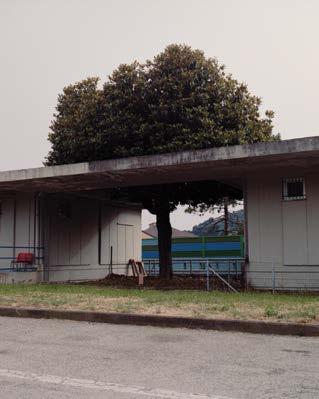
Non si tratta soltanto di evadere in un mondo fantastico […] quanto piuttosto di mettersi alla ricerca di nuovi strumenti per rapportarsi con una realtà che sembra non possedere più caratteri di stabilità e permanenza. Una realtà che fatichiamo sempre più a distinguere dalla finzione, che spesso nasce già finzionale, e che ci appare ogni giorno più incontrollabile”


“Threshold is a real and metaphorical space, a figurative expression of spatiality, but also a concrete, material space. Generally, reference is made to the door threshold, a crossing point, but also a waiting area, a gate and place in which to stop. This photographic project
aims at documenting a landscape in transition, a threshold that is intended both literally and metaphorically. Urban architectures and natural views as portals for other worlds. It’s an obsession that is due to the fact that, today, we feel like we are on a threshold: that of climatic apocalypse, but also that between physical and virtual.” It’s not just about escaping a
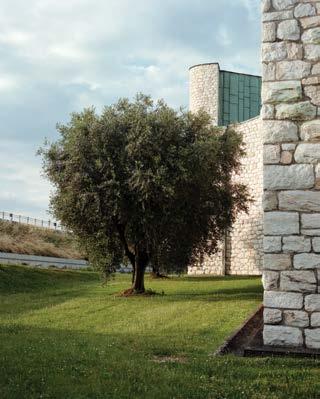
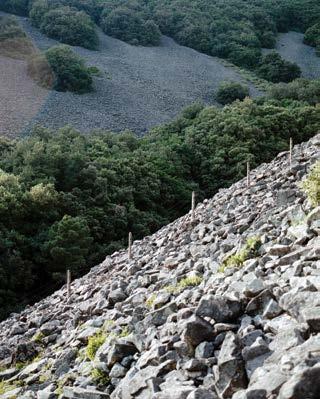
fantastic world […], but also looking for new tools to build a relationship with a reality that no longer seems to own characteristics of stability and permanence. We are increasingly struggling to distinguish such reality from fiction, because it’s often fictional itself and, every day, it looks more and more out of control to us.“

Qui puoi vedere l’archivio completo dei lavori fotografici realizzati
Here you can see the complete archive of photographic works created
What is the relationship between the territory and its inhabitants, nature, culture and the future of the planet? What are the narrations that can help us to understand the changes of landscape and the impact they have on our lives?
Visions on the territory is a project that was born from the synergy between Studio Marangoni, a photography school in Florence, and Giorgio Tesi Group, and fits consistently in a research work that sees the study of the man/nature relationship among the central topics of investigation, with the goal of creating research that is a testimony of the landscapes and territories, as well as the social and cultural dynamics that inhabit them. The project is led by Chiara Ruberti,
For over 30 years, Studio Marangoni Foundation, located in Florence, has been among the leaders in Italy and Europe in the formation and dissemination of photographic culture. Since its onsets, it has always developed, in parallel with an educational offer that combines artistic and commercial photography, collateral activities in the field of cultural production and dissemination, by creating an open dialogue with the territory and involving both important international names and local partners.
Chiara Ruberti graduated in Art History in 2007. From 2008 to 2014, she worked for the Alinari Foundation (Florence), first as an assistant to the scientific
The nine selected artists, photographed in front of the “Mind Garden” within the Giorgio Tesi Group nurseries in Pistoia. I nove artisti selezionati fotografati davanti al “Giardino della Mente” all’interno dei vivai Giorgio Tesi Group di Pistoia.

a professor and curator, and has seen the involvement of 12 young Italian photographers selected through an open call. The goal is to activate a creative journey of debate and research, with which you can enhance the importance of a collective gaze, that is capable of representing a testimony of belonging and identity.
Archive/document, natural/artificial, memory/future, control/possibility, vision/investigation. These are some of the recurring elements in the different researches which, with
director for exhibitions and then as a coordinator of editorial projects. In 2014, she attended a course for curators of contemporary photography at Fondazione Fotografia (Modena) and started her collaboration with Photolux Festival in Lucca, of which she was the coordinator, co-director and with which she currently collaborates as curator. Since 2019, she has collaborated with Studio Marangoni Foundation as a tutor and, since 2022, she’s been a professor and coordinator at the Photography Department of Accademia Italiana (Florence). As an independent curator, she collaborates with photographers, institutions and spaced dedicated to photography and contemporary art in Italy and abroad.
authorial approaches that are often multidisciplinary, invite the observers to reconsider what they see in the images and daily landscape around them. Therefore, photography turns into an essential tool to reveal the unexpected short circuits of the real and the imaginary. The result is a brandnew geography which, starting from the sensitivity and vision of any author, intersects different levels of reading and interpretation.
The questions linked to sustainability and the consequences of the changes made by man to the landscape are at the core of the work by Elsa Pizzuto, Leonardo Bocci and Marco Lumini; Barbara Leolini, Claudia Mann and Matteo Orani investigated the memory of places, where traces of the past intertwine with the potential stories of the present; instead, Gabriele Fossi, Marco Farmalli and Francesca Renzi built a personal and visionary cartography.
Therefore, landscapes are similar to texts – quoting Serenella Iovino – because “through them we can read the stories of social relations and power relations, biological balances and imbalances and the concrete shaping of spaces, territories, human and non-human life”. The nine selected works will be presented on the occasion of two important festivals: Another Park in the City in Pistoia and Photolux in Lucca.


A Maggio l’azienda pistoiese Gi.Metal ha partecipato a Bakery China, il principale evento dell’Asia Pacifica dedicato al cibo e alla panetteria. Presente sul mercato dal 1986, Gi.Metal è leader nel settore delle pale e degli utensili per pizza.
A Shanghai ha portato l’esperienza della pizza italiana a 360° insieme alla collettiva The Traditional Italian Pizza Initiative, comprendente altre 4 aziende italiane con mercati internazionali e 3 scuole di eccellenza.
Le realtà coinvolte nel progetto sono: Le 5 Stagioni (farine), La Valle (polpa di pomodoro), Gioiella (latticini),
SudForni (forni), la Scuola Italiana Pizzaioli, AVPN e l’Università di Scienze Gastronomiche di Pollenzo. Partecipando a Bakery China, Gi.Metal ha espresso in modo concreto il suo impegno per dare valore al Made in Italy e alla sua internazionalizzazione.
Il sostegno alle PMI italiane del settore food che vogliono conquistare nuovi mercati è stato infatti il tema al centro di un recente confronto presso la sede dell’azienda, a cui hanno partecipato anche CNA Toscana Centro e il Senatore La Pietra, Sottosegretario del MASAF.



In May, the company Gi. Metal from Pistoia attended Bakery China, the main event in Asia–Pacific dedicated to food and bakery. Gi. Metal has been on the market since 1986, and is a leader in the field of blades and utensils for pizza. The company brought to Shanghai its all-round experience in the field of Italian pizza, along with the collective The Traditional Italian Pizza Initiative, which includes 4 Italian companies with international markets and 3 schools of excellence. The realities involved in the project are: Le 5 Stagioni (flours), La Valle (tomato pulp), Gioiella (dairy products), SudForni (ovens), the Italian
School of Pizza Makers, AVPN and the University of Gastronomic Sciences of Pollenzo. By attending Bakery China, Gi. Metal concretely expressed its commitment to give value to the Made in Italy and its internationalization.
In fact, the support to the Italian small and medium-sized enterprises in the food industry that wish to conquer new markets was at the heart of a recent debate at the company’s headquarters, attended also by CNA Toscana Centro and senator La Pietra, undersecretary for the Ministry of Agriculture, Food Sovereignty and Forests.




R e e V o M S P è l a p r i m a e u n i c a f a b b r i c a p e r g l i M S P
I l p a r t n e r n e c e s s a r i o p e r i M a n a g e d S e r v i c e P r o v i d e r : k n o w h o w , t o p t e c h n o l o g y e
l ' a f f i d a b i l i t à m a d e i n R e e V o p e r o f f r i r e p a c c h e t t i d i s e r v i z i g e s t i t i a s s o l u t a m e n t e
p e r s o n a l i z z a b i l i e b r a n d i z z a b i l i .
G r a z i e a l l ' e s p e r i e n z a v e n t e n n a l e n e l c a m p o d e l l a g e s t i o n e p r o a t t i v a
d e l l ' i n f r a s t r u t t u r a I C T , h a m a t u r a t o u n a c o n o s c e n z a a p p r o f o n d i t a d e l l e e s i g e n z e r e a l i
d e g l i M S P e d è i n g r a d o d i o f f r i r e s t a n d a r d s e n z a e g u a l i s i a s o t t o i l p r o f i l o d e l l a
t e c n o l o g i a , s i a p e r i l s u p p o r t o g l o b a l e a l l o s v i l u p p o d e l b u s i n e s s
R i s p o n d e r e a l l ' e v o l u z i o n e è l o s p e c i f i c o d i R e e V o M S P , p e r q u e s t o i M a n a g e d S e r v i c e
P r o v i d e r p o s s o n o f a r e a f f i d a m e n t o s u u n l i v e l l o t e c n o l o g i c o i n a g g i o r n a m e n t o
c o s t a n t e .
G r a z i e a l l a f o r z a d i u n b r a n d c o m e R e e V o , t u t t o q u e s t o , c o m p r e s i i s e r v i z i d i C l o u d ,
H y b r i d C l o u d e C y b e r s e c u r i t y , è a l l a p o r t a t a a n c h e d e i p i c c o l i M S P c o n l i m i t a t e c a p a c i t à
d i i n v e s t i m e n t o .
R M M :
D e s k t o p , S e r v e r , M o b i l e ,
M i s s i o n C o n t r o l
M u l t i C l o u d

M i s s i o n C o n t r o l

I N D I R I Z Z O S E D E P R I N C I P A L E e O P E R A T I V A :
V i a M a r c o P o l o , 7 2 - 5 6 0 3 1 B i e n t i n a ( P I )
R E C A P I T I E S I T O W E B :
M a i l : i n f o @ r e e v o m s p i t T e l : + 3 9 0 5 8 7 7 5 5 1 1
S i t o w e b : h t t p : / / w w w . r e e v o m s p . i t
C y b e r s e c u r i t y
M i s s i o n C o n t r o l
D e s k t o p A s a S e r v i c e
M i s s i o n C o n t r o l


Immagini dell’Ottocento e Novecento
— Un volume fotografico di grandi dimensioni (34 x 24 cm) di 410 pagine che contiene oltre 160 foto inedite, in gran parte in bianco e nero, tutte dedicate a edifici, monumenti, documenti e momenti di vita dei pistoiesi. Le immagini sono tratte dall’archivio fotografico del collezionista Giovanni Innocenti che le ha gentilmente messe a disposizione e provengono dall’Archivio Giannino Giannini che Innocenti ha salvato alcuni anni fa dalla dispersione.

Il volume nasce da un’idea dello stesso Innocenti e di Giampiero Tommasi, è stato curato dall’Associazione Storia e città, che ha contribuito con il lavoro volontario dei propri iscritti e collaboratori, e l’introito delle vendite è devoluto alla “Fondazione Radioterapia Oncologica” di Pistoia rappresentata da Tommasi. Si apre con la prefazione di Daniele Negri sul ruolo storico e sociale della fotografia in rapporto anche con la pittura cui si affianca a partire dalla seconda metà dell’Ottocento per descrivere la realtà e immortalare personaggi e panorami, seguita da un contributo di Giampaolo Perugi dal titolo Giannino Giannini fotografo in cui traccia una biografia del Giannini definendolo “personaggio di primo piano nella vita amministrativa, culturale, economica e sportiva della città”.

Avvocato e giornalista ma anche e soprattutto imprenditore, politico e amministratore comunale si occupò di numerose iniziative per lo sviluppo della città e del territorio. Alberto Cipriani firma una corposa Introduzione, preceduta da un ricordo di famiglia a lui dedicato dai figli, in cui riassume e commenta gli anni pistoiesi che vanno “fra l’ultima parte dell’Ottocento e la Seconda guerra mondiale” quando “Pistoia conobbe numerosi bombardamenti aerei alleati, le feroci attuazioni delle leggi antiebraiche e le esecuzioni fasciste e naziste contro resistenti e inerti”. Il volume prosegue poi con i contributi compilati dai vari autori che, in base alle loro competenze, presentano le foto facendole precedere da un testo di commento generale.

Gli argomenti sono stati suddivisi in due capitoli intitolati Lo scenario urbano e La società Lo scenario urbano: Giampaolo Perugi, La Città, trentacinque foto in gran parte dedicate a uomini, donne, bambini e bambine della buona borghesia a passeggio nelle strade e nel centro della città che vede “il continuo ricambio dei negozi”.
Patrizio Turi, La piazza del duomo e l’abside di Santa Maria Nuova, tredici foto sulla principale piazza cittadina animata dal mercato e da manifestazioni varie e inoltre Turi dedica un’attenzione particolare alle mensole dell’abside di Santa Maria Nuova con le teste aggettanti e iscrizioni che in gran parte “non sono più leggibili per effetto degli agenti atmosferici e dell’inquinamento”.
Claudio Gori, Il monumento a Garibaldi, quattordici documenti e immagini dedicati al monumento cittadino collocato nel 1904 nella piazza San Domenico che documentano tutte le fasi della vicenda fino ai momenti principali della cerimonia d’inaugurazione.
Alfonso Venturini, Il ventennio fascista, quattordici immagini con le rituali foto di gruppo della milizia e le varie manifestazioni del regime nelle vie e nelle piazze cittadine compreso l’allestimento della città in occasione della visita di Mussolini il 16 maggio 1930.
Gianluca Chelucci, L’inaugurazione del palazzo della Cassa di Risparmio, dieci foto. La partecipazione di autorità e popolo per festeggiare il nuovo palazzo della Cassa che
Un meraviglioso volume che racconta con testi e suggestive immagini d’epoca la storia della città di Pistoia. L’introito delle vendite del libro è interamente devoluto alla Fondazione Radioterapia Oncologica.
A wonderful volume that narrates, with text and suggestive vintage images, the story of the city of Pistoia. The proceeds of the sales were fully devolved to the “Oncology Radiotherapy Foundation”.


ha ridisegnato l’urbanistica del centro cittadino con lo “sventramento dell’antico quartiere di San Matteo”, compresa una rara immagine con doppia esposizione.
La società: Andrea Ottanelli, Lo sport, trentadue foto dedicate agli atleti della società Libertas, al tiro al piccione e, in gran parte, all’evento mondano delle corse nell’ippodromo allestito nel Campo Marzio fino all’inizio del XX secolo.
Stefania Nerucci, Il cinema e il teatro, venti immagini di manifesti, locandine attori e attrici, annunci pubblicitari e di esterni e interni delle sale cinematografiche Eden, Modernissimo e Globo e del teatro Manzoni.
Francesca Rafanelli, Il Carnevale, dodici foto di locandine, manifesti e dei carri allestiti per il Carnevale nelle vie cittadine con le maschere e un grande concorso di pubblico assiepato che riempie ogni spazio a disposizione.
Claudio Rosati, I festeggiamenti undici foto che riproducono i “baracconi” e le giostre allestiti in piazza San Francesco, con il salone del Cinematografo Gigante, e la tombola sul Globo, una piazza gremita di pistoiesi che partecipano collettivamente all’estrazione dei numeri. Da notare alcune rare foto

stereoscopiche che osservate con un apposito strumento danno “l’illusione della profondità”.
Un libro iconografico che presenta un quadro pressoché completo della vita quotidiana dei pistoiesi tra gli ultimi decenni dell’Ottocento e la prima metà del XX secolo.
Il coordinamento generale del progetto è stato curato da Andrea Ottanelli, l’editing da Daniele Negri, la riproduzione fotografica da Lineashow e Sandro Nerucci, il progetto grafico da Giulia Ercolini e la stampa è avvenuta presso la tipografia Nuova Fag 2024.
Il volume è stato presentato il 7 giugno nel saloncino della musica nel Palazzo de’ Rossi sede della Fondazione Caript.







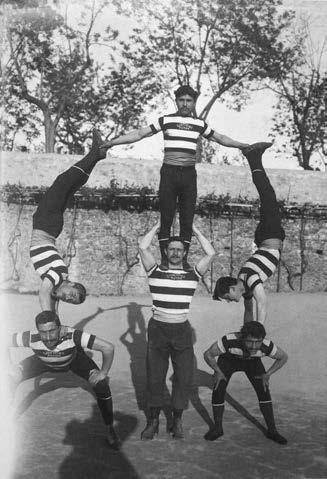
Gli argomenti trattati in questo libro dagli iscritti e collaboratori dell’Associazione Storia e Città sono edifici, monumenti, documenti e tanti momenti di vita dei pistoiesi. Le immagini sono tratte dall’archivio fotografico del collezionista Giovanni Innocenti che le ha gentilmente messe a disposizione e provengono dall’Archivio Giannino Giannini
The topics dealt with in this book by the members and partners of the “Storia and Città” Association are buildings, monuments, documents and several moments in the life of the people from Pistoia. The images are taken from the photographic archive of the collector Giovanni Innocenti, who kindly made them available, and come from the Giannino Giannini Archive
A large-size, 410-page photographic volume (34 x 24 cm), which includes over 160 unpublished photos, mostly black and white. All of them are dedicated to buildings, monuments, documents and moments of life of people from Pistoia. The images are taken from the photographic archive of the collector Giovanni Innocenti, who kindly made them available, and come from the Giannino Giannini Archive, that was saved from dispersion a few years ago by Innocenti.
The volume was born from an idea of Innocenti himself and Giampiero Tommasi and was curated by the Storia e città Association, which contributed with the voluntary work of its members and collaborators; the proceeds of the sales were devolved to the “Oncology Radiotherapy Foundation” in Pistoia, represented by Tommasi.
The volume starts with an introduction by Daniele Negri on the historic and social role of photography, also in relation to painting. The latter was joined by photography starting from the second half of the XIX century, to describe reality and immortalize characters and landscapes.
The introduction is followed by a contribution of Giampaolo Perugi, whose title is Giannino Giannini fotografo, where the author traces a biography of Giannini and defines him as a “leading figure in the administrative, cultural, economic and sporting life of the city”. A lawyer and journalist, but above all an entrepreneur, politician and municipal administrator, he was in charge of several initiatives to develop the city and the territory. Alberto Cipriani is the author of a rich introduction, preceded by a family memory dedicated to him by his sons, where he summarizes and comments on the Pistoiese years ranging “from the last part of the XIX

century until World War II”, when “Pistoia experienced several aerial bombings by the Allies, the cruel implementation of the anti-Jewish legislation and the Fascist and Nazi execution against the resistant and inert people”.
The volume continues with the contributions by several authors who, based on their skills, commented on the pictures, which are preceded by a general text commentary.
The topics were divided into two chapters, whose title is The urban scenario and The society.
The urban scenario: Giampaolo Perugi, The city. 35 photographs, mostly dedicated to men, women and children from the upper-middle class, walking through the streets and the city centre, with a “constant turnover of shops”.
Patrizio Turi, Piazza del Duomo and
the apse of Santa Maria Nuova. 13 photographs that portray the main city square, animated by the market and different events. Furthermore, Turi pays specific attention to the shelves of the apse of Santa Maria Nuova, with the protruding heads and inscriptions that, for the most part, “are no longer readable due to the effect of atmospheric agents and pollution”.
Claudio Gori, The monument to Garibaldi. 14 documents and images dedicated to this city monument, placed in 1904 in Piazza San Domenico, which document all the stages of this story, up to the main moments of the opening ceremony.
Alfonso Venturini, The twenty years of Fascism. 14 images with the ritual group photographs of the militia and the different events hosted by the regime in
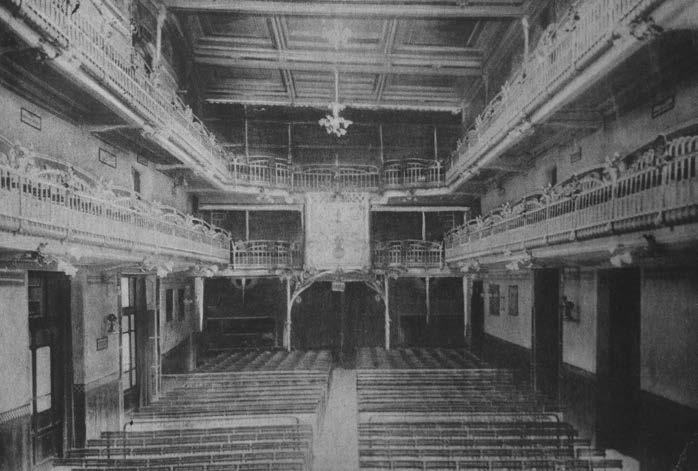
the streets of the city squares, including the staging of the city on the occasion of Mussolini’s visit, on May 16th, 1930. Gianluca Chelucci. The opening of the building of the Cassa di Risparmio, 10 pictures. The authorities and the population took part in the celebrations for the new building of the Cassa di Risparmio, which redefined the urban planning of the city centre with the “disembowelment of the ancient neighbourhood of San Matteo”, including a rare image of the dual exhibition.
The society: Andrea Ottanelli, Sport. 32 pictures dedicated to the athletes from the club Libertas, to pigeon shooting and, mostly, to the mundane event of races at the hippodrome set in Piazza d’Armi, until early XX century.
Stefania Nerucci, Cinema and theatre. 20 images of posters, flyers of actors and actresses, advertisements and outdoor and indoor parts of the movie theatres Eden, Modernissimo and Globo and the Manzoni Theatre.
Francesca Rafanelli, Carnival. 12 photographs of flyers, posters and the allegorical floats set up for the Carnival in the streets of the city, with masks and a large crowd of people packed together, filling any available space.
Claudio Rosati, Celebrations. 11 photographs reproducing the “marquees” and the carousels set up in Piazza San Francesco, with the Giant
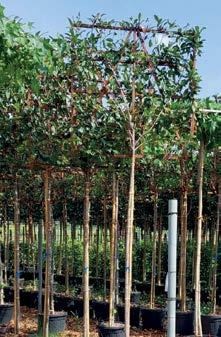


Cinematograph hall, and the raffle in the Globo area: a square crowded with people from Pistoia, who participate collectively in the draw of numbers. A few stereoscopic pictures, which give “the illusion of depth”, should be noticed.
An iconographic book, which shows an almost complete picture of the daily life of Pistoiese people between the last decades of the XIX century and the first half of the XX century.
The general coordination of the project

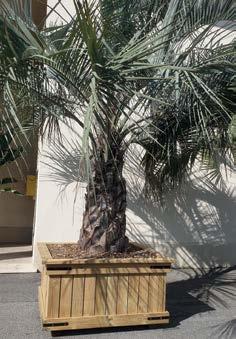
was curated by Andrea Ottanelli, whereas Daniele Negri was in charge of the editing; the photographic reproduction was curated by Lineashow and Sandro Nerucci, whereas the graphic project was curated by Giulia Ercolini and printing took place at the printing press Nuova Fag 2024. The volume was presented on June 7th, in the music hall of Palazzo de’ Rossi, the headquarters of the Caript Foundation.
Un’opera iconografica che presenta un quadro pressoché completo della vita quotidiana dei pistoiesi tra gli ultimi decenni dell’Ottocento e la prima metà del XX secolo.
An iconographic work which shows a nearly full picture of the daily life of people from Pistoia, between the last decades of the XIX century and the first half of the XX century.

